Rapid Transformation System – Workshop 1 (Digital Transformation Concepts)

The Appleton Greene Corporate Training Program (CTP) for Rapid Transformation System is provided by Ms. Jacewicz Certified Learning Provider (CLP). Program Specifications: Monthly cost USD$2,500.00; Monthly Workshops 6 hours; Monthly Support 4 hours; Program Duration 12 months; Program orders subject to ongoing availability.
If you would like to view the Client Information Hub (CIH) for this program, please Click Here
Learning Provider Profile

Ms.Jacewicz is a Certified Learning Provider (CLP) at Appleton Greene and has experience in digital transformation in strategic asset management, design of operating models and finance. Ms.Jacewicz is also designer and an architect who leverages ISO55000 family of standards to develop business specific solutions that enable fixed asset owners to integrate technology and therefore adapt their operating models and therefore the organisational direction of travel to changes in the global markets.
Ms.Jacewicz has achieved multiple master’s degrees in following disciplines: Industrial Design & Prototyping, RIBA Part 2 & Associate of Royal Institute of British Architects, IAM Diploma & Member of Institute of Asset Management. Gosha is also a technical author for British Standard 8536; Design, manufacturing, and construction for operability: Code of practice for infrastructure and facilities management aiming to maximise assets operability, maintainability, reliability, and performance to deliver Net Zero targets. Ms.Jacewicz has industry experience in the United Kingdom and European legislative environment in following sectors: real estate, construction, transport and logistics, mining, oil, and gas.
With a demonstrable track record of integrating digital technologies such as BIM, IoT, Digital Twin or data analytics into operational environment, Ms.Jacewicz supports clients in establishing new ways of working that drive forward technology driven innovation in organisational design.
MOST Analysis
Mission Statement
The purpose of Rapid Transformation Systems (RTS) and this programme is to enable clients to effectively transition and adapt their business operating models to meet the requirements of the new market regime. This new reality we are finding ourselves in demands a clear answer and a hand break turn on the direction of travel.
The RTS methodology has been developed to introduce strategic and rapid transformation of business operating models and business processes. By focusing on integration of technology from the baseline position and the design of the future state, RTS allows organisations to adapt to dramatically different circumstances. Many of the things that we are facing now would have been unthinkable even months ago. The world has changed again and there is no going back. As the only way is forward, RTS aims to give your digital transformation efforts a meaning and purpose that are deeply significant to the organisation. Utilising system thinking and neuroscience approch to learning, these hands-on programme gives your organisation the opportunity to truly re-define the future it desires by inventing it.
As the same time RTS has been developed based on the neuroscience research and deep understanding of human factors to activate in the client team the ability to start rapidly adapting and re-think concepts through the power of unparalleled storytelling.
With focus on integrating innovative technologies into business-as-usual, RTS aim is to support as many businesses as possible to make our world safe and secure again by re-inventing it. By creating with clients ground-breaking fit for the 21st century operating models, by tapping into organisations potential to develop products and services that are more sustainable, diverse and make a positive impact in communities where we live and work RTS aim is to inspire people in the organisation and around the globe to follow their path and to help businesses to thrive by enabling teams to work together closely and effortlessly with the aid of data, information, knowledge and wisdom.
The key objective of RTS is to facilitate organisations to make the transition to the new market regime possible. To secure safe and profitable operations and enables customers and organisations to thrive in the 21st century by becoming sustainable, managing their environmental impact, and contributing to the overall global stability.
The objective of the first workshop in this hands-on training is for the team to gain information and understanding of key components of RTS and aspects of the human factors. This knowledge is required to rapidly build capacity for transformational level of change. In practice, this means that using RTS five key steps will provide the overall Road Map to extraordinary benefits realisation. Building trust, enabling teamwork, stimulating innovation, creating new understanding of value, and managing complexity to achieve it are only few outcomes delivered by stimulating through course manuals and exercises growth of new neural networks in the brain to build capacity, not only for process change but also our own emotional transformation of believes and values.
Objectives
01. Present and review the client Project Brief.
02. Build understanding of key concept of digital transformation.
03. Establish context and purpose for different operating models.
04. Identify factors that influence operating models over time.
05. Apply system thinking to structure operating model components.
06. Develop understanding of different change management models.
07. Map out key stakeholders’ roles and responsibilities.
08. Formulate a high-level plan to communication with all stakeholders involved.
09. Develop 12-months project Road Map using RTS building blocks.
10. Obtain data and information to inform baseline assessment.
Strategies
Introduction: Several theories have been developed about how people learn. Because the objectives of RTS is to enable adaptation of human believes and concepts to the changing context of the new market regime a cognitive and neurobiological approch have influenced the learning theory and application of strategies and methods applied in this program.
According to cognitive theory of learning, thought processes depends on the ability to create, hold, and modify internal representations of concepts that are experienced in the training environment. These internal representations form our perception of the world and the concepts that come with it. Therefore, learning through hands-on exercises, provision of clear instructions and templates throughout the whole program are designed to challenge in a meaningful way organisational current position.
A crucial aspect of this model is the emphasis on what the learner already knows and identifying individual areas of learning required. It emphasises how active the leaner must be if restructuring current thinking. This is because frequently, organisations and individuals find that their ability to handle a new experience with existing concepts definitions simply does not work, yet they resist changes to their way of thinking. For example, the learner may simply choose to ignore information or deny need for change. Only when genuine cognitive transformation takes place in the process of “re-doing” the concepts one can say learning has been regarded as having taken place. This process often requires a neurobiological recognition that relates behaviour to the electrical and chemical events taking place inside the body. It emphasises the need to understand activities within the brain and nervous system, together their effect upon behavioural and mental processes and the overall human factors of “how do we feel” about the change including channels of communication and processing of information. The fact is that human brain has an almost infinite capacity to learn, and it means that everyone can create and grow rapidly their potential. Given enough time and the right opportunities, everyone can learn anything.
• Present and review the client Project Brief
The first preliminary tasks you will do as a an individual and as a team later is to define high level project scope. The focus of the scope should be on outlining what individuals and the team wish to achieve for the benefit of the organisation. Focusing on the outcomes and thinking with the end goal in mind means that the emphasis of the documents that you are required to produce is on the output first. By drafting individual project scopes, we aim to gather the diverse understanding of the project requirements that will be discussed and consolidated as a team.
• Build understanding of key concept of digital transformation
RTS course manuals and exercises provide not only a guidance how to design and integrate digital transformation but also offer templates and instructions on how to tackle the theory and implementation of desired technology. By following the instructions provided in the course materials participant will gain knowledge and understanding of the subject matter and will have the opportunity to put theory into practice.
• Establish context and purpose for different operating models.
RTS is hands-on programme based on rapid integration of digital transformation theory and concepts through application of practical exercises aiming to help participants to try out application of theory themselves by building real-life scenarios.
• Identify factors that influence operating models over time.
The RTS cognitive approch to learning is to provide the participants with toolkits and templates that enable them to structure their project from the outset and use the practical exercises to instigate neurobiological level of change by identifying “how do we feel” about the context of our times and how can organisations move forward in a positive and constructive way.
• Apply system thinking to structure operating model components.
All modules of RTS are aligned in a sequence that address in a specific order; human factor, assessment, prototyping the Target Operating Model and delivering the programme of benefits. The system thinking theory in this context is a strategy to capture and break down complexity of the operating model in the context of the changing environment and markets. Using fish bone diagrams and problem-solving methodologies as well as black box and scenario analysis exercises, we give the team the skills to break down complexity into manageable components.
• Develop understanding of different change management models.
Decision support tools and transformation delivery templates have not been developed specifically for this program to aid the neurobiological issues of human brain inability of dealing with unknown. This phenomenon is called “experiential blindness”. A wide range of templates, process maps, step by step instructions, “TO DO” lists, and techniques have been pre-developed to get the team started and to support and weight complex decisions required to facilitate participation processes and keep everyone on the same page.
• Map out key stakeholders’ roles and responsibilities.
Every project that takes place over time involves number of stakeholders and characters. The characters generate the plot through their interactions, motivation, and personalities. By creating stakeholders’ profiles and a stakeholder’s chart, the team will be able to choose most appropriate change management model for the job and understand how the stakeholders operate in daily negotiations when all these people meet at the table to negotiate by being faced by different aspects of the same problem or how they all would solve problems through building trust and collaboration. It is only in the “doing” when we truly redefine our thinking and create options and scenarios of the future we desire. This program aims to be a discovery and experimentation journey that we hope the Project team will enjoy whilst learning new skills and methodologies. That way we can track the relationships and roles changing along the journey among the team members and how the workload can be distributed. All the things you need to know about their background, character, personality and what they like for breakfast you can keep on the profile. That way everyone can keep eye and have a control of the human factors via this handy chart.
• Formulate a high-level plan to communication with all stakeholders involved.
The Rapid Transformation System is a mechanism that contextualises the whole interconnecting network of outcome driven activities to solve problems presenting themselves during the business transformation. It offers a coherent and logical base for merging process with human factors related to workforce needs for vision, storytelling, engagement, beliefs, values and above all need for safety and security. The Project team during these phases will be creating, prototyping, designing, brainstorming, analysing, and making decisions about outcomes, scope, control metrics, concept definitions and other techniques of breaking down complexity to help stakeholders re-think the “AS IS” baseline position and to address the human factors.
• Develop 12-months project Road Map using RTS building blocks.
The overall objective of the five RTS themes (assess, re-think and re-design, test & integrate, stabilize, realise benefits) that spread around the 12 modules is to ensure that the organisation goes through the whole digital transformation programme in the correct sequence driven by the cognitive and neuroscience approch to learning. There will be no need to reinvent the wheel or spend time on creating templates during the program. Utilising the pre-defined toolkits of the digital transformation management system we will focus the team purely on the design and implementation of their desired solution.
• Obtain data and information to inform baseline assessment.
A baseline assessment can take many different forms but is essentially a means of collecting information about a starting position to inform development or attainment at the point at which the organisation enters the RTS program. Assessments are carried out in a variety of different ways from informal observations to standardised questionnaires or desktop exercises. The data collected from these assessments will inform the timescales for the implementation of the desired technological solution. Like previous exercises, the strategy is to get the team started with the pre-prepared asset management industry best practice assessment that can be tailored to the specific needs of the client.
Tasks
List at least 1 task for each strategy listed above. Your tasks should explain precisely what you will need to do in order to ensure that each strategy is implemented.
01. Complete each Course Manual exercise.
02. Complete each Project Study TO DO list.
03. Appoint Project Lead with administrative support.
04. Identify project sponsor.
05. Set up a team share drive and folder for each module.
06. Schedule regular team meeting following workshops.
07. Develop 12-month Road Map and stakeholders’ communication plan from the outset.
08. Ensure team has a minimum of the following software: Teams/zoom, Microsoft project or any other software that allows mapping of project dependencies. Word, excel, power point and Visio or any other software with visualisation and process mapping capability.
09. Focus on applying theory into practice.
10. Practice, practice, practice.
Introduction
Digital transformation is one of the megatrends shaping the global technological landscape and although it has been a buzzword since 1990s and in the mid-2000s, it has taken prominence in reshaping global economic landscape over the last decade. The trend started over the last 30 years when organisations initiated computerized procedures and to some extent already integrated many automated processes into their day-to-day operations.
Since the 1990s it has been the expectation that hardware and software will provide insights into organisational performance, efficiency, optimise expenditure, and track compliance via global dashboards in real time. With such a significant need for information many organisations grown organically, bottom up, and added technology to current “AS IS” ways of working. This has created a further need for significant process improvement. All these activities however have not fully delivered to the market expectations. The reality and the results are slightly different, 80% digital transformations efforts still fail.
The route cause is three-fold. Digital Transformation in reality, combines three significant concepts of the corporate businesses journey.
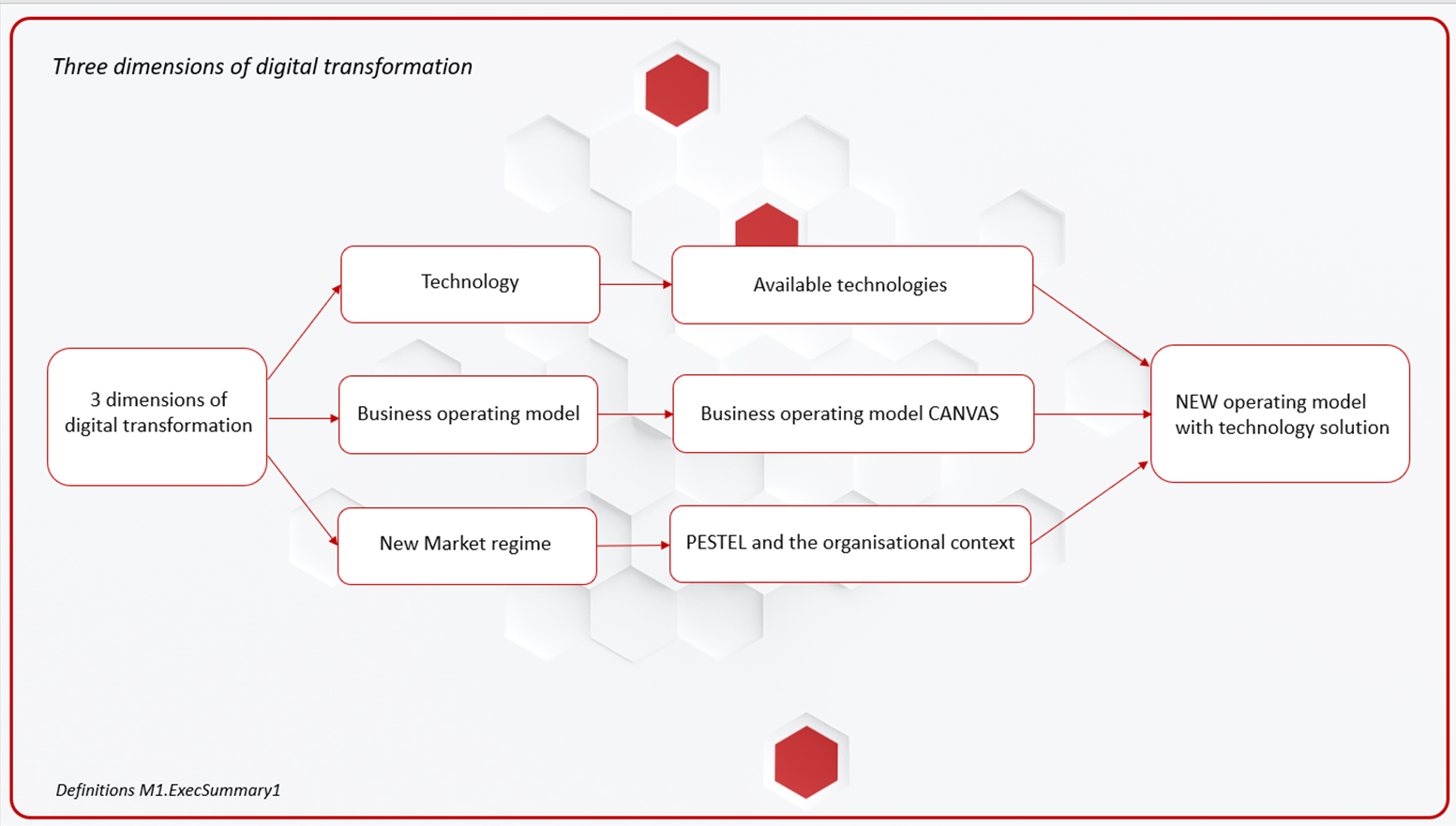
The first, we know a lot about. It`s technology. The second is at its infancy and relates to the definition and concepts of the business operating models, in this document also referred to as “AS WAS”, “AS IS” and “TO BE” Operating Model, reflecting PAST, PRESENT and FUTURE states of the organisation. The third fundamental element of Digital Transformation is the post-covid paradigm shift and the emergence of the new market regime. This global megatrend driving the re-thinking of the fundamentals of human relationship with the planet also provides new perspectives on how we will live in the not far distant future and how the net-zero objectives will drive human behaviour and adaptation of almost 8 billion people.
This threefold structure creates a new juxtaposition for the corporate organisations to address. On one hand technology is easy to implement into a current status quo, however integrating it into a not yet designed and developed target operating model that needs to deliver net-zero, customer real time engagement and flexibility to adapt to changes in the market is a tricky business.
This creates a need for significant transformation, not only of the current processes using technology but of the whole operating model to achieve net-zero, value and growth supported by technology in the new market regime at the same time considering the environmental impact.
This is a very different concept for many organisations that require innovative methodology such as Rapid Transformation System enabling them to capture multiple strands of activities and their relationships at the same time leading towards multiple outcomes and scenarios. The importance of understanding all three conceptual components and the application of them in an operational delivery environment combined with ability to respond to the new market regime will drive far more experimental way of working, re-thinking basic concepts and prototyping multiple solutions of digital transformation.

Technology
Relatively short history of DIGITAL TRANSFORMATION is a popular topic of discussion since the 1990s and 2000s for organisations aiming to enhance digital products and services.
For example, in the rail industry providing on-line sales of tickets were considered important digital channels with which to reach customers even though purchases were still primarily made inside brick-and-mortar train station windows, often with cash.
From 2000 to 2015, the rise of smart devices and social media platforms led to a drastic landscape change in the methods customers were able to communicate and be updated by the businesses. The customers’ expectations have focused on the areas of service that impacted them mostly like delays, cancellations, service disruption etc. This level of communication meant organisations had to provide response times and multi-channel availability and communication platforms that linked with assets and their performance.
As a result, businesses started to see that they were able to communicate digitally with their customers on an individual basis, and often in real time. Selection of digital payment options such as PayPal also contributed to more and more online commerce and web-based opportunities from selling data and information related products that use the potential of digitisation to offer customers smarter and faster services and actively shape their business operating models with digital transformation.

Business operating models
The history of business and operating models goes back to the growth of e-business since the rise of the Internet during the late 1990’s. Early reviews of the business operating model concept emerge around the dot.com era and the rise of the e-business model. Since then, the definition of a business operating model had not moved much forward, and it is still described as “stories that explain how enterprises work”. Business operating models’ function was to show how the organisation added value and how much efforts it took operationally to generate value and profits but also answered fundamental questions such as: “who is the customer? and “what does the customer value?” or “how do we extract value in that process?”.
Precisely this aspect of value seen from the point of the customer made a big impact on the existing thinking. Further, a basic idea of the business model concept was that it should spell out the unique value proposition of the Organisation and how such a value proposition ought to be implemented by designing appropriate operating model that aligned all business processes to extract value from the services provided to the customer.
In the late 1990’s the Internet had in essence created an array of new business models where the major focal point was on the on-line interface with the customer. These e-business models were concerned with how such organizations could create value and what new formula was required to generate profits in comparison to the bricks and mortar counterparts.
One way of approaching this was four dimensions of value-creation and profitability criteria for e-businesses. It must create efficiencies in comparison to existing ways of doing business, it must facilitate complementarities, novelty or enable the lock-in of customers, it must leverage emerging technologies in existing markets. It must create win/win ecosystems and partnerships with customers, employees, and suppliers.

New market regime
Digital transformation in the new market regime is complex. A unique juxtaposition of events has created confusion without historical precedence. Risks are high and there are no previous parallels to draw from. In the current economic climate, only few can afford to fail, yet 80% of digital transformation programmes collapse within the first 6 to 12 months. The global economic recovery continues amid a resurging pandemic that poses unique challenges and requires strong operating model design and scenario planning skills and knowledge. The brief has also changed. Climate change and the race for the world to reach net-zero emissions by 2050 plays into the confusion this rapid need for transition is contributing to the shock organisations and businesses are experiencing. Navigating net zero is not just a long-term story – it’s a now story. Supply shocks are here, and the tectonic shift toward sustainable investing is already playing out. These signals that we are entering a new market regime.
DIGITAL TRANSFORMATION has been discussed for many years and since the beginnings of the Internet it became a global megatrend that enables global business connectivity at the unprecedented rate.
However, it is still unclear what is the definition for DIGITAL TRANSFORMATION in the context of business models and new market regime and what is the actual territory of innovation. It is essential at the beginning of any transformation efforts for any organisation to find their blueprint and definitions a how they can be applied in practice. Further on other definitions and data and information dictionaries would need to be developed for the business. Defining what digitalization and digitization mean would support the business to understand the differences and therefore impact of each one when implementing technology solution. For example, this are definitions from leading companies:
BMWi (2015) “Digitisation stands for the complete networking of all sectors of the economy and society, as well as the ability to collect relevant information, and to analyse and translate that information into actions. The changes bring advantages and opportunities, but they create completely new challenges.”
Westerman et al. (2011) “DIGITAL TRANSFORMATION — the use of technology to radically improve the performance or reach of enterprises — is becoming a hot topic for companies across the globe. Executives in all industries are using digital advances such as analytics, mobility, social media, and smart embedded devices — and improving their use of traditional technologies such as ERP — to change customer relationships, internal processes, and value propositions.”
PwC (2013) “DIGITAL TRANSFORMATION describes the fundamental transformation of the entire business world through the establishment of new technologies based on the internet with a fundamental impact on society as a whole.”

Technology
Fundamentally the main objective of DIGITAL TRANSFORMATION is to review or obtain data that can be turned into information, and information into knowledge and using this data businesses can reimagine and re-think these old processes. A more data-oriented approach allows for the opportunity to gain new knowledge and in turn reimagine business models and operations. For example, Airbnb does not own its own physical assets e.g., hotels. Therefore, the business turned its attention from processes to data to provide new and unique way of creating unique value for guests. This is an example of how old, asset-based processes in the hotel industry can be completely reimagined in a data-driven world. That way Airbnb offers the part-time landlords and landladies who own properties in highly sought locations a micro lease that enables alternative to hotels and creates not only value for customers but also win/win partnering ecosystems for employees and suppliers.
Digital technologies that enable e-business models have been around for a long time and advanced more rapidly than any innovation in our history. In only two decades they have reached out around 50% of the developing world and transformed societies. They have enhanced connectivity, financial independence, provided access to trade and public services. Technology in that sense can be a great influencer of social change and social transformation. By enabling organisations to reach out to clients directly it enhances their perception of service and quality by automating the process in the background and taking away the administration burden.
In the health sector, for instance, AI analytical technologies enabled diagnosis of diseases in early stages and therefore extend life expectancy by deploying preventative treatments straight away. By means of technology public services are also becoming far more accountable through blockchain-powered systems, that ensure every interaction is recorded for transparency purposes. Communications remain less bureaucratically burdensome because of AI analytical assistance that filters the big data to support more responsive and accurate policies and programmes. In education, virtual learning environments and distance learning have opened opportunities for students who would otherwise be excluded.

Business operating models
The business operating model concept is gaining traction in current climate after businesses realised that to get the best out of technology it is required to firstly understand how the organisation operates in the AS IS position before attempting to re-invent it on the go. Companies that are designed for people, processes, data, and technology are in principle configured to identify and deliver innovative customer solutions against the redefined strategy and re-designed business model. That’s really where the transformative and innovative piece takes place.
How employees interpret newly acquired know-how and use it to improve decision-making capabilities is what differentiates DIGITAL TRANSFORMATION from buying technology and replacing or upgrading IT platform. All of the new data sources create newly formed information and knowledge. Instead of merely making processes more efficient or quicker, which is the aim of automation, DIGITAL TRANSFORMATION requires individuals to rethink old processes and reimagine new processes and decisions.
The focus therefore should be on what digital transformation of business operating models means for the business and its customers. How that change relates to individual business model elements, the entire business operating model, supply chains, as well as the networking through technology of different stakeholders in a supply chain ecosystem are the key aspect of digital transformation. There could be various gradients and degrees of this level of change including the incremental and marginal adjustments that may not realise desired benefits as well as the disruptive fundamental change of a business operating model.
Within the current approach to DIGITAL TRANSFORMATION of business operating models, enablers (e.g., on-demand prediction) and selection of technologies for the right purpose (e.g., big data) is the key element of the planning the delivery. These enablers require skills within the team that enable data collection and exchange as well as the ability to analyse, calculate, and evaluate options, therefore affecting and repositioning key dimensions of running business: time, finance, space, and quality.

New market regime
Global prospects remain still uncertain. New virus mutations, even as growing vaccine coverage increases still can cause major disruption on the international level. This new market regime is complex and reflects variations as the result of economic recoveries that are diverging across countries and sectors. The outlook depends not just on the outcome of the battle between the virus and vaccines—it also hinges on how effectively economic policies will be deployed to limit damage from this unprecedented crisis.
On a strategic horizon, diversification is one of the key approaches to enable the return potential, move from profit machine to enlightened progress for the greater good can appear to the younger generations of customers and employees who are focused on well-being and life experience. Thriving in a new market regime is certainly about cutting through complexity and keeping the big picture in mind.
We never had an economic restart like this. This signals that we are in a new market regime. A unique mix of events has created confusion without historical parallels where businesses, in particular those who operate on the global level are facing managing divergent recoveries created by changes in government level policies leading to wide range of outcomes. The journey for the world to achieve net-zero emissions by 2050 is happening now. This paradigm shift is the key to digital transformation and is part of the inflation story that will play out over decades and create further supply shocks in years to come. The emerging trends for this decade like living with inflation, cutting through confusion and complexities, and navigating net zero are here to stay. Nonetheless the question remains: how will you reinvent your business for a better future?
Digital transformation should be at the forefront of every organization’s mind as it defines how organisations use technology to adapt and transform services or businesses in the context of recovery like no other.
In the 1990s it has been the expectation that by application of Hardware and Software organisations would be able to manage performance, efficiency, optimise expenditure, and track compliance via global dashboards. This type of thinking belongs now to the past. These days digital transformation it`s about defining the business operating model and transforming it at its core toward new market objectives.
Although digital transformation has been seen as a “passing phenomenon” and response to changing times it is likely to stay as the benefits realisation has desired commercial potential and can easily support delivery of net-zero objectives. Still, many companies are announcing that they are embarking on various digital transformation projects. They are taking small actionable steps that can have bigger impact throughout the company. An effective digital transformation project unfortunately involves building a team that can work through the future state design, prototype, and create the desired technical functionalities that the organisation can transform into. Being the standalone pioneer of deploying advancing technologies is the way to go. Only by spending time ahead of the actual delivery to prepare and define the meaning of the future state for the organisation and testing of the appropriate technology can have the desired handbrake turn effect toward new market regime.
Key consulting partners predict that the world will be further driven by digital technology. Mobile apps and payments, and digital environments are already part of our daily lives. Physical, financial, and healthcare worlds are being digitized in such a way that enables customers more choices than we’ve ever had before, however, the services will be based on new market objectives and willingness of those who intend to adapt to the climate transition.
All businesses and individuals need to embrace the new paradigm shift of rapid change to secure their place in the evolving digital world. Getting there will be like a mission into space.

Technology
As the digital aspirations of businesses expand rapidly, some organisation would need to set up technology departments to deal with the customer interfaces and quickly learn how to manage the newest platforms and understand their capabilities. This is high risk. With technology like AI and blockchain come other responsibilities and background work needs to be put in place to extract value from these applications. For example, for AI to learn and be able to analyse data patterns there needs to be a stable data set and smooth operating data model in line with organisational direction of travel. Blockchain is no different, it requires data management fundamentals and foundations to be put in place in the first instance.
There are no shortcuts in digital transformation. The temptation in moving in fast with generic or vanilla solution to cut out some steps in the multi-year journey is simply not possible. Digital transformation involves more than collapsing one process into one set of data. As an organization drives further and further into the journey of digital transformation, many aspects of the business operating model must change, as processes and data are interrelated. In these situations, organisations reach a point of no return as high value investment went to support 20th century operating model that is no longer sustainable or desired by customer and so it can`t dramatically change where the value is and how it`s delivered.

Business operating models
This is probably the most exciting element of the digital transformation. Although businesses are trying to link all their functions and devices into networks to more efficiently leverage the immense volume of data produced daily, they are still missing the point of digital transformation. That data is still fulfilling their old purpose. In fact, investing into it is investing into the past century. The irony is that some companies rely on digital platforms to connect all network participants and having opportunities to future proof their business, however, are still using the conventional 20th century business model.
Organizations that have started using different digital approaches, hoping to make better use of data, develop more flexibility, and remain competitive in the present, will continue to view digital transformation as mainly a technology differentiator in the market. They will end up missing the power of digital transformation if they do not go on the quest for new operating model that moves an organization from a procedure and approval-defined world to a data flow and gateways-driven environment.
Historically many businesses were set up along processes and interaction of department s and business functions. There are hundreds of world-class processes like Six Sigma and other tools to help to refine and improve those procedures but that is the fundamental challenge, whilst the procedures are being altered the business operating model isn`t. In contrast, digital transformation of business operating model shrinks down these action-based day to day interactions, it automates some of the work people were doing and turns the procedure into interaction with a software. What’s left is data.
Bringing on board digital technologies will become slicker only if organisations understand that regardless of the type of technology they desire, the future state design would need to be done upfront to assess the impact of new solution on the business, culture, and people. This is a practical matter as digital technologies collapses processes and procedures into data flows. Suddenly, the data makes clear that people matter. For instance, instead of seeing customer service as a set of actions and activities that the customer organization initiates, customer feedback data forces the organization to think about the customer experience. The business impact resulting from viewing the world through a data lens instead of actions related to results is very powerful.

New market regime
It is universally accepted that digital transformation is happening and reshaping the global response to the new environmental market regime. What remains uncertain across both political and economic spheres is the way in which it would unfold and perhaps most importantly with what effects. A myriad of different forces is shaping digital transformation. Some of them are obvious while others are still very much unknown.
Operating in a rapidly landscape and capturing it`s complexities is challenging and yet essential in formulating robust but flexible short- and long-term strategies to drive digital transformation efforts. The decisions public and private stakeholders make today will determine what kind of world we live in, in the not-so-distant future.
Many public administrations around the globe find themselves at the eye of what is quickly becoming a digital storm.
Consequently, it is essential for organisations, particularly, with fixed assets that require on-going management to look forward and determine strategic options that not only respond to technological, social political, economic, environmental, and legal developments. A method for capturing existing, emerging, and future trends and driving forces is required to break down complexity and see the clear picture for the organisational direction of travel.
The conventional strategies for the most part, are not fit for future neither are designed for it. While predicting future is impossible, scenario planning and analysis can give much deeper insights into potential future developments by cutting through complexity and capturing uncertainties. Like business operating models’ scenarios are stories of the future state that are describing alternative options that organisations might find themselves in. Analysing these scenarios can help stakeholders to frame strategies and make decisions that proactively build a positive future and avoid the potential pitfalls of pushing funding into areas of risk that will not realise benefits in the future.
Executive Summary
Workshop One is concerned with the fundamental concepts and components of digital transformation required to be addressed when attempting extensive integration of any technology into the business or rethinking the organisational direction of travel.
It is mission critical to start the digital transformation journey with a clear understanding of not only desired objectives and goals but with a clear design of the future state and a comprehensive knowledge of the baseline position. This is because the current market position is that 80% digital transformations efforts still fail regardless of the investment value. To achieve guaranteed results and ultimately the benefits realisation, a strict step by step process needs to be followed.
Rapid Transformation System methodology and associated pre-prepared templates, toolkits and decision support tools have been developed to break down the complexity of digital transformation efforts and to structure from the outset the activities of the 12 months programme.
This robust approach has been developed to aid the challenges many organisations are experiencing when bringing technology on-board and when introducing transformational level of change to the organisational culture and people.
Therefore, Workshop One, not only introduces the project team to the concept of digital transformation; it also gives the individual and the group, the opportunity to start breaking down complexity straight away with the use of pre-prepared training templates, guidance, and materials.
Workshop One is concerned with analysing the context that fundamentally defines any programme and shines the light on the root causes of adapting new technology into the new market regime and the re-think of the business operating model. In practice, digital transformation combines these three significant concepts into a business journey.
The first aspect, we know a lot about. It`s technology. The second is at its infancy stage and relates to the definition and concepts of the business operating models that reflect PAST, PRESENT and FUTURE states of any organisation. The third fundamental element of digital transformation are the human factors and the adaptation to post-covid paradigm shift and the emergence of the new market regime.
This juxtaposition of these events created a need for significant transformation, not only of the current organisational processes but of the whole operating model to achieve net-zero but also to redefine value and growth that can be supported by technological advancements.
The purpose of Rapid Transformation Systems (RTS) methodology is to enable organisations to effectively transition and adapt their business operating models to meet the requirements of the new market regime even if it requires a hand break turn on the direction of travel.
The RTS methodology has been developed to introduce strategic and rapid transformation of business operating models and business processes. By focusing on integration of technology from the baseline position and the design of the future state, RTS allows organisations to adapt their operating model in a systematic way to the dramatic paradigm shift we are experiencing worldwide.
Many of the things that we are facing now would have been unthinkable even months ago. The world has changed again and there is no going back. As the only way is forward, RTS aims to give digital transformation efforts a meaning and purpose that are deeply significant to the organisation. Utilising system thinking and neuroscience approch to learning, these hands-on programme gives any organisation the opportunity to truly re-define the future it desires by inventing it.
Course Manuals, Exercises and Project Studies of Workshop One have therefore been developed to achieve three core objectives to get the project team on right path from the outset:
• Introduce the digital transformation and its three core concepts.
• Draft Project Scope.
• Develop 12 months programme and stakeholder management Road Map using Rapid Transformation System components.
The RTS methodology promotes the re-think and redefinition of what value could mean for the organisation is the 21st century and what is the best operating model to deliver it. RTS is focused on controlled and structured digital transformation to achieve just that without derailing the whole business and by managing transition in an agile way.
It is focused on the step-by-step five components designed to provide the necessary transition of business functions in a project at the same time controlling cost, risk, and environmental impact and delivering financial, human resources and operational benefits realisation.
RTS approch can be also used to review of new or existing products and services, to reduce costs or increase functionality or to increase monetary value. In this context it can be utilised to assess a process optimisation opportunity and to define the most cost-effective way or technology add-on for producing outputs without taking away the initial purpose. By seeking substitutes for example, one can often find to reduce costs and provided equal or better performance.
The value technology brings when well configured and integrated into the business process or operating model is a combination and proportion of two elements: function to cost. The function supported by technology to cost implies that the value of a product or service can be increased by either improving its digital functionality or decreasing its production or delivery cost where value can be related to outputs from production, design, maintenance, or replacement and balanced against the future state benefits.
The key to successful digital transformation is to ensure that the whole future state and technology solution can be integrated into baseline position as a whole model at the same time in key milestones with defined deliverables. Strict control of transition from AS IS to the TO BE state also require management of multiple scenarios at the same time. Because the emergence of new market regime will take some time to establish, it is critical not to have “all eggs in one basket”. Instead, managing transition from a baseline to multiple outcomes and scenarios gives organisations opportunities to innovate and put commitment to where the benefits can be extracted in the process of transformational change leaving competition behind.
Curriculum
Rapid Transformation System – Workshop 1 – Digital Transformation Concepts
- What is the AS WAS, AS IS and TO BE Business Operating Model?
- Identifying the context for your organization and the project. What is the difference between POM, COM, and TOM?
- OM and TOM System Components
- Change Management and Stakeholder Engagement
- Road Map from OM to TOM
- Next steps: Taking the AS IS Baseline Assessment
Distance Learning
Introduction
Welcome to Appleton Greene and thank you for enrolling on the Rapid Transformation System corporate training program. You will be learning through our unique facilitation via distance-learning method, which will enable you to practically implement everything that you learn academically. The methods and materials used in your program have been designed and developed to ensure that you derive the maximum benefits and enjoyment possible. We hope that you find the program challenging and fun to do. However, if you have never been a distance-learner before, you may be experiencing some trepidation at the task before you. So we will get you started by giving you some basic information and guidance on how you can make the best use of the modules, how you should manage the materials and what you should be doing as you work through them. This guide is designed to point you in the right direction and help you to become an effective distance-learner. Take a few hours or so to study this guide and your guide to tutorial support for students, while making notes, before you start to study in earnest.
Study environment
You will need to locate a quiet and private place to study, preferably a room where you can easily be isolated from external disturbances or distractions. Make sure the room is well-lit and incorporates a relaxed, pleasant feel. If you can spoil yourself within your study environment, you will have much more of a chance to ensure that you are always in the right frame of mind when you do devote time to study. For example, a nice fire, the ability to play soft soothing background music, soft but effective lighting, perhaps a nice view if possible and a good size desk with a comfortable chair. Make sure that your family know when you are studying and understand your study rules. Your study environment is very important. The ideal situation, if at all possible, is to have a separate study, which can be devoted to you. If this is not possible then you will need to pay a lot more attention to developing and managing your study schedule, because it will affect other people as well as yourself. The better your study environment, the more productive you will be.
Study tools & rules
Try and make sure that your study tools are sufficient and in good working order. You will need to have access to a computer, scanner and printer, with access to the internet. You will need a very comfortable chair, which supports your lower back, and you will need a good filing system. It can be very frustrating if you are spending valuable study time trying to fix study tools that are unreliable, or unsuitable for the task. Make sure that your study tools are up to date. You will also need to consider some study rules. Some of these rules will apply to you and will be intended to help you to be more disciplined about when and how you study. This distance-learning guide will help you and after you have read it you can put some thought into what your study rules should be. You will also need to negotiate some study rules for your family, friends or anyone who lives with you. They too will need to be disciplined in order to ensure that they can support you while you study. It is important to ensure that your family and friends are an integral part of your study team. Having their support and encouragement can prove to be a crucial contribution to your successful completion of the program. Involve them in as much as you can.
Successful distance-learning
Distance-learners are freed from the necessity of attending regular classes or workshops, since they can study in their own way, at their own pace and for their own purposes. But unlike traditional internal training courses, it is the student’s responsibility, with a distance-learning program, to ensure that they manage their own study contribution. This requires strong self-discipline and self-motivation skills and there must be a clear will to succeed. Those students who are used to managing themselves, are good at managing others and who enjoy working in isolation, are more likely to be good distance-learners. It is also important to be aware of the main reasons why you are studying and of the main objectives that you are hoping to achieve as a result. You will need to remind yourself of these objectives at times when you need to motivate yourself. Never lose sight of your long-term goals and your short-term objectives. There is nobody available here to pamper you, or to look after you, or to spoon-feed you with information, so you will need to find ways to encourage and appreciate yourself while you are studying. Make sure that you chart your study progress, so that you can be sure of your achievements and re-evaluate your goals and objectives regularly.
Self-assessment
Appleton Greene training programs are in all cases post-graduate programs. Consequently, you should already have obtained a business-related degree and be an experienced learner. You should therefore already be aware of your study strengths and weaknesses. For example, which time of the day are you at your most productive? Are you a lark or an owl? What study methods do you respond to the most? Are you a consistent learner? How do you discipline yourself? How do you ensure that you enjoy yourself while studying? It is important to understand yourself as a learner and so some self-assessment early on will be necessary if you are to apply yourself correctly. Perform a SWOT analysis on yourself as a student. List your internal strengths and weaknesses as a student and your external opportunities and threats. This will help you later on when you are creating a study plan. You can then incorporate features within your study plan that can ensure that you are playing to your strengths, while compensating for your weaknesses. You can also ensure that you make the most of your opportunities, while avoiding the potential threats to your success.
Accepting responsibility as a student
Training programs invariably require a significant investment, both in terms of what they cost and in the time that you need to contribute to study and the responsibility for successful completion of training programs rests entirely with the student. This is never more apparent than when a student is learning via distance-learning. Accepting responsibility as a student is an important step towards ensuring that you can successfully complete your training program. It is easy to instantly blame other people or factors when things go wrong. But the fact of the matter is that if a failure is your failure, then you have the power to do something about it, it is entirely in your own hands. If it is always someone else’s failure, then you are powerless to do anything about it. All students study in entirely different ways, this is because we are all individuals and what is right for one student, is not necessarily right for another. In order to succeed, you will have to accept personal responsibility for finding a way to plan, implement and manage a personal study plan that works for you. If you do not succeed, you only have yourself to blame.
Planning
By far the most critical contribution to stress, is the feeling of not being in control. In the absence of planning we tend to be reactive and can stumble from pillar to post in the hope that things will turn out fine in the end. Invariably they don’t! In order to be in control, we need to have firm ideas about how and when we want to do things. We also need to consider as many possible eventualities as we can, so that we are prepared for them when they happen. Prescriptive Change, is far easier to manage and control, than Emergent Change. The same is true with distance-learning. It is much easier and much more enjoyable, if you feel that you are in control and that things are going to plan. Even when things do go wrong, you are prepared for them and can act accordingly without any unnecessary stress. It is important therefore that you do take time to plan your studies properly.
Management
Once you have developed a clear study plan, it is of equal importance to ensure that you manage the implementation of it. Most of us usually enjoy planning, but it is usually during implementation when things go wrong. Targets are not met and we do not understand why. Sometimes we do not even know if targets are being met. It is not enough for us to conclude that the study plan just failed. If it is failing, you will need to understand what you can do about it. Similarly if your study plan is succeeding, it is still important to understand why, so that you can improve upon your success. You therefore need to have guidelines for self-assessment so that you can be consistent with performance improvement throughout the program. If you manage things correctly, then your performance should constantly improve throughout the program.
Study objectives & tasks
The first place to start is developing your program objectives. These should feature your reasons for undertaking the training program in order of priority. Keep them succinct and to the point in order to avoid confusion. Do not just write the first things that come into your head because they are likely to be too similar to each other. Make a list of possible departmental headings, such as: Customer Service; E-business; Finance; Globalization; Human Resources; Technology; Legal; Management; Marketing and Production. Then brainstorm for ideas by listing as many things that you want to achieve under each heading and later re-arrange these things in order of priority. Finally, select the top item from each department heading and choose these as your program objectives. Try and restrict yourself to five because it will enable you to focus clearly. It is likely that the other things that you listed will be achieved if each of the top objectives are achieved. If this does not prove to be the case, then simply work through the process again.
Study forecast
As a guide, the Appleton Greene Rapid Transformation System corporate training program should take 12-18 months to complete, depending upon your availability and current commitments. The reason why there is such a variance in time estimates is because every student is an individual, with differing productivity levels and different commitments. These differentiations are then exaggerated by the fact that this is a distance-learning program, which incorporates the practical integration of academic theory as an as a part of the training program. Consequently all of the project studies are real, which means that important decisions and compromises need to be made. You will want to get things right and will need to be patient with your expectations in order to ensure that they are. We would always recommend that you are prudent with your own task and time forecasts, but you still need to develop them and have a clear indication of what are realistic expectations in your case. With reference to your time planning: consider the time that you can realistically dedicate towards study with the program every week; calculate how long it should take you to complete the program, using the guidelines featured here; then break the program down into logical modules and allocate a suitable proportion of time to each of them, these will be your milestones; you can create a time plan by using a spreadsheet on your computer, or a personal organizer such as MS Outlook, you could also use a financial forecasting software; break your time forecasts down into manageable chunks of time, the more specific you can be, the more productive and accurate your time management will be; finally, use formulas where possible to do your time calculations for you, because this will help later on when your forecasts need to change in line with actual performance. With reference to your task planning: refer to your list of tasks that need to be undertaken in order to achieve your program objectives; with reference to your time plan, calculate when each task should be implemented; remember that you are not estimating when your objectives will be achieved, but when you will need to focus upon implementing the corresponding tasks; you also need to ensure that each task is implemented in conjunction with the associated training modules which are relevant; then break each single task down into a list of specific to do’s, say approximately ten to do’s for each task and enter these into your study plan; once again you could use MS Outlook to incorporate both your time and task planning and this could constitute your study plan; you could also use a project management software like MS Project. You should now have a clear and realistic forecast detailing when you can expect to be able to do something about undertaking the tasks to achieve your program objectives.
Performance management
It is one thing to develop your study forecast, it is quite another to monitor your progress. Ultimately it is less important whether you achieve your original study forecast and more important that you update it so that it constantly remains realistic in line with your performance. As you begin to work through the program, you will begin to have more of an idea about your own personal performance and productivity levels as a distance-learner. Once you have completed your first study module, you should re-evaluate your study forecast for both time and tasks, so that they reflect your actual performance level achieved. In order to achieve this you must first time yourself while training by using an alarm clock. Set the alarm for hourly intervals and make a note of how far you have come within that time. You can then make a note of your actual performance on your study plan and then compare your performance against your forecast. Then consider the reasons that have contributed towards your performance level, whether they are positive or negative and make a considered adjustment to your future forecasts as a result. Given time, you should start achieving your forecasts regularly.
With reference to time management: time yourself while you are studying and make a note of the actual time taken in your study plan; consider your successes with time-efficiency and the reasons for the success in each case and take this into consideration when reviewing future time planning; consider your failures with time-efficiency and the reasons for the failures in each case and take this into consideration when reviewing future time planning; re-evaluate your study forecast in relation to time planning for the remainder of your training program to ensure that you continue to be realistic about your time expectations. You need to be consistent with your time management, otherwise you will never complete your studies. This will either be because you are not contributing enough time to your studies, or you will become less efficient with the time that you do allocate to your studies. Remember, if you are not in control of your studies, they can just become yet another cause of stress for you.
With reference to your task management: time yourself while you are studying and make a note of the actual tasks that you have undertaken in your study plan; consider your successes with task-efficiency and the reasons for the success in each case; take this into consideration when reviewing future task planning; consider your failures with task-efficiency and the reasons for the failures in each case and take this into consideration when reviewing future task planning; re-evaluate your study forecast in relation to task planning for the remainder of your training program to ensure that you continue to be realistic about your task expectations. You need to be consistent with your task management, otherwise you will never know whether you are achieving your program objectives or not.
Keeping in touch
You will have access to qualified and experienced professors and tutors who are responsible for providing tutorial support for your particular training program. So don’t be shy about letting them know how you are getting on. We keep electronic records of all tutorial support emails so that professors and tutors can review previous correspondence before considering an individual response. It also means that there is a record of all communications between you and your professors and tutors and this helps to avoid any unnecessary duplication, misunderstanding, or misinterpretation. If you have a problem relating to the program, share it with them via email. It is likely that they have come across the same problem before and are usually able to make helpful suggestions and steer you in the right direction. To learn more about when and how to use tutorial support, please refer to the Tutorial Support section of this student information guide. This will help you to ensure that you are making the most of tutorial support that is available to you and will ultimately contribute towards your success and enjoyment with your training program.
Work colleagues and family
You should certainly discuss your program study progress with your colleagues, friends and your family. Appleton Greene training programs are very practical. They require you to seek information from other people, to plan, develop and implement processes with other people and to achieve feedback from other people in relation to viability and productivity. You will therefore have plenty of opportunities to test your ideas and enlist the views of others. People tend to be sympathetic towards distance-learners, so don’t bottle it all up in yourself. Get out there and share it! It is also likely that your family and colleagues are going to benefit from your labors with the program, so they are likely to be much more interested in being involved than you might think. Be bold about delegating work to those who might benefit themselves. This is a great way to achieve understanding and commitment from people who you may later rely upon for process implementation. Share your experiences with your friends and family.
Making it relevant
The key to successful learning is to make it relevant to your own individual circumstances. At all times you should be trying to make bridges between the content of the program and your own situation. Whether you achieve this through quiet reflection or through interactive discussion with your colleagues, client partners or your family, remember that it is the most important and rewarding aspect of translating your studies into real self-improvement. You should be clear about how you want the program to benefit you. This involves setting clear study objectives in relation to the content of the course in terms of understanding, concepts, completing research or reviewing activities and relating the content of the modules to your own situation. Your objectives may understandably change as you work through the program, in which case you should enter the revised objectives on your study plan so that you have a permanent reminder of what you are trying to achieve, when and why.
Distance-learning check-list
Prepare your study environment, your study tools and rules.
Undertake detailed self-assessment in terms of your ability as a learner.
Create a format for your study plan.
Consider your study objectives and tasks.
Create a study forecast.
Assess your study performance.
Re-evaluate your study forecast.
Be consistent when managing your study plan.
Use your Appleton Greene Certified Learning Provider (CLP) for tutorial support.
Make sure you keep in touch with those around you.

Tutorial Support
Programs
Appleton Greene uses standard and bespoke corporate training programs as vessels to transfer business process improvement knowledge into the heart of our clients’ organizations. Each individual program focuses upon the implementation of a specific business process, which enables clients to easily quantify their return on investment. There are hundreds of established Appleton Greene corporate training products now available to clients within customer services, e-business, finance, globalization, human resources, information technology, legal, management, marketing and production. It does not matter whether a client’s employees are located within one office, or an unlimited number of international offices, we can still bring them together to learn and implement specific business processes collectively. Our approach to global localization enables us to provide clients with a truly international service with that all important personal touch. Appleton Greene corporate training programs can be provided virtually or locally and they are all unique in that they individually focus upon a specific business function. They are implemented over a sustainable period of time and professional support is consistently provided by qualified learning providers and specialist consultants.
Support available
You will have a designated Certified Learning Provider (CLP) and an Accredited Consultant and we encourage you to communicate with them as much as possible. In all cases tutorial support is provided online because we can then keep a record of all communications to ensure that tutorial support remains consistent. You would also be forwarding your work to the tutorial support unit for evaluation and assessment. You will receive individual feedback on all of the work that you undertake on a one-to-one basis, together with specific recommendations for anything that may need to be changed in order to achieve a pass with merit or a pass with distinction and you then have as many opportunities as you may need to re-submit project studies until they meet with the required standard. Consequently the only reason that you should really fail (CLP) is if you do not do the work. It makes no difference to us whether a student takes 12 months or 18 months to complete the program, what matters is that in all cases the same quality standard will have been achieved.
Support Process
Please forward all of your future emails to the designated (CLP) Tutorial Support Unit email address that has been provided and please do not duplicate or copy your emails to other AGC email accounts as this will just cause unnecessary administration. Please note that emails are always answered as quickly as possible but you will need to allow a period of up to 20 business days for responses to general tutorial support emails during busy periods, because emails are answered strictly within the order in which they are received. You will also need to allow a period of up to 30 business days for the evaluation and assessment of project studies. This does not include weekends or public holidays. Please therefore kindly allow for this within your time planning. All communications are managed online via email because it enables tutorial service support managers to review other communications which have been received before responding and it ensures that there is a copy of all communications retained on file for future reference. All communications will be stored within your personal (CLP) study file here at Appleton Greene throughout your designated study period. If you need any assistance or clarification at any time, please do not hesitate to contact us by forwarding an email and remember that we are here to help. If you have any questions, please list and number your questions succinctly and you can then be sure of receiving specific answers to each and every query.
Time Management
It takes approximately 1 Year to complete the Rapid Transformation System corporate training program, incorporating 12 x 6-hour monthly workshops. Each student will also need to contribute approximately 4 hours per week over 1 Year of their personal time. Students can study from home or work at their own pace and are responsible for managing their own study plan. There are no formal examinations and students are evaluated and assessed based upon their project study submissions, together with the quality of their internal analysis and supporting documents. They can contribute more time towards study when they have the time to do so and can contribute less time when they are busy. All students tend to be in full time employment while studying and the Rapid Transformation System program is purposely designed to accommodate this, so there is plenty of flexibility in terms of time management. It makes no difference to us at Appleton Greene, whether individuals take 12-18 months to complete this program. What matters is that in all cases the same standard of quality will have been achieved with the standard and bespoke programs that have been developed.
Distance Learning Guide
The distance learning guide should be your first port of call when starting your training program. It will help you when you are planning how and when to study, how to create the right environment and how to establish the right frame of mind. If you can lay the foundations properly during the planning stage, then it will contribute to your enjoyment and productivity while training later. The guide helps to change your lifestyle in order to accommodate time for study and to cultivate good study habits. It helps you to chart your progress so that you can measure your performance and achieve your goals. It explains the tools that you will need for study and how to make them work. It also explains how to translate academic theory into practical reality. Spend some time now working through your distance learning guide and make sure that you have firm foundations in place so that you can make the most of your distance learning program. There is no requirement for you to attend training workshops or classes at Appleton Greene offices. The entire program is undertaken online, program course manuals and project studies are administered via the Appleton Greene web site and via email, so you are able to study at your own pace and in the comfort of your own home or office as long as you have a computer and access to the internet.
How To Study
The how to study guide provides students with a clear understanding of the Appleton Greene facilitation via distance learning training methods and enables students to obtain a clear overview of the training program content. It enables students to understand the step-by-step training methods used by Appleton Greene and how course manuals are integrated with project studies. It explains the research and development that is required and the need to provide evidence and references to support your statements. It also enables students to understand precisely what will be required of them in order to achieve a pass with merit and a pass with distinction for individual project studies and provides useful guidance on how to be innovative and creative when developing your Unique Program Proposition (UPP).
Tutorial Support
Tutorial support for the Appleton Greene Rapid Transformation System corporate training program is provided online either through the Appleton Greene Client Support Portal (CSP), or via email. All tutorial support requests are facilitated by a designated Program Administration Manager (PAM). They are responsible for deciding which professor or tutor is the most appropriate option relating to the support required and then the tutorial support request is forwarded onto them. Once the professor or tutor has completed the tutorial support request and answered any questions that have been asked, this communication is then returned to the student via email by the designated Program Administration Manager (PAM). This enables all tutorial support, between students, professors and tutors, to be facilitated by the designated Program Administration Manager (PAM) efficiently and securely through the email account. You will therefore need to allow a period of up to 20 business days for responses to general support queries and up to 30 business days for the evaluation and assessment of project studies, because all tutorial support requests are answered strictly within the order in which they are received. This does not include weekends or public holidays. Consequently you need to put some thought into the management of your tutorial support procedure in order to ensure that your study plan is feasible and to obtain the maximum possible benefit from tutorial support during your period of study. Please retain copies of your tutorial support emails for future reference. Please ensure that ALL of your tutorial support emails are set out using the format as suggested within your guide to tutorial support. Your tutorial support emails need to be referenced clearly to the specific part of the course manual or project study which you are working on at any given time. You also need to list and number any questions that you would like to ask, up to a maximum of five questions within each tutorial support email. Remember the more specific you can be with your questions the more specific your answers will be too and this will help you to avoid any unnecessary misunderstanding, misinterpretation, or duplication. The guide to tutorial support is intended to help you to understand how and when to use support in order to ensure that you get the most out of your training program. Appleton Greene training programs are designed to enable you to do things for yourself. They provide you with a structure or a framework and we use tutorial support to facilitate students while they practically implement what they learn. In other words, we are enabling students to do things for themselves. The benefits of distance learning via facilitation are considerable and are much more sustainable in the long-term than traditional short-term knowledge sharing programs. Consequently you should learn how and when to use tutorial support so that you can maximize the benefits from your learning experience with Appleton Greene. This guide describes the purpose of each training function and how to use them and how to use tutorial support in relation to each aspect of the training program. It also provides useful tips and guidance with regard to best practice.
Tutorial Support Tips
Students are often unsure about how and when to use tutorial support with Appleton Greene. This Tip List will help you to understand more about how to achieve the most from using tutorial support. Refer to it regularly to ensure that you are continuing to use the service properly. Tutorial support is critical to the success of your training experience, but it is important to understand when and how to use it in order to maximize the benefit that you receive. It is no coincidence that those students who succeed are those that learn how to be positive, proactive and productive when using tutorial support.
Be positive and friendly with your tutorial support emails
Remember that if you forward an email to the tutorial support unit, you are dealing with real people. “Do unto others as you would expect others to do unto you”. If you are positive, complimentary and generally friendly in your emails, you will generate a similar response in return. This will be more enjoyable, productive and rewarding for you in the long-term.
Think about the impression that you want to create
Every time that you communicate, you create an impression, which can be either positive or negative, so put some thought into the impression that you want to create. Remember that copies of all tutorial support emails are stored electronically and tutors will always refer to prior correspondence before responding to any current emails. Over a period of time, a general opinion will be arrived at in relation to your character, attitude and ability. Try to manage your own frustrations, mood swings and temperament professionally, without involving the tutorial support team. Demonstrating frustration or a lack of patience is a weakness and will be interpreted as such. The good thing about communicating in writing, is that you will have the time to consider your content carefully, you can review it and proof-read it before sending your email to Appleton Greene and this should help you to communicate more professionally, consistently and to avoid any unnecessary knee-jerk reactions to individual situations as and when they may arise. Please also remember that the CLP Tutorial Support Unit will not just be responsible for evaluating and assessing the quality of your work, they will also be responsible for providing recommendations to other learning providers and to client contacts within the Appleton Greene global client network, so do be in control of your own emotions and try to create a good impression.
Remember that quality is preferred to quantity
Please remember that when you send an email to the tutorial support team, you are not using Twitter or Text Messaging. Try not to forward an email every time that you have a thought. This will not prove to be productive either for you or for the tutorial support team. Take time to prepare your communications properly, as if you were writing a professional letter to a business colleague and make a list of queries that you are likely to have and then incorporate them within one email, say once every month, so that the tutorial support team can understand more about context, application and your methodology for study. Get yourself into a consistent routine with your tutorial support requests and use the tutorial support template provided with ALL of your emails. The (CLP) Tutorial Support Unit will not spoon-feed you with information. They need to be able to evaluate and assess your tutorial support requests carefully and professionally.
Be specific about your questions in order to receive specific answers
Try not to write essays by thinking as you are writing tutorial support emails. The tutorial support unit can be unclear about what in fact you are asking, or what you are looking to achieve. Be specific about asking questions that you want answers to. Number your questions. You will then receive specific answers to each and every question. This is the main purpose of tutorial support via email.
Keep a record of your tutorial support emails
It is important that you keep a record of all tutorial support emails that are forwarded to you. You can then refer to them when necessary and it avoids any unnecessary duplication, misunderstanding, or misinterpretation.
Individual training workshops or telephone support
Please be advised that Appleton Greene does not provide separate or individual tutorial support meetings, workshops, or provide telephone support for individual students. Appleton Greene is an equal opportunities learning and service provider and we are therefore understandably bound to treat all students equally. We cannot therefore broker special financial or study arrangements with individual students regardless of the circumstances. All tutorial support is provided online and this enables Appleton Greene to keep a record of all communications between students, professors and tutors on file for future reference, in accordance with our quality management procedure and your terms and conditions of enrolment. All tutorial support is provided online via email because it enables us to have time to consider support content carefully, it ensures that you receive a considered and detailed response to your queries. You can number questions that you would like to ask, which relate to things that you do not understand or where clarification may be required. You can then be sure of receiving specific answers to each individual query. You will also then have a record of these communications and of all tutorial support, which has been provided to you. This makes tutorial support administration more productive by avoiding any unnecessary duplication, misunderstanding, or misinterpretation.
Tutorial Support Email Format
You should use this tutorial support format if you need to request clarification or assistance while studying with your training program. Please note that ALL of your tutorial support request emails should use the same format. You should therefore set up a standard email template, which you can then use as and when you need to. Emails that are forwarded to Appleton Greene, which do not use the following format, may be rejected and returned to you by the (CLP) Program Administration Manager. A detailed response will then be forwarded to you via email usually within 20 business days of receipt for general support queries and 30 business days for the evaluation and assessment of project studies. This does not include weekends or public holidays. Your tutorial support request, together with the corresponding TSU reply, will then be saved and stored within your electronic TSU file at Appleton Greene for future reference.
Subject line of your email
Please insert: Appleton Greene (CLP) Tutorial Support Request: (Your Full Name) (Date), within the subject line of your email.
Main body of your email
Please insert:
1. Appleton Greene Certified Learning Provider (CLP) Tutorial Support Request
2. Your Full Name
3. Date of TS request
4. Preferred email address
5. Backup email address
6. Course manual page name or number (reference)
7. Project study page name or number (reference)
Subject of enquiry
Please insert a maximum of 50 words (please be succinct)
Briefly outline the subject matter of your inquiry, or what your questions relate to.
Question 1
Maximum of 50 words (please be succinct)
Maximum of 50 words (please be succinct)
Question 3
Maximum of 50 words (please be succinct)
Question 4
Maximum of 50 words (please be succinct)
Question 5
Maximum of 50 words (please be succinct)
Please note that a maximum of 5 questions is permitted with each individual tutorial support request email.
Procedure
* List the questions that you want to ask first, then re-arrange them in order of priority. Make sure that you reference them, where necessary, to the course manuals or project studies.
* Make sure that you are specific about your questions and number them. Try to plan the content within your emails to make sure that it is relevant.
* Make sure that your tutorial support emails are set out correctly, using the Tutorial Support Email Format provided here.
* Save a copy of your email and incorporate the date sent after the subject title. Keep your tutorial support emails within the same file and in date order for easy reference.
* Allow up to 20 business days for a response to general tutorial support emails and up to 30 business days for the evaluation and assessment of project studies, because detailed individual responses will be made in all cases and tutorial support emails are answered strictly within the order in which they are received.
* Emails can and do get lost. So if you have not received a reply within the appropriate time, forward another copy or a reminder to the tutorial support unit to be sure that it has been received but do not forward reminders unless the appropriate time has elapsed.
* When you receive a reply, save it immediately featuring the date of receipt after the subject heading for easy reference. In most cases the tutorial support unit replies to your questions individually, so you will have a record of the questions that you asked as well as the answers offered. With project studies however, separate emails are usually forwarded by the tutorial support unit, so do keep a record of your own original emails as well.
* Remember to be positive and friendly in your emails. You are dealing with real people who will respond to the same things that you respond to.
* Try not to repeat questions that have already been asked in previous emails. If this happens the tutorial support unit will probably just refer you to the appropriate answers that have already been provided within previous emails.
* If you lose your tutorial support email records you can write to Appleton Greene to receive a copy of your tutorial support file, but a separate administration charge may be levied for this service.

How To Study
This how to study guide provides students with a clear understanding of the Appleton Greene facilitation via distance learning training methods and enables students to obtain a clear overview of the training program content. It enables students to understand the step-by-step training methods used by Appleton Greene and how course manuals are integrated with project studies. It explains the research and development that is required and the need to provide evidence and references to support your statements. It also enables students to understand precisely what will be required of them to achieve a pass with merit and a pass with distinction for individual project studies and provides useful guidance on how to be innovative and creative when developing your Unique Program Proposition (UPP).
Your Certified Learning Provider (CLP) and Accredited Consultant can also help you to plan the whole year and workload based on the Rapid Transformation System milestones and to develop a task list for getting started so that you can be clear about your direction and your priorities in relation to your training program. It is also a good way to introduce yourself to the tutorial support team.
Planning your study environment
Your study conditions are of great importance and will have a direct effect on how much you enjoy your training program. Consider how much space you will have, whether it is comfortable and private and whether you are likely to be disturbed. The study tools and facilities at your disposal are also important to the success of your distance-learning experience. Your tutorial support unit can help with useful tips and guidance, regardless of your starting position. It is important to get this right before you start working on your training program.
Planning your program objectives
It is important that you have a clear list of study objectives, in order of priority, before you start working on your training program. Your tutorial support unit can offer assistance here to ensure that your study objectives have been afforded due consideration and priority.
Planning how and when to study
Distance-learners are freed from the necessity of attending regular classes, since they can study in their own way, at their own pace and for their own purposes. This approach is designed to let you study efficiently away from the traditional classroom environment. It is important however, that you plan how and when to study, so that you are making the most of your natural attributes, strengths and opportunities. Your tutorial support unit can offer assistance and useful tips to ensure that you are playing to your strengths.
Planning your study tasks
You should have a clear understanding of the study tasks that you should be undertaking and the priority associated with each task. These tasks should also be integrated with your program objectives. The distance learning guide and the guide to tutorial support for students should help you here, but if you need any clarification or assistance, please contact your tutorial support unit.
Planning your time
You will need to allocate specific times during your calendar when you intend to study if you are to have a realistic chance of completing your program on time. You are responsible for planning and managing your own study time, so it is important that you are successful with this. Your tutorial support unit can help you with this if your time plan is not working.
Keeping in touch
Consistency is the key here. If you communicate too frequently in short bursts, or too infrequently with no pattern, then your management ability with your studies will be questioned, both by you and by your tutorial support unit. It is obvious when a student is in control and when one is not and this will depend how able you are at sticking with your study plan. Inconsistency invariably leads to in-completion.
Charting your progress
Your tutorial support team can help you to chart your own study progress. Refer to your distance learning guide for further details.
Making it work
To succeed, all that you will need to do is apply yourself to undertaking your training program and interpreting it correctly. Success or failure lies in your hands and your hands alone, so be sure that you have a strategy for making it work. Your Certified Learning Provider (CLP) and Accredited Consultant can guide you through the process of program planning, development and implementation.
Reading methods
Interpretation is often unique to the individual but it can be improved and even quantified by implementing consistent interpretation methods. Interpretation can be affected by outside interference such as family members, TV, or the Internet, or simply by other thoughts which are demanding priority in our minds. One thing that can improve our productivity is using recognized reading methods. This helps us to focus and to be more structured when reading information for reasons of importance, rather than relaxation.
Speed reading
When reading through course manuals for the first time, subconsciously set your reading speed to be just fast enough that you cannot dwell on individual words or tables. With practice, you should be able to read an A4 sheet of paper in one minute. You will not achieve much in the way of a detailed understanding, but your brain will retain a useful overview. This overview will be important later on and will enable you to keep individual issues in perspective with a more generic picture because speed reading appeals to the memory part of the brain. Do not worry about what you do or do not remember at this stage.
Content reading
Once you have speed read everything, you can then start work in earnest. You now need to read a particular section of your course manual thoroughly, by making detailed notes while you read. This process is called Content Reading and it will help to consolidate your understanding and interpretation of the information that has been provided.
Making structured notes on the course manuals
When you are content reading, you should be making detailed notes, which are both structured and informative. Make these notes in a MS Word document on your computer, because you can then amend and update these as and when you deem it to be necessary. List your notes under three headings: 1. Interpretation – 2. Questions – 3. Tasks. The purpose of the 1st section is to clarify your interpretation by writing it down. The purpose of the 2nd section is to list any questions that the issue raises for you. The purpose of the 3rd section is to list any tasks that you should undertake as a result. Anyone who has graduated with a business-related degree should already be familiar with this process.
Organizing structured notes separately
You should then transfer your notes to a separate study notebook, preferably one that enables easy referencing, such as a MS Word Document, a MS Excel Spreadsheet, a MS Access Database, or a personal organizer on your cell phone. Transferring your notes allows you to have the opportunity of cross-checking and verifying them, which assists considerably with understanding and interpretation. You will also find that the better you are at doing this, the more chance you will have of ensuring that you achieve your study objectives.
Question your understanding
Do challenge your understanding. Explain things to yourself in your own words by writing things down.
Clarifying your understanding
If you are at all unsure, forward an email to your tutorial support unit and they will help to clarify your understanding.
Question your interpretation
Do challenge your interpretation. Qualify your interpretation by writing it down.
Clarifying your interpretation
If you are at all unsure, forward an email to your tutorial support unit and they will help to clarify your interpretation.
Qualification Requirements
The student will need to successfully complete the project study and all of the exercises relating to the Rapid Transformation System corporate training program, achieving a pass with merit or distinction in each case, in order to qualify as an Accredited Rapid Transformation System Specialist (ARTSS). All monthly workshops need to be tried and tested within your company. These project studies can be completed in your own time and at your own pace and in the comfort of your own home or office. There are no formal examinations, assessment is based upon the successful completion of the project studies. They are called project studies because, unlike case studies, these projects are not theoretical, they incorporate real program processes that need to be properly researched and developed. The project studies assist us in measuring your understanding and interpretation of the training program and enable us to assess qualification merits. All of the project studies are based entirely upon the content within the training program and they enable you to integrate what you have learnt into your corporate training practice.
Rapid Transformation System– Grading Contribution
Project Study – Grading Contribution are based on the 5 theme Gateways of the Rapid Transformation System method as follows:
Theme gateway 1: Module one and two – high level concepts and definitions of digital transformation, understanding current organisational position, setting up the project governance and taking the AS IS assessment.
Theme gateway 2: Module three, four, five and six – high level concepts and definitions of concept thinking and design of Target Operating Model, benefits realisation planning and the “re-think and re-design” of the current AS IS position using the AS IS assessment as a baseline.
Theme gateway 3: Modules seven, eight and nine require development of detail delivery programme in line with the project scope and stakeholders’ engagement plan as well as undertaking “test & integrate” activities.
Theme gateway 4: Modules ten and eleven – aim at introducing the “freeze” state of your desired technology solution to ensure its functionality. We will identify system monitoring parameters to stabilise the new design of the Target Operating Model.
Theme gateway 5: Module twelve is dedicated to benefits realisation and continuous improvement plan and will require final sign off from the senior stakeholders and the sponsors. Lessons learnt will consolidate overall feedback, key takeaways, and enable the organisation to develop an improvement plan post the program.
Each module still has its individual project study that require completion; however, the theme gateways give us an opportunity to summarise learning outcomes and understanding of the subject matter explored in each gateway. Each theme gateway forms a fundamental building block of the RTS method. Each theme gateway however has its weighting of 10% per module related to time it takes to complete it as follows:
Theme gateway 1: Module one and two – 20%
Theme gateway 2: Module three, four, five and six – 30%
Theme gateway 3: Modules seven, eight and nine – 30%
Theme gateway 4: Modules ten and eleven – 10%
Theme gateway 5: Module twelve – 10%
TOTAL GRADING – 100%
Qualification grades
A mark of 90% = Pass with Distinction.
A mark of 75% = Pass with Merit.
A mark of less than 75% = Fail.
If you fail to achieve a mark of 75% with a project study, you will receive detailed feedback from the Certified Learning Provider (CLP) and/or Accredited Consultant, together with a list of tasks which you will need to complete, in order to ensure that your project study meets with the minimum quality standard that is required by Appleton Greene. You can then re-submit your project study for further evaluation and assessment. Indeed you can re-submit as many drafts of your project studies as you need to, until such a time as they eventually meet with the required standard by Appleton Greene, so you need not worry about this, it is all part of the learning process.
When marking project studies, Appleton Greene is looking for sufficient evidence of the following:
Pass with merit
A satisfactory level of program understanding
A satisfactory level of program interpretation
A satisfactory level of project study content presentation
A satisfactory level of Unique Program Proposition (UPP) quality
A satisfactory level of the practical integration of academic theory
Pass with distinction
An exceptional level of program understanding
An exceptional level of program interpretation
An exceptional level of project study content presentation
An exceptional level of Unique Program Proposition (UPP) quality
An exceptional level of the practical integration of academic theory
Preliminary Analysis
Program students are advised to spend some time researching digital transformation as a subject for their project to be able to inform drafting of the project scope leading to draft of a business case in the context of this 12-month training programme. The preparation time should be dedicated to familiarisation with the executive summary, course manuals and course manuals exercises and project studies. In readiness for the workshop please ensure that the whole team is familiar with the executive summary and that every individual can identify and discuss the differences in thinking behind the digital transformation in the past, currently and in the future.
A well-prepared team should have identified upfront what they are trying to get out of a digital transformation training programme. Having a clarity of individual, team and business needs and knowing the expectations and outcomes they want to achieve is the key to success of this programme.
A well-thought-out project scope is imperative to proper corporate positioning. Creating a clear picture and project “identity” in customers’ minds involves communicating a sound value proposition. How companies will position themselves in the new market regime comes down to how they are able to present products and services to different target audiences and they current demands for sustainability. This positioning is critical to market differentiation, which in turn, directly impacts sales, profits, and business growth and reputation.
No matter the size, complexity, duration, or sector the idea is that using RTS the team will deliver a unique digital transformation solution or service. The RTS methodology offers the team a way to define and control the project in a structured manner. It also gives the project lead a method project governance. This is important because many projects fail due to inadequate stakeholder communications both inside and outside the project.
The first preliminary tasks you will do as a an individual and as a team is to define high level project scope. It is critical to the success of the project and feeds into the development if the future state solution.
The focus of the scope should be on identifying what individuals and the team wish to achieve for the benefit of the organisation. Focusing on the outcomes and thinking with the end goal in mind means that the emphasis is on the output first and then the delivery phase.
When it comes to digital transformation scope there is multitude of options hence it`s difficult to get the scope right and as a team you don’t want to aim too big or too small. You want your project to be just right: big enough to capture all your project objectives, but small enough to be an achievable goal. Defining the scope of your project will help you to hit the deliverables on time and within timeframes realising great benefits for the business without overworking the team, which should be priority of any sponsor of a digital transformation programme.
To get everyone on the same page please refer to the basic definitions of the project scope below. Further on following instructions, please develop as an individual a short project scope using the headings provided and answering the questions in each heading. Please ensure you write the individual scope yourself without consulting your colleagues. We want to ensure that everyone point of view is captured and documented.

What is digital transformation project scope?
Project scope for a digital transformation programme is a way to set boundaries to define exactly what outcomes you are trying to achieve. By clarifying your project scope, you can ensure to get it right without delay or demotivating re-work.
Although defining the digital transformation project scope isn’t a one-person job, we want to ensure that everyone point of view, based on their background and experience has been accommodated. Moving forward through consensus the team can get on the same page to consolidate the scope and to present it to the sponsor for approval and verification. For example, if as an individual you would like to work IoT implementation and your colleague would like to work on AI, and someone else needs are to standardise data for better information management then this should be the starting point for writing of your overall team project scope.

The benefits of defining your project scope early
Defining your project scope is a key element of project planning. Without a clear scope statement, your project could warp and grow beyond your team’s ability to complete it, causing delays or burnout impacting the business operations and customer delivery and therefore profits and reputation. Your project scope helps you to define the end goals and benefits and make sure they are achievable. Specifically, defining your project scope allows you to:
• Ensure all stakeholders have a clear understanding of the risk, cost, benefits, and trade-offs.
• There is a clear business case outlining the project boundaries.
• Manage stakeholder expectations and get buy-in.
• Reduce uncertainty and failure rate.
• Budget and resource plan appropriately.
• Establish a process for impact assessment and change management/transformational needs.
• Identify benefits realisation and products that can be developed from data, information, and knowledge.
• Provide baseline for communications considering storytelling and human factors.
• Give the business a structured bigger picture of the project outcomes.
• Identify the logical order of actions and re-think of believes and behaviours concepts related to technology.
• Recognize dependencies among stakeholders and process flows.
• Stabilising the new solution and identify any development bottlenecks.

Steps to Scope a digital transformation Project
What is a project scope statement?
A project scope statement is simply a written document of your project scope. Depending on the technology or the problem your project will solve, your scope statement should be a stand-alone document that can then be turned into a statement of work or requirements.
Start with the problem you are trying to solve
Before you can define your project scope, you first need to outline what problem are you trying to solve. Taking time to define a problem may help make it easier to find solutions. Start by writing down what are the issues you are experiencing at work. Then, work on putting the problem into words. Ask “why” to get to the heart of the problem. Asking “why” a good way is to dive deeper into the problem. Keep asking “why” until you can’t think of anything else to say about the problem. Or you could identify what you already know about the problem. Write down as much as you know about the problem. For example: we don’t know how many assets are on the portfolio therefore we can budget properly for repairs, or we don’t know what the condition of our assets is and can’t make long term decisions how to best deal with them. Figure out what other information you need. After you list what you know or why it is happening think about what more you do not know. This is crucial for developing a comprehensive definition of the problem and for working towards a solution in following modules.

Draft your project scope statement
Compile all your findings into one place: your project scope statement. Your project scope statement should explain what problem you are trying to solve, what you will and will not do, and why and what outcomes and objectives do you wish to achieve. Please individually write a scope statement minimum of 500 words or use the questions below to develop your draft.
Your project scope statement could be a bullet-pointed list, a long paragraph. No matter how long it is, your project scope statement should outline what your project objectives, what problem are you trying to solve and indicate what your project will and will not cover. If you need help defining scope, start by answering these questions:
• What problem am I trying to solve?
• What are the pains that I experience now and what does it mean for the business?
• Why am I working on this project? What are mine and team goals?
• What is the business current position and the starting point?
• Where do I want to be in next 5 years and how do I see technology helping me to get there?
Please write your statement individually, it should be no longer them one A4 page font 12. If you encounter issues with writing the problem you are trying to solve, then please only answer the questions above.
Course Manuals 1-6
Course Manual 1: What is the AS WAS, AS IS and TO BE operating model?
In readiness for the workshop please ensure that the whole team is familiar with the executive summary and preliminary reading. It is very important that everyone participates at the individual and team level, and that everyone collectively can talk about the difference in thinking about digital transformation in the past, present, and future.
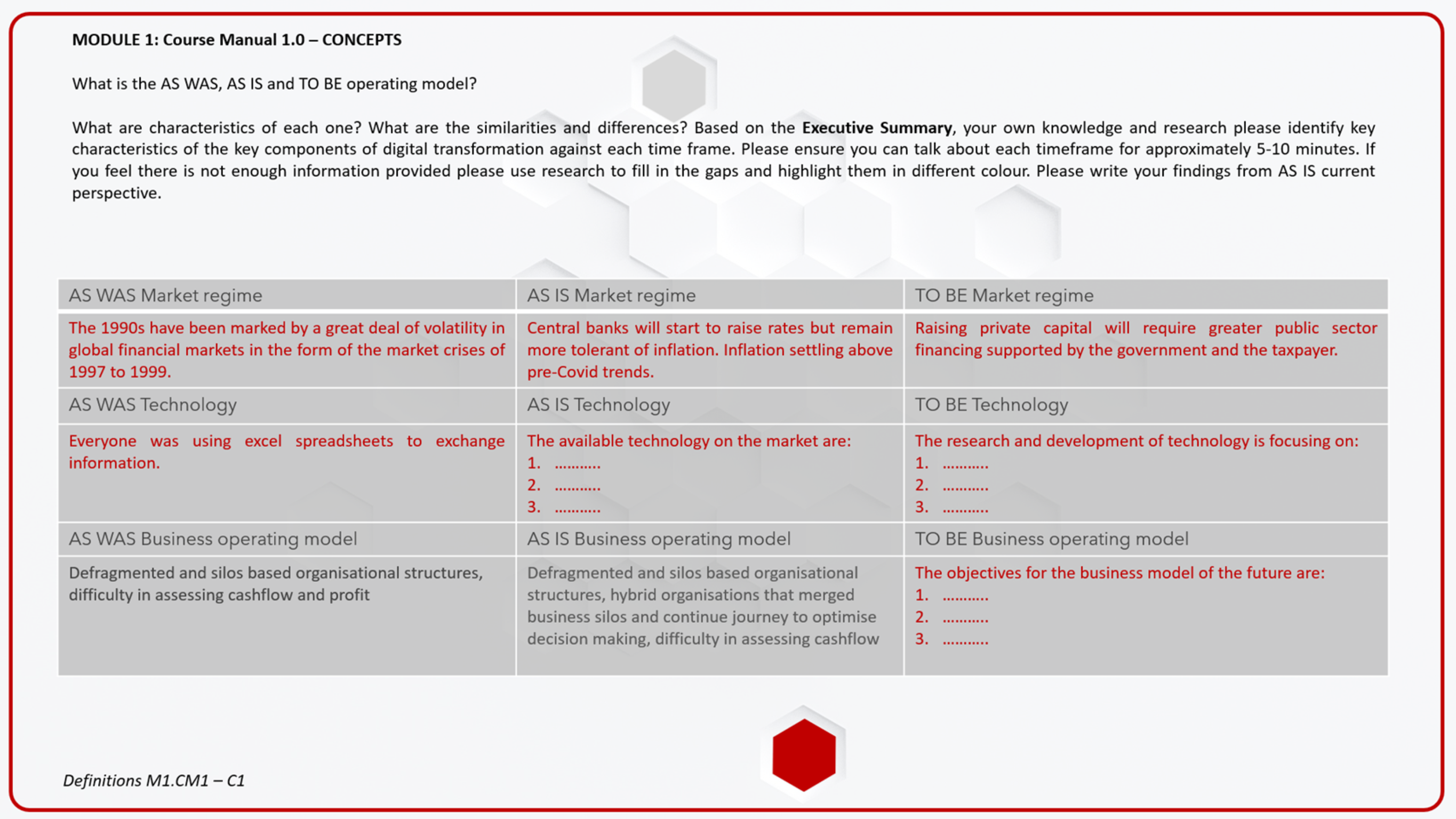
These three timeframes will be the key to your organizational digital transformation journey that we will build upon. Therefore, in preparation for workshop 1 it would be important that you identify from the executive summary for each time frame (past, present and in the future) the key aspects of digital transformation. Please ensure that you can talk about each timeframe for approximately 5-10 minutes at the beginning the workshop. You are most welcome to use the following format or use the template provided:
1. AS WAS (PAST)
• Previous Business Operating Model
• Market regime at the time
• Technology available at that time
2. AS IS (PRESENT)
• Current Business Operating Model
• Market regime at the time
• Technology available
3. TO BE (FUTURE)
• Proposed Business Operating Model
• Emerging market regime
• Technology developments prediction
The aim of Course Module 1.0 is to ensure that as individuals and as a team you develop understanding of how to break down the complexities of digital transformation components and concepts and to establish an operating model assessment framework for your project. The assessment itself will be carried out in the next MODULE 2.0. MODULE 1.0 is dedicated to establishing concept, logical structures, that will enable you to assess and further develop the design of the future state and the transition from current position with the understanding of the past constraints that might affect your design and decision making.
The objective is to get you thinking about your project from the perspective of PAST, PRESENT and FUTURE states of organisational business model and how it is affected by the external market forces and progress in technology. It is essential to learn how to breakdown complexity into defined and therefore manageable building blocks, parts, and components and to map, analyse, describe, define them, to ensure that you can clearly identify and specify their characteristics and requirements.
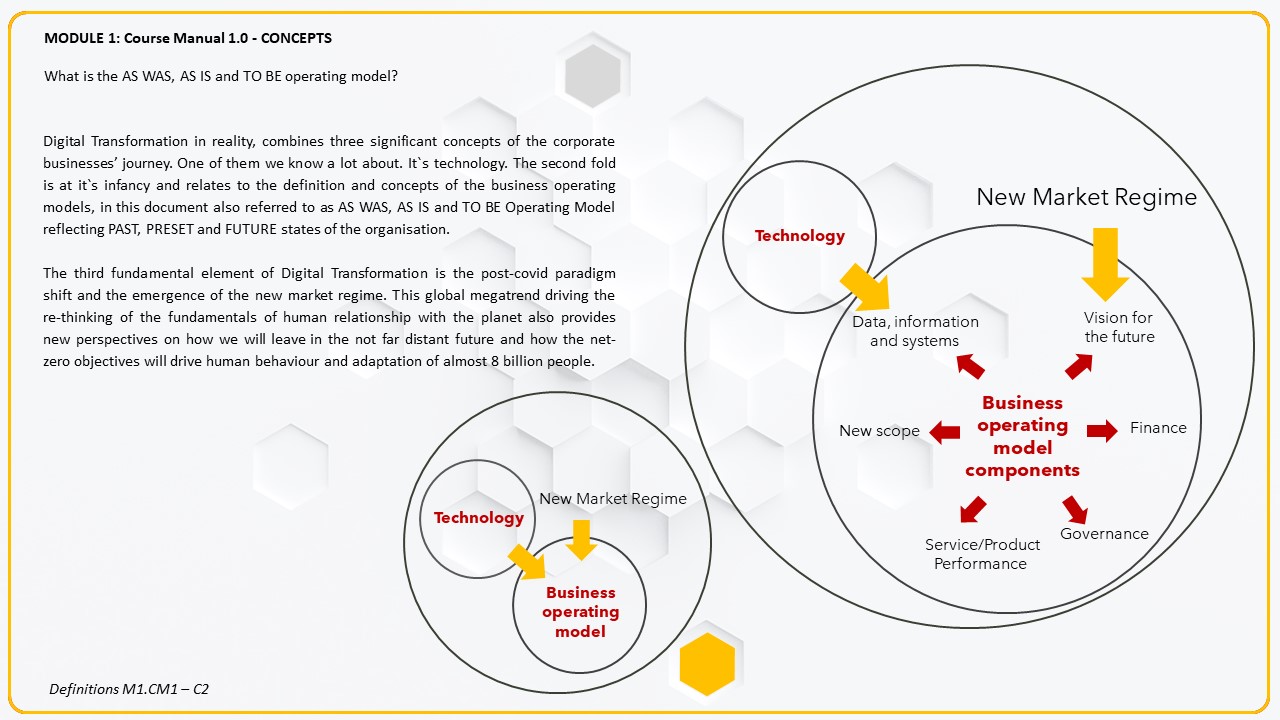
Our objective here is to also work with you to assess the changes in characteristics and requirements that take place between each of these three timeframes. Being able to quickly and effectively breakdown complexity into manageable parts and components in short term will enable you to create a 12-month Road Map with it`s distinctive milestones and approval Theme Gateways. In the long run it will enable you to effectively develop detailed delivery programme in MODULE 7.0 where you would be required to capture your own programme timeframes and snapshots and be able to identify key characteristics of each one to capture in the planning the level of change and impact on the organisation.
The goal is to have clarity on were, are, and will be the key trends and dependencies shaping your project definition, design, and delivery of the future state and how they impact your decision making that will realise the benefits you desire for your project.
To ensure everyone is on the same page, please familiarise yourselves with the definitions below. There are key questions that are valuable and useful to ask yourselves as you are evaluating the Executive Summary and proceeding with the Course Manual 1.0 Exercise. The key information you are looking for should help you to identify the characteristics of each timeframe, for example a future state description could look like this:
• In this decade business operating models will be generating revenues from selling on data. Organisations that identify their unique data sources and the needs of others to utilise it would be able to generate profits from their knowledge and internal expertise.
• The net-zero objectives set out for this and following decades will shape the new market regime and require from everyone to reduce their carbon footprint and yet predicted de-urbanisation will require more effective transport for less people.
• Transport networks will need to monitor their vehicles and fleet and their whole life emissions to ensure they use the most efficient routes to get customers from A to B with least amount of CO2. IoT sensor technology can provide data feeds form vehicles that in combination with AI can optimise transport routes and increase efficiency of moving vehicles in the most optimum time using lease CO2.
Previous operating model (POM) describes the past activities of the company a past state of being. The AS WAS past tense position, describes and explains processes and organisational structure and human relationships that tells us how enterprises used to work. Previous operating models’ function is to show how the organisation used to add value and how much efforts it used to take in the past operationally to generate value and profits but also answers fundamental questions such as: “who was the customer? and “what did they used to value?” or “how was the value extracted in that process?”
Current operating model (COM) the AS IS current position, describes and explains processes and organisational structures and human relationships that tells us how enterprises work. Business operating models’ function is to show how the organisation adds value and how much effort it takes operationally to generate value and profits but also answers fundamental questions such as: “who is the customer? and “what does the customer value?” or “how are we extracting value in that process?”
Target operating model (TOM) or the TO BE future state describes a blueprint of a organisation’s business vision for the future that defines operating capacities, organisational structure and value chain of the core business capabilities, internal and external drivers, strategic, operational and tactical levers, organizational and functional structure, technology, and information resources of a company.
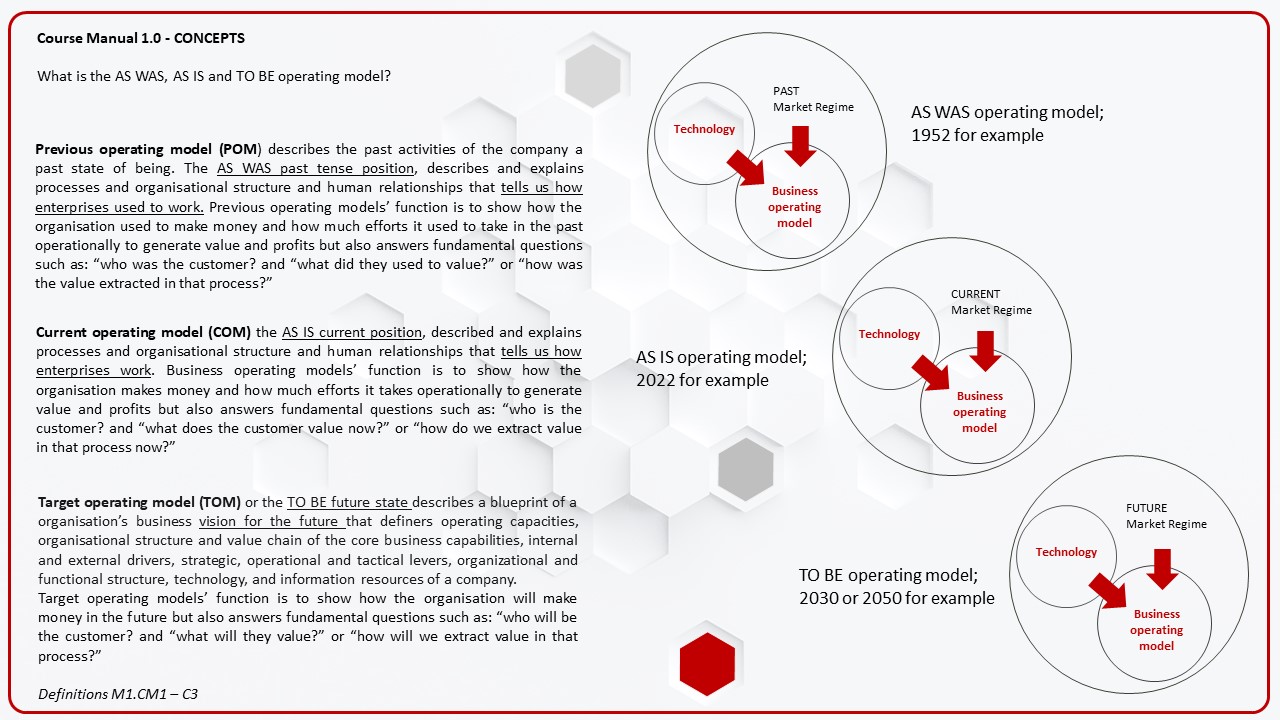
A Target operating models’ function is to show how the organisation will add value in the future but also answers fundamental questions such as: “who will be the customer? and “what will they value?” or “how will we extract value in that process?”

Course Manual 1: Exercise
Please read this case study document in readiness for the workshop. Please consider how would you map out and identify specific characteristics of the three components of digital transformation. What you should be looking for to identify are the features or qualities and characteristics of each component that enable you to identify three key points in course of the digital transformation journey: past, present, and future. Then using the characteristics identified please clearly describe qualities of each state showing differences and characteristics that change over time. Please use imagination to explore qualities of these three states to potentially enhance the description and the story telling of each timeframe. Please use the templates provided. During the workshop we will do this exercise in a group to distil all aspects and components of each concept. In principle we are aiming to develop significant level of detail that is required to identify impacts of change between AS IS and TO BE business operating model solutions. Use templates Template M1.CM1-E1 below to break down the concepts and findings.
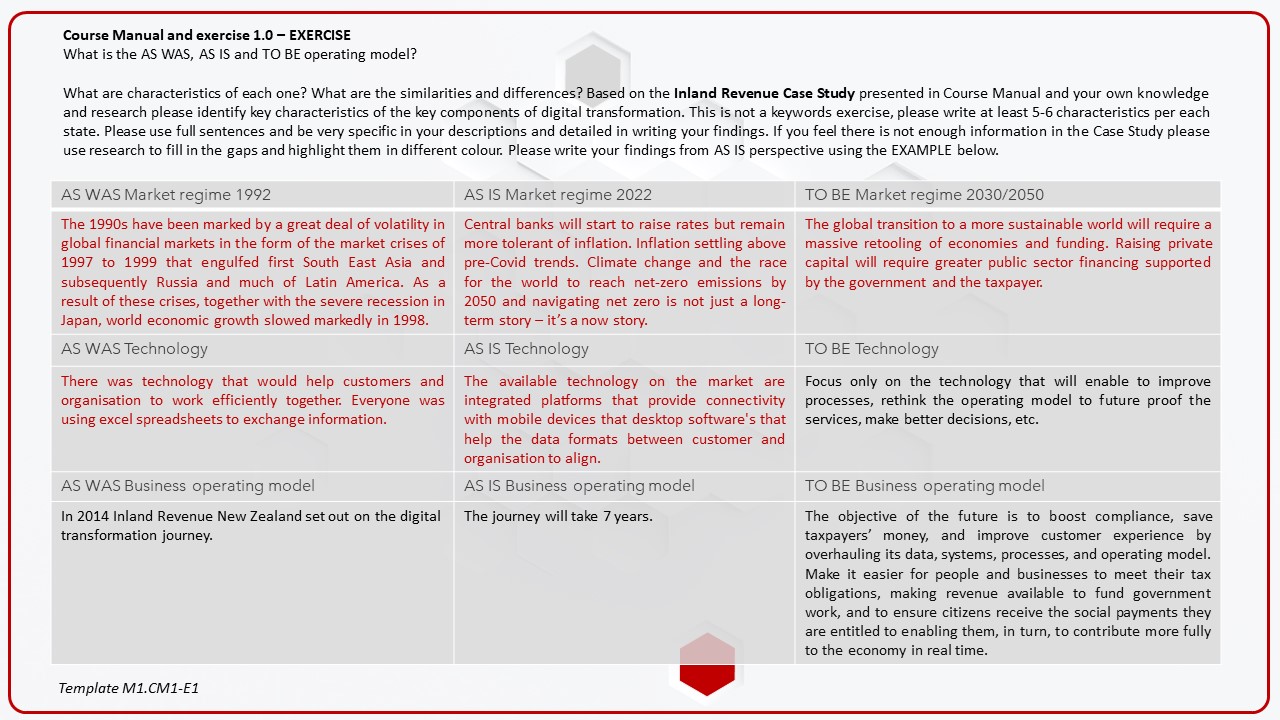

Case Study
The power of data in digital transformation: Inland Revenue New Zealand. Over the last seven years, Inland Revenue New Zealand has undergone a NZ$1.3bn digital transformation programme that aimed to boost compliance, save taxpayers’ money, and improve customer experience by overhauling its data, systems, processes, and operating model.
In 2014 Inland Revenue New Zealand set out on the seven years journey to become an intelligence-led organisation. The NZ$1.3bn (US$900m) digital transformation was an “all-encompassing” programme that focused on addressing technology, changes in the markets and overhaul of the operating model simultaneously. It was decided from the outset that in this digital transformation approach, organisation will not focus only on the technology but first and foremost on how to improve processes, rethink the operating model to future proof the services, make better decisions, or devise processes or elements of system more effective.
The aim, ultimately, was to make it easier for people and businesses to meet their tax obligations, making revenue available to fund government work, and to ensure citizens receive the social payments they are entitled to enabling them, in turn, to contribute more fully to the economy.
To do this, Inland Revenue’s (IR) strategy was to put customers at the centre of the agency’s work, improve collaboration with other parts of the tax ecosystem through reimagining its business operating model and adopting digital technologies that enabled smarter use of data.
The team’s first step towards achieving its goals was to consider how to shape the narrative around intelligent data use in the future state. What was needed was to decide what it meant to be an intelligence-led organisation, how IR could make that operable, and how they were going shape data and analytics in line with the impact of change it would have on the organisation.
Procuring a new platform
At the heart of the change was the implementation plan of a data intelligence platform that could be quickly established for operability of the new technology within approximately 3 months. Central to all, the work that would follow was the procurement of a new platform to support IR ambition and vision for the future rather than becoming overly invested in technical management to start with. The agency placed high expectations around the platform delivering value early and iteratively. The tools themselves made the process of managing data, information and systems and building analytical outputs and visualisations “that bit easier”. Nonetheless the challenges of swapping old to new and aligning with other platforms have presented its challenges in terms of data sets granularity with the target data model requirements, development of data dictionaries and overall data migration exercise.
Embracing change of the operating model
The platform is the beating heart of the organisation, data, and information analytics work but to optimise the insights that could be derived from it, its people who had to adapt to meet the future state requirements and work in a completely different way. It is often a mentality that an analytics function exists to service demand requests. Arguably, in a digital services organisation, data analytics become part of the fabric and business operating model. A step change was required for the organisation to adapt at its pace to the wider future state design and how the data and the new services would be consumed once some of the business processes collapse during the adaptation.
This meant encouraging people to challenge previously accepted norms, re-think these concepts and what the data and information meant in the new future state. This required for many people to step out of their comfort zone into a more challenging set of conversations, as well as tasks.
This process of re-designing the operating mode gave many thought leaders and ambitious members of staff the opportunity to excel, learn new skills and be recognised for it. On the other hand, as is the norm with large change and new faces, there was resistance as the organisation encouraged the breaking down of siloes and standing up of teamwork and integrated approaches.
Communicating the change that needed to happen meant going back to basics. It was a case of recognising what was needed to build from an AS IS current way of doing things to the new set of foundations. IR tried to make the process of change as inclusive as possible so that the team felt empowered to help shape their future.
Nevertheless, some chose to leave the organisation to further their own ambitions. For the most part it was the right decision for them and their careers. The turnover certainly has made it very challenging to build the new status quo and cohesion. Given the transformation was wholesale across the core tax system too, the impact meant the team was tasked with managing the current work items, decommissioning the old, and improving or adding the new modules whilst front of house resources shifted.
COVID the catalyst
The COVID-19 pandemic prompted greater sharing of data between New Zealand government agencies, and it was a realisation that some of the things could not be done or would take much longer and therefore IR would not be able to support people in the short time when key support was needed to adapt to the new market regime.
One example was data sharing to facilitate people receiving government support packages during the crisis within hours of applying. IR and the Ministry of Social Development worked at pace together to put in place the appropriate paperwork to view the relevant IR transactional data and verify the customer’s application. In turn the analytics team utilised the opportunity to build improvements in fraud detection as part of the new scheme.
A key success factor was IR’s transition to the modern technology to support delivery of services and analytical insights in a fast and responsive manner. Had the IR not been through that transition and got some of core tax products onto that new system, literally months before COVID hit, they wouldn’t have been able to do half of what was required during the pandemic. A robust data, information and systems management strategy was developed as part of the future state design to focus on how data is collected, held, shared, and distribute in a much more structured and systematic way.
Inland Revenue’s NZ data and analytics team has come a long way since it set out on the journey to reimagine how it will operate as part of the agency’s wider digital transformation. This work upfront to re-think the future state and identify need for the future laid the foundations of what it set out to do: enabled improvements in decision-making to improve compliance; contributed to improvements in the customer experience; and changed people’s perceptions of what the analytics and insights team do and how it can be utilised to meet business goals in the new operating model.
Benefits realisation
The team’s work is already paying dividends. IR has an annual cycle of interventions in place. This phased approach starts from activities promoting general awareness, followed by more targeted compliance activities including audit activity.
The cycle of interventions is designed to shift compliance by ensuring customers have the information needed as early as possible to ensure they can get it right from the start. With the power of the data intelligence platform, IR can bring together the data, tools, and analytics to better identify specific attributes and risks and apply the right intervention type to the customer’s circumstances at the right time and above that to make decisions that can be made that support a future focus state.
Through a combination of the platform capability with advanced analytics dashboards, which system architecture has been designed from the outset underpinned a strategic blueprint about customer behaviours and allowed to explore causations, correlations, and predictions of customer participation in the tax and social policy system.
Accelerating cross-government data sharing
Inland Revenue NZ has also made strides towards hitting one of the key goals of the overarching digital transformation investment – that of enabling other agencies to benefit from IR’s investments.
The organisation continues to explore opportunities that support other government organisations that could be as simple as sharing some of technical expertise and learning, to provisioning access to certain parts of the IR platform for alternate use. These are an ongoing part of cross-agency conversations to ensure the benefits realisation can be achieved.

Course Manual 2: Identifying the context for your organization and the project. What is the difference between POM, COM, and TOM?
The objective of this Course Manual 2.0 is not only to prepare you for your organisational assessment but also to give you head space and time, to inspire the team in the design of the future state and technology solution. We will start developing it in MODULE 3.0. It is also to contextualise and place your thinking about the future state design in the context of the times we live in and future requirements. Understanding the differences in market demands, customers’ needs and how they affect operational delivery, technology selection, and how the business operating model would shape the outcomes of your future state solution.
Nowadays, there is a focus on technology that can create value for customers leveraging the personalised and customised customer data that can be collected via mobile technologies and therefore can generate revenue on a massive scale. Businesses are taking advantage of this data and information at scale to better tailor their operational delivery, products, communications, and interactions to fit market specific needs and expectations.
A business operating model that is technology driven, as a concept is the fundamental logic of a company that describes what benefits are provided to customers and partners and how the company extracts value in return for providing these services. A business operating model answers therefore the key questions of how the benefits provided to the customer flow back into the company in the form of revenue often by using technology. The created added value enables a differentiator from competitors, the consolidation of customer relationships, and the achievement of a competitive advantage. A business operating model often has different dimensions that fit together like a Rubik’s cube. These building blocks are connected by different data and information flows from different IT platforms that are like blood veins of any organisation. These dimensions often are driven by the markets regimes and customers’ needs and make it possible to achieve growth and imitation by competitors difficult. These external factors and understanding of the market need often are the direct shaper of the business operating model and technology application for a particular delivery solution.
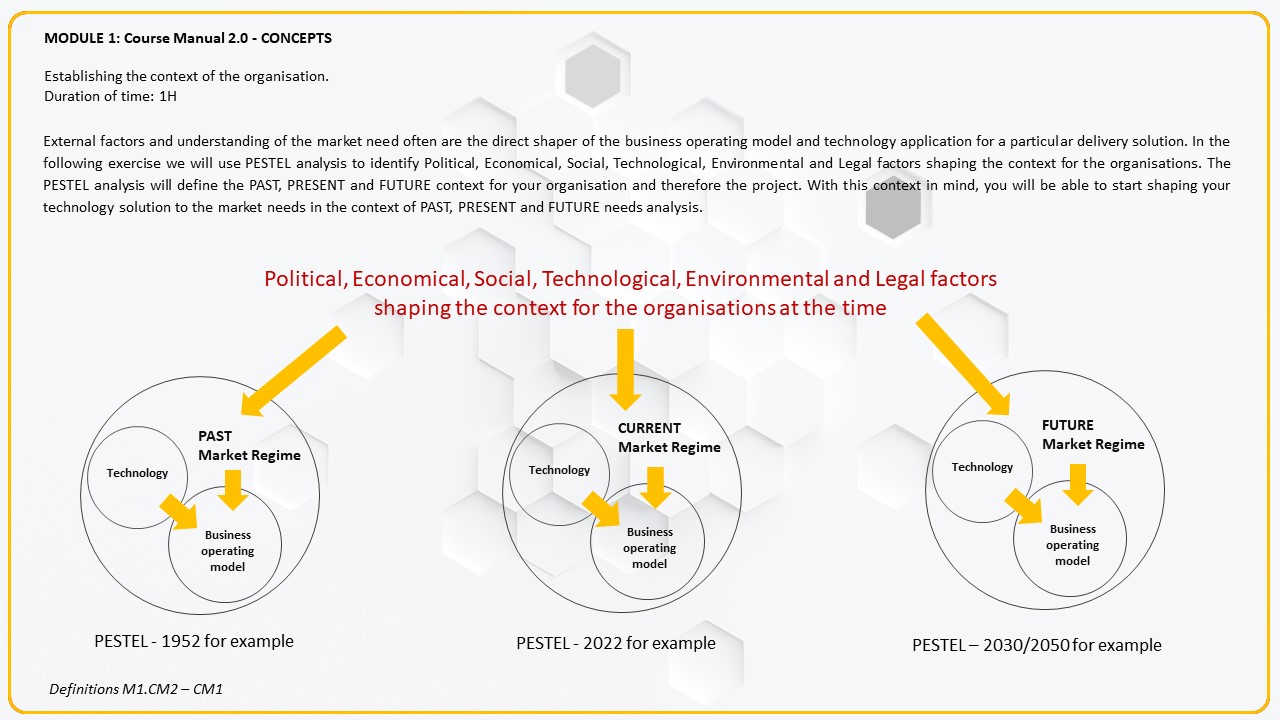
Some of these external dimensions could be:
1. The external markets dimension and the new regime often are driven by legislation and government level strategy that in return shapes the customer needs.
2. The customer dimension contains the customer needs therefore creates customer segments, customer channels or customer relationships.
3. The customer benefit dimension includes products, services, and unique value proposition that distinguishes the organisation from the competition.
4. The revenue dimension includes the resources, skills, and processes and how efficiently are they delivered internally and with the partners supply chain and partner relationships.
5. The financial dimension includes the ROI and enables balancing the revenues and expenses that when well aligned in the business model mutually reinforce each other.
6. The technological dimension is the key driver to increased efficiency of business processes and improve the financial and revenue dimension. The implementation of technology however brings the change to organisation and can have a detrimental impact on the business if not designed into the future state and the Target Operating Model.
7. The people dimension is probably the most important aspect of any transformational level of change that responds to the new market regime. In that sense, aiming to reach new horizons to see how far the organisation can get with transforming business processes using new technology to adapt to the paradigm shift is a good indication of the journey ahead of you. Anything can happen, there can be unexpected things that might stop you from following a certain path, there will be bends and curves in the road that can present themselves at any time. On this journey as individuals and as a team you would need to make a commitment that makes everyone feel that they are growing and heading towards the objectives. Putting one foot on the front of the other is the most important part of any digital transformation journey. This dimension is not only dedicated to working as a team, but it also refers to other people you will interact with in this process, your key internal and external stakeholders, the supply chain and ultimately the customer. The key to this dimension is understanding human factors, storytelling, and clear communication.
8. The time dimension consists of activities and programme and a plan that are put in place to ensure all previous dimensions come together to deliver the ultimate future state solution that moves the organisation or an aspect of it forward.
9. The environmental, social and governance (ESG) dimension is also a key shaper of the organisational business model as it drives organisational investment into the portfolio, affects all phases of asset lifecycle, risk management and strategic decision making that impacts individual assets condition on operational and tactical levels.
The objective of this course manual is therefore to combine both storytelling and fact finding to describe the context of your organisation. We will therefore in the following exercise use PESTEL analysis to define the PAST, PRESENT and FUTURE context for your organisation and therefore the project. With this context in mind, you will be able to start shaping your technology solution to the market needs in the context of PAST, PRESENT and FUTURE needs analysis. For example:
Past: Attitudes and expectations of people in the past would have been simpler since they did not have the same level of complex economic, social, or political problems. In the past the conditions of living were not as comfortable as they are today, people had to focus on making sure they were safe and secure as a priority. There were no bathrooms and running water in many houses, besides that many people could not afford household appliances like fridge, internet, TV, or vacuum cleaner because they were seen as luxury goods or were not even available. Past-oriented customers are therefore concerned with traditional values and face to face interactions and are used to more personal ways of doing things. They did not have the same beliefs systems and did not value the same things as we do today.
Present: A lot of people in the present have access to the internet and therefore have almost unlimited access to education, they are therefore more open, and free to express their opinions. They are more focused on what happens in the present time, are concerned with long term plans. Their life today is easier and more convenient than in the past, so they focus more on life experience than on keeping safe and secure. The use of mobile devices and technology generated a new type of human interactions. At present, people have access to many resources in real-time. They can achieve more much quicker, so the present-oriented person focuses on concrete factors in the immediate, sensory present (physical salience, sensory qualities, current social pressures) while ignoring or minimizing the decisions that exist only in an anticipated future context or a remembered past context.
Future: It is difficult to predict the future or to attempt to design it. Yet, companies like Siemens are one of these key players who do exactly that. Through their research and design initiatives the business identifies what possible scenarios and social changes are ahead of us. Using prototyping, modelling and demand analysis techniques they develop future scenarios and products and services on a small scale that are then tested in the market. Highly recommend reading by Ulrich Eberl, “Life in 2050, How do we invent the future today” would inspire you to imagine the future state of your project in the context of your organisation. Here is one of the possibilities:
It won’t be the same way as it is in science fiction films. In the year 2050 cars won’t be flying through the steel grey urban gigantic mega cities and nobody will be beaming astronauts to distant planets. Human brains won’t be connected to the other brains via radio or telepathy. Nonetheless 30 years from now the world will be completely different from the one we know today. The era of large-scale power plants fuelled by coal and nuclear energy will come to an end. Instead, there will be hundreds of thousands of small installations based on solar or wind energy or geothermal biomass or wave power plants providing both electricity and heat from renewable resources. Robots will replace humans in the most dangerous or low paid jobs such as miners, window cleaners, gardeners and support senior citizens. Thanks to microchips, blind people we learn to see again, and tiny sensors will check blood vessels in the body and search for cancer cells so that the doctors of 2050 can intervene promptly if there’s a risk of sickness. Many one hundred year old people will then be as fit as the seven years old of today.

Course Manual Exercise 2.1 and 2.2: Identifying the context for your organisation and the project. What is the difference between OM and TOM?
We are at the beginning of a new era and in the new market regime. Our planet is at risk due to human extensive activities. The natural non-renewable resources are becoming scarce and they need to be shared among the growing human population. The transition to the renewable energy will take some time and requires significant investment. The global population in 2030 is expected to reach 7.6 billion, 9.8 billion in 2050 and 11.2 billion in 2100, according to a new United Nations report.
With those constraints and opposing factors in mind Organisations need to solve problems of the future today and come up now with solutions for tomorrow. One of the best ways to predict the future is therefore to invent it based on the need of the next generations.
It is said, the past is the mother of the present and the grandmother of the future. The present is the child of the past and the mother of the future. The future is child of the present and a granddaughter of the past. These are the key three human factors and perspectives that you are going to evaluate in this Course Manual Exercise. The primary objective of this exercise is to map out using PESTEL analysis the context for your organisation from the PAST, PRESENT and FUTURE perspective using format of the Template M1.CM2-E2.1.
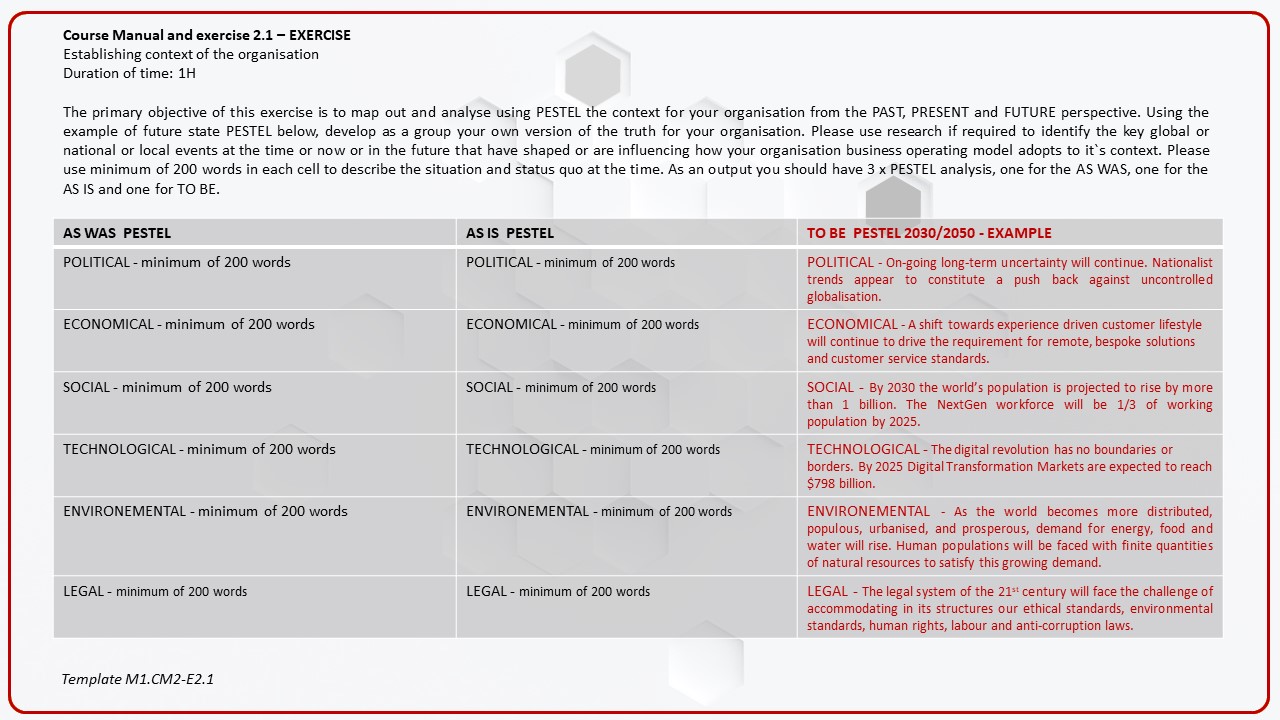
PESTEL analysis will help you to structure your thinking about the context not only for your organisation but for the project itself. Identifying how Political, Economic, Social, Technological, Environmental and Legal factors shape your organisation business operating model will be one of the key objectives of this exercise. These six global megatrends reshape the world we live in. These powerful, transformative forces can rapidly change the global economy, impact national policy, and strategy as well as organisations, businesses, and societies. Although their aspects have been changing their meaning over generations, they have consistently re-shaped the way we live leading to technological innovations such as electricity or the Internet.
Using the example of future state PESTEL below, please develop as a group your own version of the truth for your organisation. Please use research if required to identify the key global or national or local events at the time, now, or in the future that have shaped or are influencing how your organisation business operating model adapts to its context.
You are most welcome to set up an Excel spreadsheet to capture the detail of your analysis following the Template M1.CM2-E2.1 format.

As an output you should have 3 x PESTEL analysis, one for the AS WAS, one for the AS IS and one for TO BE. Please ensure you have at least 200 words for each cell. The example of future state PESTEL below:
Political (EXAMPLE only) – On-going long-term uncertainty will continue. Diversified recoveries would highly likely constitute a push back from the citizens against uncontrolled globalisation. As there is currently no global jurisdiction, the emergence of shadow governments might continue, raising questions of global governance and accountability.
Economical (EXAMPLE only) – A shift towards experience driven customer lifestyle will continue to drive the requirement for remote, bespoke solutions and customer service standards; the “here and now” will become dominant in driving customer expectations. Need for integrated end-to-end approaches will steer operating models towards more collaborative ways of working among core business and the supply chains. Seeking end-to-end cost visibility throughout the supply chain will make the design, construction, maintenance, and disposal of assets more efficient, cost effective, and enable introduction of sustainable solutions to the environmental challenges of Net Zero by 2050.
Sociological (EXAMPLE only) – By 2030 the world’s population is projected to rise by more than 1 billion. More than half of the world’s population will live in distributed communities connected by the internet. Almost all of the new rapid urbanisation will take place in lesser-known medium-sized satellite cities. The NextGen workforce will be 1/3 of working population by 2025.
Technological (EXAMPLE only) – The digital revolution has no boundaries or borders. By 2025 Digital Transformation Markets are expected to reach $798 billion. Digital disruption will force organisations, to re-think their business operating models and highly likely result in business transformations. The impact of adapting new technologies will re-shape the business core components, processes, and tools used to deliver services and customer experiences. At the same time, technology will influence automation of repetitive activities, re-define behaviours and human interaction with technology.
Environmental (EXAMPLE only) – As the world becomes more distributed, populous, urbanised, and prosperous, demand for energy, food and water will rise. Human populations will be faced with finite quantities of natural resources to satisfy this growing demand. Managing population impacts on the planet will further strengthen end-to-end value chain approach and drive a move from linear to circular economy. To meet the Net Zero target by 2050 the organisational business operating models will need to adopt circular processes to minimise waste disposal to the environment and learn how to calculate their environmental impact. This megatrend will influence innovation in the way the businesses fundamentally operate and reshape delivery models.
Legal (EXAMPLE only) – The legal system of the 21st century will face the challenge of accommodating in its structures our ethical standards, environmental standards, human rights, labour and anti-corruption laws. This megatrend is a key enabler of Whole Life Value and circular economies. It will further ensure we procure the right products and services that reduce human impacts on the planet.
The secondary objective of this exercise is to establish how your organisation responded to the context of the past, is responding to the current changes in the market regime and how it will respond to the new market regime.
For each PESTEL analysis please outline how your organisation has responded to the megatrends of the PAST, PRESENT and what it will do in the future. To outline this, you could refer to business corporate strategy or business vision etc. Using the EXAMPLE Template M1.CM2-E2.2
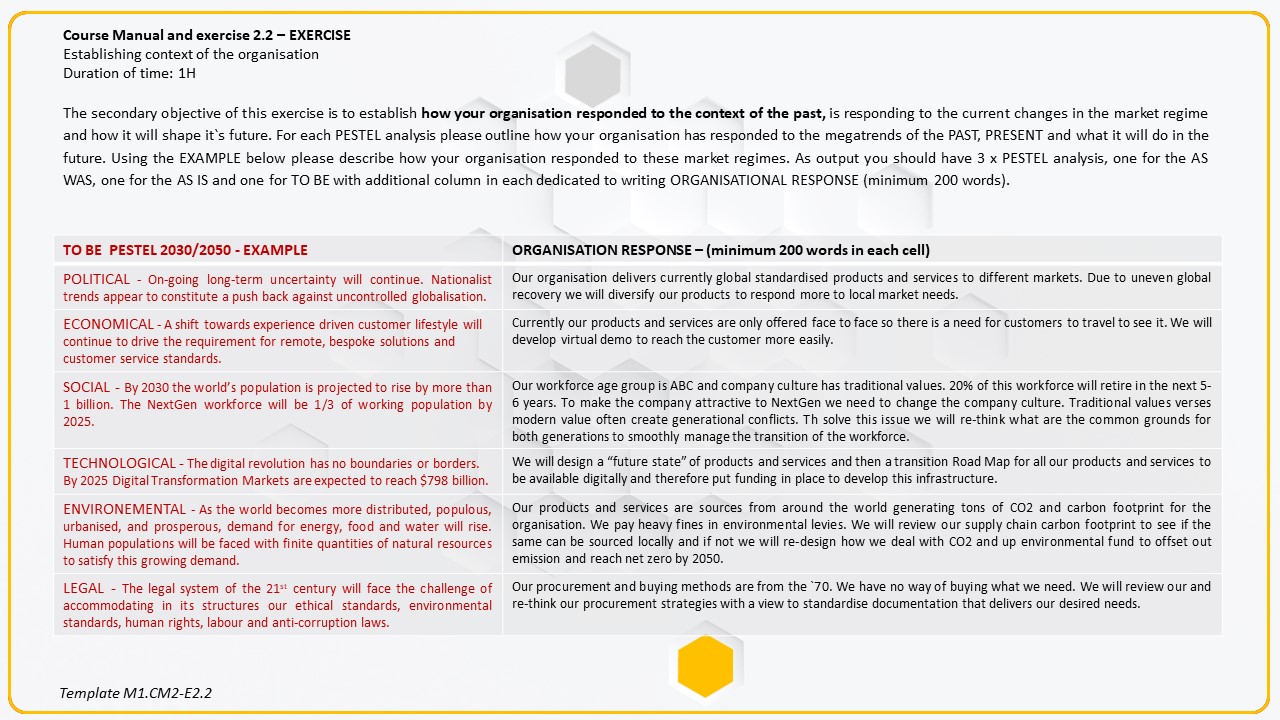
Please describe how your organisation responded or is responding to market regimes or what it is planning to do to adapt to the market changes. As output you should have 3 x PESTEL analysis, one for the AS WAS, one for the AS IS and one for TO BE with additional column in each PESTEL timeframe dedicated to writing ORGANISATIONAL RESPONSE (minimum 200 words).

Course Manual 3: OM and TOM system components
Long before anyone thought of system thinking and a way of making sense of the complexity of the world by looking at it in terms of a whole system with its intrinsic relationships rather than building it bottom-up and splitting it down into its parts, prehistoric homo sapiens were forced to solve problems with trial and error with harsh consequences for wrong answers. With limited resources and evolutionary constraints that limbic system still can impose on the brain power, they competed for survival in the world seemingly weighted against them. But we are here now. That confirms the ability of some prehistoric caveman managers to make the right decisions. Humanity’s quest for improved decision making and therefore structured logical thinking, that is a primary function of the prefrontal cortex area of the brain, continues because the consequences of wrong solutions are still harsh.
Advancement in technology and progress in systems thinking offers expanding choice of resources and methods to accomplish objectives with razor sharp precision. To move forward with integrating technology into day-to-day operations, organisations need to align not only their business models’ components but also the data flows among them. That level of change that affects business process and relationships often requires an organisational restructure to take place. One of the ways to deal with this challenge is to create as part of transition data hubs, also referred to here as solution spaces, where teams can gather together (by a well in ancient times) to find data and information from a data lake for example, to solve problems jointly on the system rather than department level.
Moving away from traditional way of dealing with data requires a system way of thinking as it provides understanding of how it all fits together. Later, a multidisciplinary approach where more than one discipline contributes to the overall picture by understanding the system, that in return enables overcoming the development of sub-components and silo sub-cultures that ignore the bigger picture.
There is a further need to use a science driven approach based on facts and figures to analyse how information from the environment influences system changes that can cause systemic failure points. Since business operating models are complex it is not reasonable to expect a single individual to possess all the background knowledge and training necessary to find the best solutions. A multidisciplinary team approach utilising the expertise of individual area of knowledge and creating a solution space where those who need to solve problems can gather, will enable the business to develop a number of options and scenarios that can be further investigated for feasibility. The solutions themselves can be very bad and very good, economical as well as prohibitively expensive, some obvious, others nearly undetectable. Even a simple problem may have an enormous number of theoretically possible solutions if no limits are set on expanding resources.
With system thinking approach it is necessary to formulate a number of system control measures (Definitions M1.CM3–CM1),
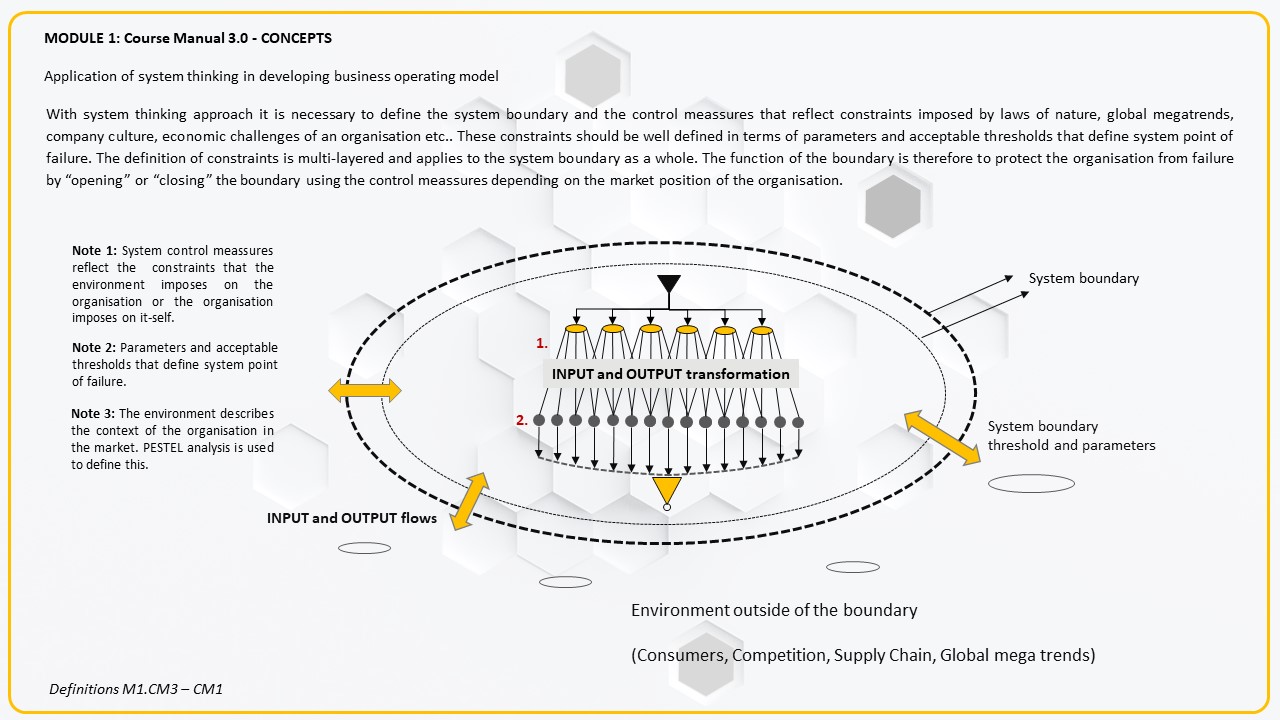
correction factors, parameters, or evaluation criteria that reflect constraints imposed by the laws of nature, global megatrends, company culture, economic challenges of an organisation, and other aspects that can be used to narrow down the options and number of solutions. These constraints should be well defined in terms of parameters and acceptable thresholds that define points of failure. These definitions of constraints aim to show the team which solutions remain within the acceptable threshold and which ones would need to be ruled out as unavailable due to organisational constraints.
With system thinking approach it is also necessary to define the system boundary and the control meassures that reflect constraints imposed by the laws of nature, global megatrends, company culture, economic challenges of an organisation etc. These constraints should be well defined in terms of parameters and acceptable thresholds that define system point of failure. The definition of constraints is multi-layered and applies to the system boundaries as a whole. The function of the boundary is therefore to protect the organisation from failure by “opening” or “closing” the boundary using the control meassures depending on the market position of the organisation. Please refer to Definitions M1.CM3–CM1 for visual representation.
Free-wheeling ideas no matter how ridiculous, should not be discounted straight away during the team brainstorming sessions because they often contain associative links that are essential to the creative process even if they fall outside of constraints thresholds. Please refer to the example in Definitions M1.CM3 – CM2.
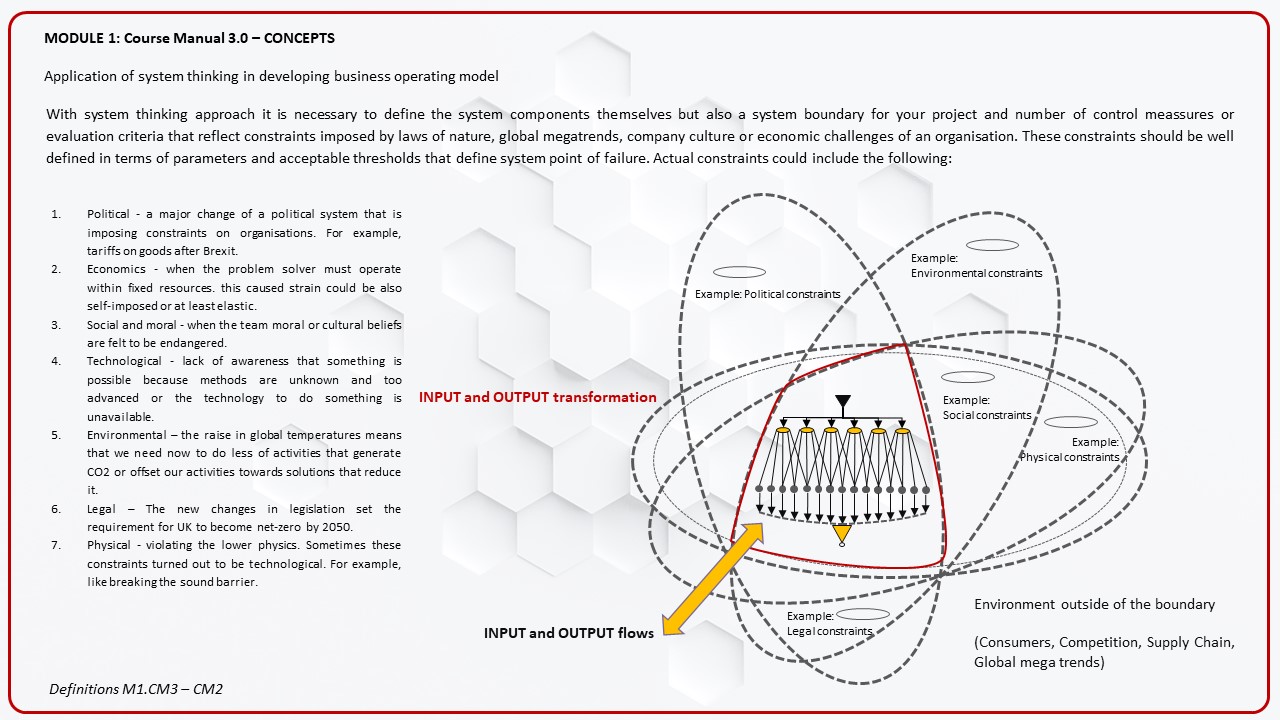
Further on each constraint should be examined if it’s actual or fictitious. Some of more typical fictitious constraints may include:
1. Provincialism – creating artificial time, space, values, or cultural restrictions to exclude taboo and silo mentality to promote self-righteous thinking.
2. Ivory tower syndrome – lack of factual information on current data and information technology due to own self-centred -preoccupation.
3. Laissez faire thinking – the doctrine of non-interference – if someone has an idea why spoil it by proposing another one even if it solves the problem in a different away.
4. Perfectionism – and insatiable demand for precision where approximation or 20%/80% rule would do.
5. Traditionalism – what our predecessors did ought to be the best.
Actual constraints on the other hand could include the following:
1. Political – a major change of a political system that is imposing constraints on organisations. For example, tariffs on goods after Brexit.
2. Economics – when the problem solver must operate within fixed resources. This restraint could be also self-imposed or at least elastic.
3. Social and moral – when the team moral or cultural beliefs are felt to be endangered.
4. Technological – lack of awareness that something is possible because methods are unknown and too advanced or the technology to do something is unavailable.
5. Environmental – the rise in global temperatures means that we need now to do less activities that generate CO2 or offset our activities towards solutions that reduce it.
6. Legal – The new changes in legislation set the requirement for UK to become net-zero by 2050.
7. Physical – violating the law physics. Sometimes these constraints turn out to be technological. For example, breaking the sound barrier.
A scientific approach and system thinking that we will be using to analyse your organisation AS WAS, AS IS and to develop your project target operating model structure implies the use of logic and it is usually understood that a component or building blocks logic needs to be developed and that scientific experimentation and testing needs to be included. This means logical models (hypotheses) that reflect business operating models must be created and tested in different scenarios. Since the business operating model is an abstraction of logical system thinking it also should define the cause-and-effect relationships that it portrays.
To create this logical system and its representation in a form of building blocks we can use the PESTEL analysis we have already created definitions of actual constraints and relationships with the external environment, the world outside of the organisation. We have already touched based on defining aspects of change in Course Manual 2.0 and identified what level of change is required to transition from one system to another i.e. from the AS WAS to AS IS and to the TO BE. These aspects of change that you have already identified can also be used to outline the organisational needs for change, the control measures (could be both correction factors or evaluation criteria) and the impact of moving from one way of working to another.
The next element of structuring concept logic using system thinking is to construct a logical model including its components. We will address this in the Exercise 3.1 and other activities to follow. Identifying these key components of logical model and therefor a system boundary is a key objective of the Exercise 3.1. Outputs from the exercise we will use to carry out the baseline assessment in Module 2.0.
We will also use these components and system logic in modules 3, 4, 5 and 6 to form the foundations for the designing the future state. Further on you will have the opportunity to experiment and test the logical model is various scenarios and options as we verify its viability for adaptation with the organisation. The experimentation itself will require an additional level of defining constraints so this is a good time to practise it on the concept level.

Course Manual Exercise 3: OM and TOM components:
Frequently the toughest part of the project is to get started. Once mental activity gets underway things happen and it is relatively easy to keep them happening, but it is difficult to ignite that first spur of activity and make the first step. There are always excuses to postpone starting: it’s not needed yet, things may change soon, someone else should do it etc.
The psychological aspect of being a self-starter and having a good level of curiosity and courage to put one foot on the front of the other are key to this hands-on project. To get you started with mapping out the logical model and its components and sub-systems or identify the problem you are aiming to solve we are also going to use diagram mapping techniques to help you get started.
Diagramming aid helps the initial investigation by providing a format and a structure which encourages the first effort to get something on paper, organise thoughts, identify what is known and what is missing, what data is required and what data you already have, and put everything in the digestible format to quickly see what needs to be done and create a follow up TO DO list. Whether the diagram looks formal or not it doesn’t matter at this stage, this simple convenient and practical way of putting your thoughts on paper makes the first step seem downhill instead of uphill. If you end up drawing on a napkin or just make a sketch on a small piece of paper it is important that you start.
Once the problem you are trying to solve has been mapped out sometimes it is very evident to see the answers straight away but more often it stems from a feeling that something can be done better and/or personal experience defined by individual expectations whilst being part of the process.
To shape the business operating model or your processes using system thinking logic and strategies, seven main components of a system should be considered. Definitions M1.CM3 – E3.1 image visualises each of these critical components which are:
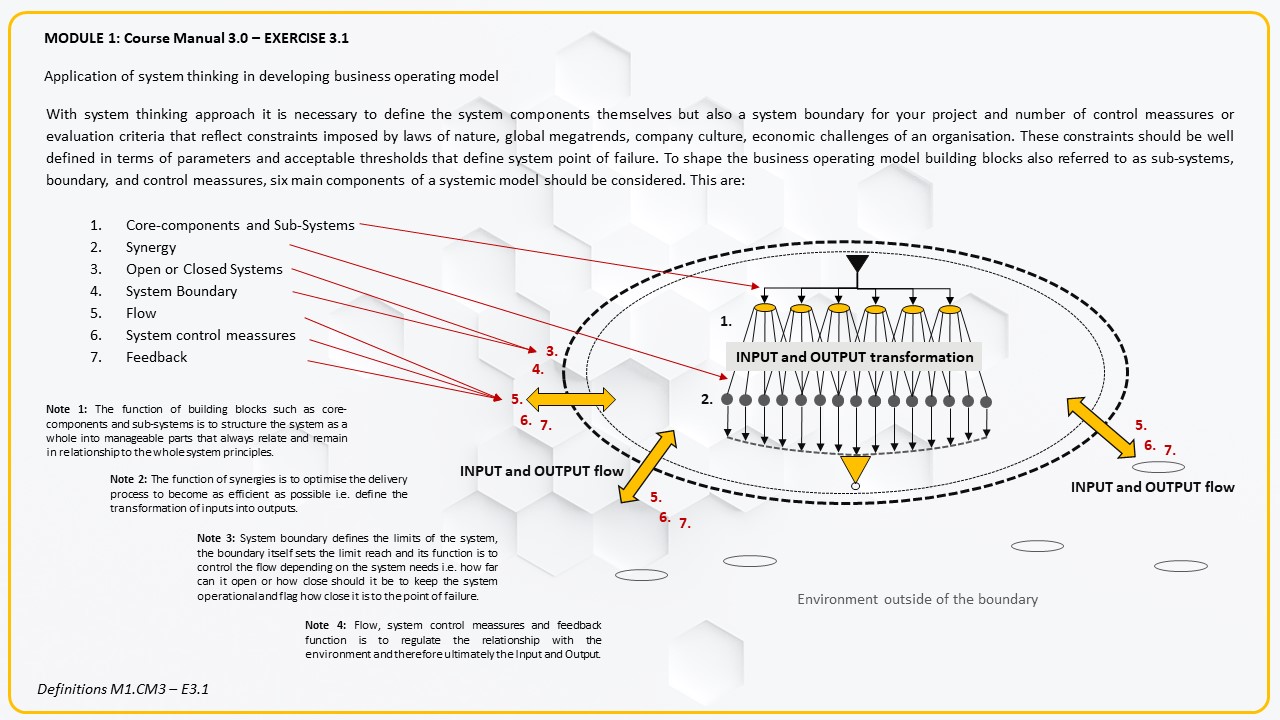
Core – components and sub-systems
Each part of the bigger whole is a sub-system. Business departments of business functions could be considered core-components. Core-components are the layer of the organisation that receives the inputs from the environment, processes them to provide outputs. These core-components make the whole organisation and therefore all of them together form the system boundary.
Each sub-system is part of the larger system which, in turn, is sub-¬system of a still larger system. For example, department is a sub-system of the organisation which is a sub-system of the industry, which, further is a sub-system of the national economy which is a sub-system of the world economy. The department itself could have a few locations and divisions across the globe, each division would be the sub- system of the department and could be further divided into teams, working groups and other sub-systems depending on the organisational structure. These internal sub-systems are often aligned with strategic, tactical, and operational decision making related to the financial approval levels.
Synergy:
Synergy defines relationships amongst all parts of the organisation e.g., if production and operations departments have relationship with sub-system like finance department that provides them with finance support. This finance department however is being a central function of the whole system and the relationship is that both production and operations share cost of that support. The synergies define how the internal sub-systems are consolidated to best serve the organisational purpose. All the core-components and sub-components should be arranged in such a manner that output of the whole (achieved through coordination amongst sub-¬systems) is more than the total of the output of individual parts.
Open and Closed Systems:
Business operating models seen as systems can be open or closed. Open system actively interacts with the environment and enables the organisation to adjust effectively to the market regime. It receives inputs from the environment (customer feedback or carries out demand analysis or market research to establish demand) and converts them into products and services made of raw material, labour, or capital to sell the outputs (goods and service) to the society.
A closed system has no or very little interaction with the environment. Practically, all organisations are open systems though degree of openness with the environment varies according to system boundary and internal system control meassures as well as nature of their operations. A manufacturing organisation, for example, is far more open than a government administration (manufacturing requires to purchase raw material, processing, selling, marketing whilst government administration is mostly concerned with one way provision of service to the public after taxes have been collected).
System Boundary:
Each system has a boundary that separates it from the environment. The world outside the boundary of the system is its environment. This boundary is overlapping (flexible) in case of open system and non-flexible (rigid) in case of a closed system. The more the organisation interacts with the environment the more flexible is its boundary. System boundaries are increasingly flexible in the modern world; however, they should be carefully monitored for duplication in a large client system where for example in logistics and transportation multiple parties across the globe deliver end-to-end solutions.
Flow:
Flow represents the movement of inputs into the system from the environment. The input should identify what the market and therefore customer want and need at the particular timeframe i.e. AS WAS, AS IS, TO BE. This input should define the products and services needed at the time, the offering to the customer and the transformation of these into labour, material, money, machines, equipment needed to provide sellable outputs (goods and services) and supply of these outputs to the environment. The flow essentially defines the business processes that connect all sub-systems and are required to deliver goods and services to the customer.
System control meassures:
Any logical system model and therefore business operating model have their limitations in reality. A utilities company operational delivery cannot be turned overnight to provide logistics and goods delivery, or an oil rig can not become a real state accommodation with a view.
On the individual model level each organisation will have their strengths and weaknesses that get them ahead or not of competition. How flexible is this model and how far it can be stressed should be controlled by several measures. Correction factors for example would allow to control delivery of core activities and the programme itself whereas evaluation criteria on the other hand would reflect constraints imposed by laws of nature, global megatrends, company culture, economic challenges. All types of control measures should be well defined in terms of parameters and acceptable thresholds that define system point of failure.
Feedback:
Feedback loops help in knowing whether outputs (goods and services) are accepted by the environment. They can also be used to shape the offering of goods and services and test the market. Organisations should avoid, to some extend, producing completely new goods and services and then see if they can sell them. This is due to the timescales required to land new goods and services in the market at scale. It might happen that organisations would “miss the boat” in doing so.
The feedback loops should be also established to monitor and inform the organisation about the viability and effectiveness of a particular business operating model at the time (AS WAS, AS IS, TO BE). This proactive approach and ability to carry out on-going iterations of the business operating model, correct it, align it, or re-designed it, as and when required can enable being in the right place, at the right time in the environment and responding actively to market regime.
Based on the system thinking components and structure above you will need to develop in this exercise as an individual and as group number of black box diagrams.
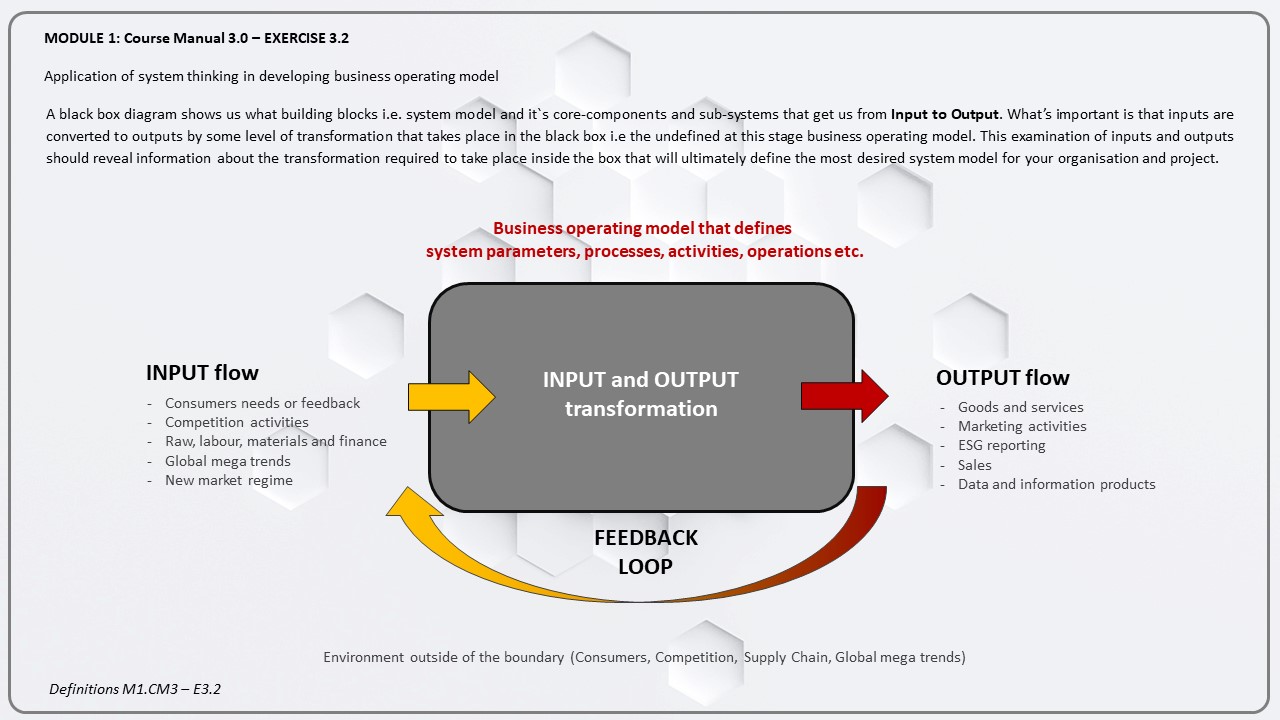
A black box diagram presented in Definitions M1.CM3 – E3.2 shows us what core-components and sub-systems get us from input to output. What’s important is that inputs are converted to outputs by undefined transformation that takes place in the black box ,i.e the undefined at this stage, business operating model. This examination of inputs and outputs should reveal information about the transformation process that will define your Project Road Map from the AS IS to the TO BE taking into consideration the 6 components of structuring the logical model that we will be defining for AS IS and TO BE timeframes in the next Modules. Pl short example to define your individual black box diagram and the group diagram as well.
Example: There are increasing concerns in México utilities sector regarding CO2 emissions, due to the use of fossil fuel-based electricity generation. Recently, several laws have been passed with the objective to increase the non-fossil, renewable energy sources to diversify the energy portfolio mix. Although several strategic funds and objectives have been established, these would be hard to achieve if investments should continue to be directed mainly to fossil fuel technologies to keep the supply at its current demand. This black box diagram presents the known inputs to support assessment of the AS IS and the development of the TO BE business operating model design requirements. The model is then developed further in detail and used to assess the difference between the AS IS (fossil fuels-based delivery) and TO BE multiple scenarios and requirements for generation of required capacity (based on 40% fossil fuels and 60% renewables or other % adjustment options). Template Module1.CM3-E3.3
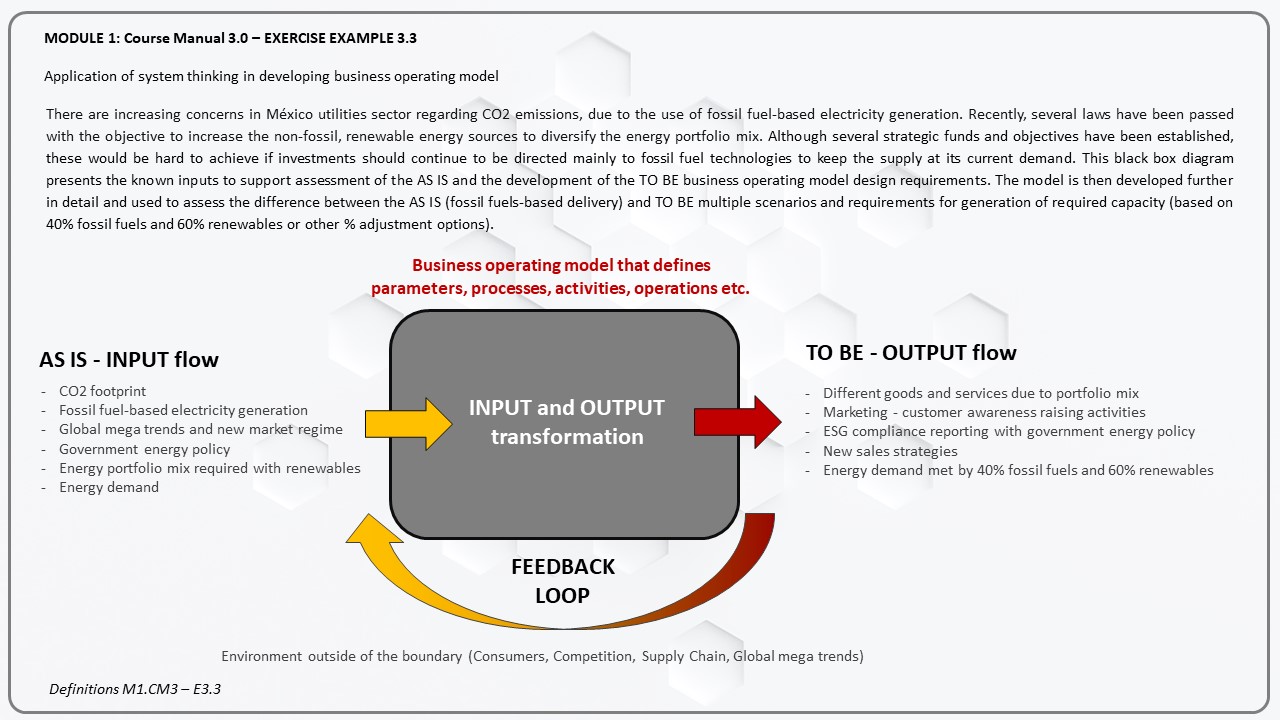
Using the examples of black box diagram above and the Template M1.CM3-E3.4 please apply the principles to your organisation.
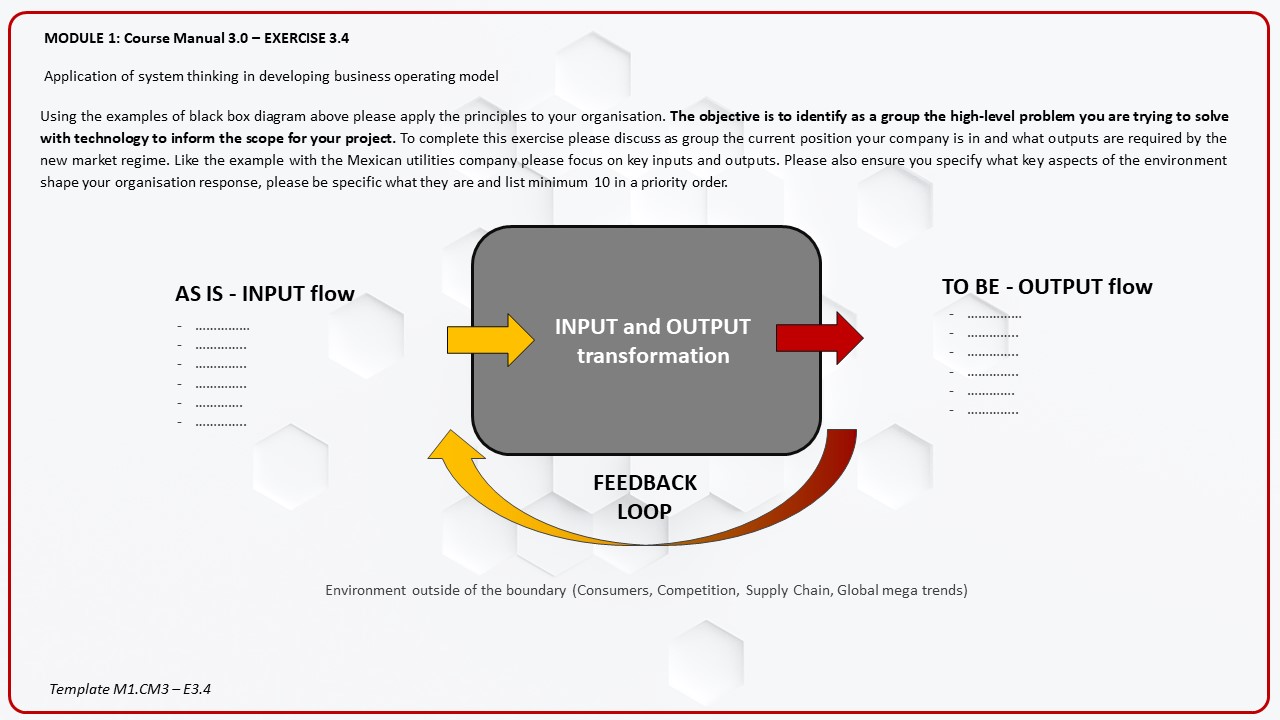
The objective is to identify as a group the high-level problem you are trying to solve with technology to inform the scope for your project.
To complete this exercise please discuss as group the current position your company is in and what outputs are required by the new market regime. Like the example with the Mexican utilities company please focus on key inputs and outputs. Please also ensure you specify what key aspects of the environment shape your organisation response, please be specific what they are and list minimum 10 in a priority order.

Course Manual 4: Change management and stakeholder Engagement
Stakeholder engagement for the purpose of Rapid Transformation System training is defined as the methods of communication to engage with external and internal stakeholders. By external stakeholders we mean customers, governments and regulators, investors, suppliers, academics or researchers, and any other business specific stakeholder who has a commercial relationship with the company. By internal stakeholders we mean CEO, board members, senior, middle, and functional management, employees, and any other business specific stakeholders who are directly employed by the company. Within organisations, stakeholders can also be further defined according to functional roles (Definitions M1.CM4 – CM1).
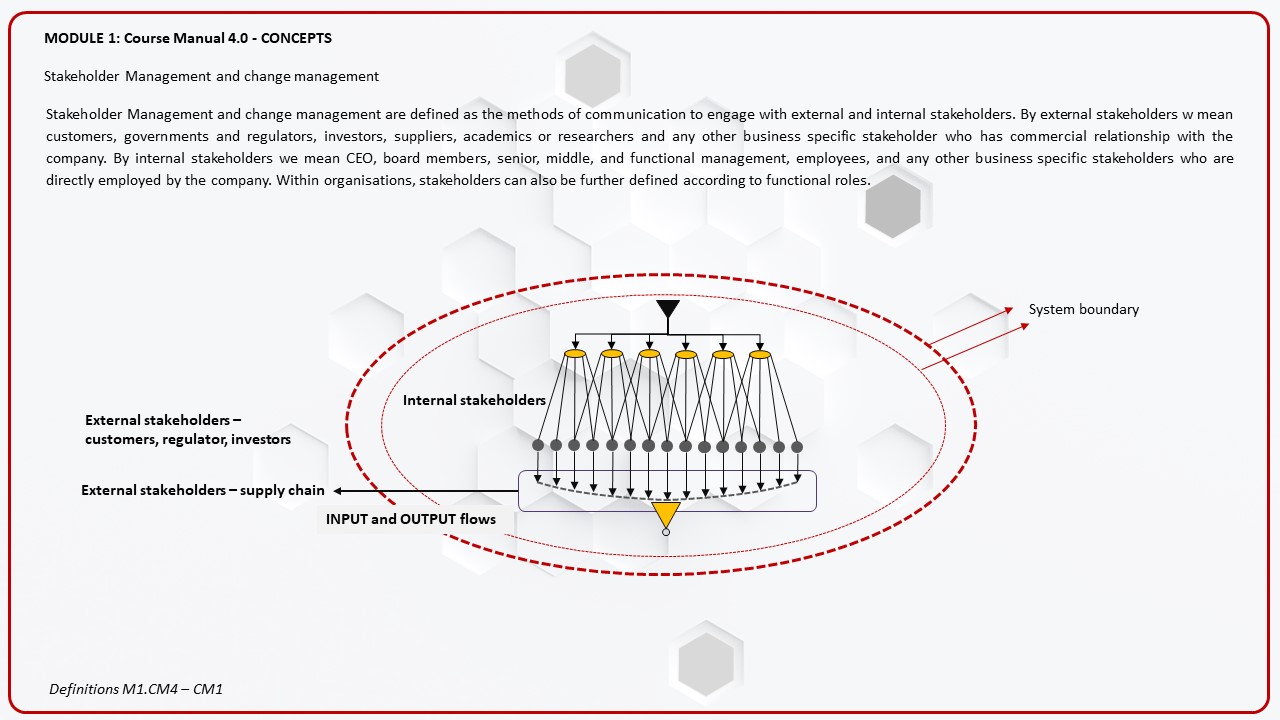
In your project you would be required to identify external and internal stakeholders relevant to your project. It would be very important to establish which aspects of their activities would be most affected by the digital transformation. Building meaningful relationships and understanding what matters most to them, what is their risk appetite, and willingness to adapt to change will give a baseline to identify how best to approach not only the design of the future state but also the change management and communication delivery plans. It is reasonable to desire meeting stakeholders’ expectations and ensure their positive interest in integrating digital technologies for better outcomes and benefits. In the process of stakeholder engagement, you would need to consider several leading questions that will give you an overview of their expectations. Which is what you are trying to filter out in the process of engagement. It would also very valuable to understand more about their reasons behind their actions.
In business the stakeholders generate the outcomes through their decisions, interactions, personalities, and motivations. Part of the analysis and mapping would be to ask yourself the question, “what is the stakeholders’ and our role here”? This is a very practical matter; only key stakeholders can be the part of this journey. You need to understand how they will collaborate and what rules will they use when they meet at the table to negotiate as it will give you an idea of what culture they bring to the table.
In the process of stakeholder engagement further questions should also be addressed. For example:
What costs could stakeholders incur when implementing digital transformation?
Who will pay for the technology and the integration programme?
What benefits will this project offer them?
What do I need from them? What are their needs and requirements?
To what extent I might be able to influence stakeholder’s behaviour?
How shall I communicate with different types of stakeholders, in context of my role in the organisation?
Do I know what is their “non-negotiable” position?
Do I know how far will they more from their AS WAS and AS IS position?
In previous modules you had a chance to identify the level of change required to move from one business model or business process to another and therefore stakeholders AS WAS and AS IS position. Furthermore, please do consider what change management approach would be most appropriate to your organisation. Below are ten change management options that you are most welcome to choose from or use to define a most suitable mix and match approach. Please ensure that you document the approach you chose and write a 500 words minimum statement “why” it is most suitable for your organisation.
David Rock’s SCARF Model
Using Neuroscience to Work Effectively with Others.
The SCARF Model was developed in 2008 by David Rock and well aligned to the digital transformation level of “extreme” change delivered at fast pace. SCARF stands for the five key “domains” that inf Gosha influence human behaviour in social situations. these are:
1. Status – our relative importance to others.
2. Certainty – our ability to predict the future.
3. Autonomy – our sense of control over events.
4. Relatedness – how safe we feel with others.
5. Fairness – how fair we perceive the exchange between people.
The model is based on neuroscience research that implies that this find domains activate the same threat and reward responses in the human brain that we rely on for physical survival. The limbic “primitive” brain reactions helps to explain the sometimes-strong emotional reactions in social situations and why it’s often hard to control them. Because they are instinct driven they cannot be just “turned off”.
For example, when we are left out of an activity, we might experience it as a threat to status or as rejection. Research has shown that this response can stimulate the same region of the brain ice physical pain. In other words, our brain is sending out the signal that we are in danger.
Furthermore, when humans feel threatened either physically or socially, the brain releases into the body the “stress hormone” cortisol that affects our creativity and productivity and stop us from thinking straight, which in return increases the feeling of being threatened.
On the other hand, when we feel rewarded the brain releases dopamine the “happy hormone”. When we are priced at work or at home our brains release further dopamine and of course, we want more and therefore we seek out ways to be rewarded again.
It has been clearly established in neuroscience research that when we feel threatened, the brain blocks creativity and productivity, reduces ability to solve problems, and makes it hard to communicate and collaborate with others. ironically these are precisely the skills and human capabilities that we need functioning to easily transform organisations to rethink concepts and the direction of travel. It is only when we feel reward that and safe, our self-confidence source we feel empowered and move forward.
The SCARF Model therefore addresses the key fight flight freeze or fawn response’s that our human brain experiences when exposed to change that in principle is often perceived by the human brain as threat.
The SCARF Model approach helps to minimise perceived threats, and to maximise the positive feelings generated through reward when working alongside others. In principle to maximise the sense of reward and to eliminate perceived threats for each domain of the SCARF Model the programme lead and the team need to identify how to eliminate threats and maximise awards. For example, micromanagement is the biggest threat to individual autonomy, therefore showing trust and people judgement by including them in decision making processes gives the participants more accountability, responsibility and encourages them to use initiative as well as give them the freedom to try out new ideas, which is precisely what is needed in the design of the “TO BE” future state.

1. Lewin’s Change Management Model
Lewin’s 3-Stage Model of Change, developed by Kurt Lewin, is an excellent approach during digital transformation prototyping stages and testing phase, as it breaks down core elements of change into more manageable chunks:
• Unfreeze
• Change
• Refreeze
The “unfreeze” phase could be setting the programme into motion and generating anticipation to start the journey so that everyone affected understands the need for change and that is being delivered. Then making changes and guide employees throughout the transition is the “change” stage. Once changes have been deployed and delivered organisation needs to solidify or “refreeze” the new status quo. What we call the Steady State that we will be looking into in Module 11. The Lewin’s Model often involves spreading out the “change/transformation” phase over a long period of time to overcome resistance and provide adequate training. This model is good when having a strong sponsorship and support from senior management and need to make organization- or team-wide changes.
2. Nudge Theory
Nudge theory relies on subtle, indirect suggestions that are backed up by providing evidence and contra evidence to the team or the organisation. The concept is that that “nudging” change is more effective than strictly enforcing change. Below are the basic principles of the model:
• Define changes
• Consider employee point of view
• Provide evidence to show the best options
• Present change as a choice
• Listen to employee feedback
• Limit options
• Solidify change with short-term wins
This model relies on the leadership of the digital transformation team to develop in advance options and scenarios to guide employees towards the solution management wants them to choose. Like a parent would with a child, this model guides the employees, while making them feel a part of the process of choosing and managing the change.
3. The ADKAR Change Management Model
The ADKAR Model is a bottom-up method created by Jeffrey Hiatt in 2003. It focuses on people behind the change and their core capabilities that need to be addressed to move from A to B. This is not a sequential method; it requires individual level of engagement with employees and additional management tools to help measure outside of the core digital transformation programme if people are taking the change on-board. The key acronyms are:
• Awareness (of the need to change)
• Desire (to participate in and support the change)
• Knowledge (on how to change)
• Ability (to implement required skills and behaviours)
• Reinforcement (to sustain the change)
Much like the Nudge theory, the ADKAR model values employee input and support that fosters their desire to participate in the re-think or re-design of the business model or process and then to commit to the implementation and benefits realisation that follows.
4. Kübler-Ross Change Curve
The Kübler-Ross Change Curve was defined by the psychiatrist Elisabeth Kübler-Ross and developed in the 1960`s. It is based on the five stages of grief and loss that humans experience when they need to let go of the past. Acknowledging that change is often met with emotional reactions rather than logic-based response, the method’s five stages are defined as follows:
• Denial
• Anger
• Bargaining
• Depression
• Acceptance
The difficulty with this method is that employees may move through these stages in a random order and even repeat or freeze in some stages. Therefore, the emotional human factors and the unpredictability of emotional change makes this framework ill-suited for large-scale deployments. The desired environment for this method is a small group as it allows to connect with employees on an individual level.

5. Bridges’ Transition Model
The Bridges’ Transition Model focuses on the emotional reactions throughout a transition from AS IS to the TO BE business model or the business process. The Bridges’ model narrows the emotional response by breaking it into three stages:
• Ending, losing, and letting go
• The neutral zone
• The new beginning
The concept behind this model is that change is a thing that happens in life, versus a transition, which is a journey people embark upon. By anticipating the denial, anger, and frustration that come with change, using this method the digital transformation team can better guide people towards the neutral zone, that is the bridge between the old and new way of doing things. Taking peoples personal feelings into consideration and management approach towards excitement and enthusiasm for new beginnings guarantees a higher acceptance rate.
6. Satir Change Model
The Satir Change Model developed by Wayne and Eileen Strider in 2019 monitors the emotional progression and what employees might naively expect by tracking their performance through five stages:
• Late status quo
• Resistance
• Chaos
• Integration
• New status quo
The model recognises a phase called “chaos” that reflects the anticipated negative reactions that generally accompany big changes. The Satir Change Model focuses on preparation for change but does not help to determine what changes need to be made or how they will be defined, therefore it`s best to be used only for reworking where the core process stays the same and only few components need to be revised. This approach acknowledges that many change initiatives are abandoned due to resistance, confusion, and lack of communication, however it does not provide guidance or a roadmap to reinforced and sustained change.
7. Kotter’s 8-Step Theory
Developed by Harvard Business School professor John P. Kotter in 1996, Kotter’s Theory for change management is divided into eight stages:
• Create a sense of urgency
• Build the change team
• Form a strategic vision
• Communicate the vision
• Remove barriers to change
• Focus on short-term wins
• Maintain momentum
• Institute change
Kotter’s 8-Step Change Model is well suited for large organisation and to build enthusiasm and initial momentum and to communicate the need for change by building a checklist that serves as a guide. However, this top-down model is generic in a sense that it does not include steps for employee feedback, so there is a risk that employees will resist the change and stall the process or leave the company as their needs have not been addressed.
8. Maurer 3 Levels of Resistance and Change Model
The Maurer 3 Levels of Resistance and Change Model centres on what causes changes to fail. Fortune 500 executives said that resistance was the primary reason changes failed. And 80 percent of the chief information officers said that resistance – not a lack of technical skills or resources – was the main reason why technology projects failed. This unique approach focuses on three critical levels of resistance:
• I don’t get it
– People are prone to rejecting what they do not understand. When employees do not fully comprehend the need for the change or the change itself, you’ve already set yourself up for failure.
• I don’t like it
– Emotional reactions can be a huge barrier to implementing change. If employees feel frustrated by or even fearful of the change, they are likely to dig their heels in and resist.
• I don’t like you
– You don’t need to be best friends with the people affected by the change, but if your employees do not trust your judgement and expertise, they may put up more of a fight. If you are confident and informed about the need for change as well as the process for implementing it, your employees will be more receptive.
According to Rick Maurer, the creator of this model, two-thirds of significant changes will fail due to three aspects: lack of information about what`s going to happen next, negative emotional reactions to change, and or lack of trust and confidence in the person or people trying to implement the change.
9. Deming Cycle (PDCA)
The Deming Cycle with Ishikawa’s changes can be traced back to S. Mizuno of the Tokyo Institute of Technology in 1959. This method developed by Dr. Williams Edwards Deming, is also known as the Plan-Do-Check-Act (PDCA) cycle and is used often in heavy industries as part of a continuous improvement process. This framework focuses on many sequences and cycles of process improvement as it is designed to work on a loop. It is divided into four phases:
• Plan
• Do
• Check
• Act
The four phases help you identify the issues that need addressing, tackle those problems through change, and keep the focus on the implemented changes to see if further action or adjustment is needed. This change management framework works best on a small scale in engineering environments for testing changes on a single team or department and tracking results before implementing changes company-wide.

Course Manual 4 Exercise: Stakeholder Engagement
It is essential at the beginning of any digital transformation project to well define stakeholders’ engagement and have a very clear strategy how to approach change at the transformational level. In this exercise I like to introduce key concepts and components of the stakeholder digital transformation journey. In this exercise we will analyse and contextualise your project from the perspective of discovering and communicating new concepts, through the “AS IS” baseline assessment to the design of the “TO BE” future state.
Please remember that your team will be leading the change and communication with internal and potentially external stakeholders hence understanding their motivations will be key to developing the most appropriate communication methods. The stakeholders generate the outcomes through their decisions, interactions, personalities, and motivations. Part of the analysis and mapping would be to ask yourself the question what is our stakeholders and our role here? This is a very practical matter; only key stakeholders can be the part of this journey. You need to understand how they will collaborate and what rules will they use when they meet at the table to negotiate as it will give you an idea of what culture they bring to the table to negotiate or what would they do when being faced by different aspects of the same problem. This will lead to establishing appropriate governance, building trust and gaining rapport for the project.
What do you show them, how will you build, and tell the story in the context of adapting to new market regimes by bringing new technology on-board, and about moving from “As is” to the “To be” future state, and how you will capture stakeholder’s imagination and commitment to change and how they will potentially respond to the changes that technology inevitably brings, will make it or break it?
Although at the beginning it might feel like you are going in different directions, we will also focus on how these key components of digital transformation fit together in asset intensive organisations and how they provide overall structure from the “AS IS”, through the design and prototyping of “TO BE”, development of the integration road map and the benefits realisation plans in the Course Manual 5.0.
That way we can track all relationships and roles changing along the journey to decide how to best communicate with stakeholders from the beginning of the project to the future state technology solution that will be adopted with ease. In that way everyone can follow team progress and have a control over the human factors.
In this exercise you would be required to create a 12-month project Road Map and a roles and responsibilities matrix of all stakeholders in your team and a list of internal and external stakeholders who would be involved directly or indirectly in this project (Template M1.CM4 – E4.1).
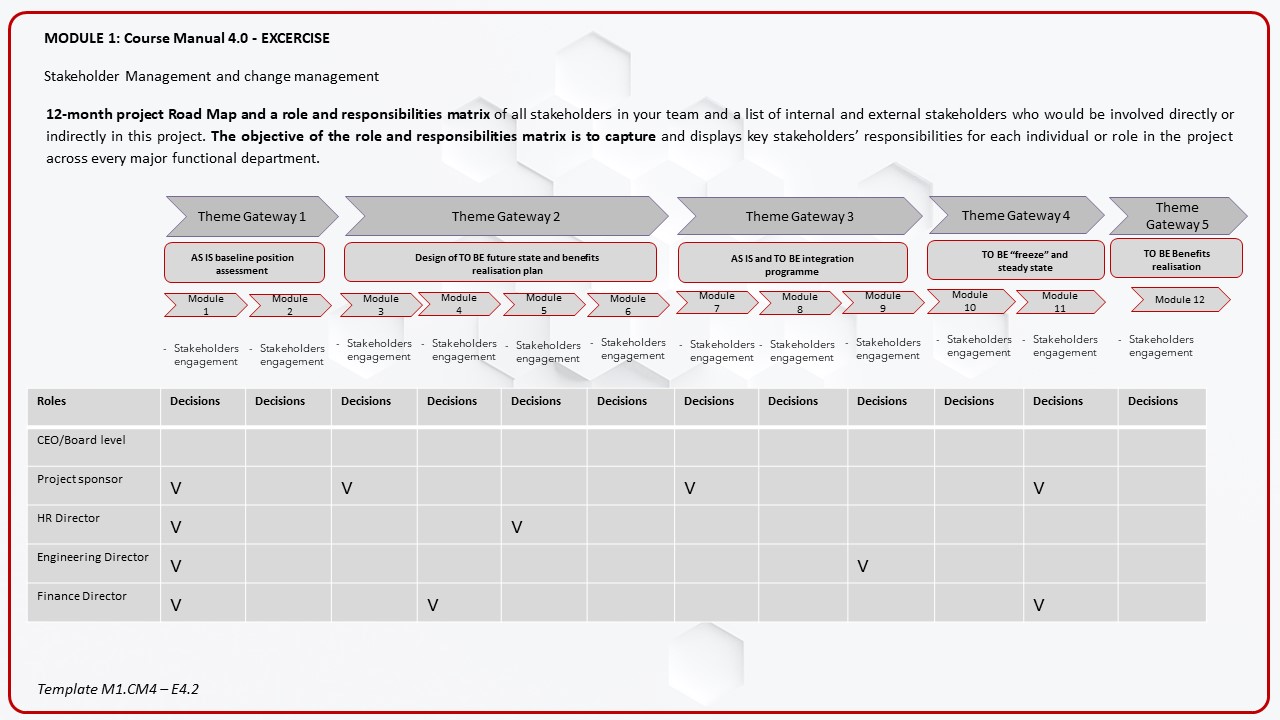
The objective of the role and responsibilities matrix is to capture and display the key stakeholders’ responsibilities for each individual or role in the project across every major functional department. The roles and responsibility matrix should also lay out on the Road Map the major activities in the project and precise details or each individual responsibilities and decisions they need to make whilst being involved in a project. It is an important project communication tool because all stakeholders can see clearly who to contact, and when, for each activity and deliverable. Projects vary in size, type, and organization therefore it is very important that you tailor this exercise to your organisation against the AS IS current organizational structure. The roles and responsibilities matrix should as a minimum include a project sponsor, project manager, team members, internal and external stakeholders like software providers and their key point of contact and key decision maker. In the matrix you should also include everyone’s job title and roles and responsibilities against an organisational chart. Please also add for each stakeholder a list of their objectives. This could be for example:
• Ensure that stakeholders understand the information once communicated.
• Influence behaviour of stakeholders to ensure desired outcomes.
• Develop a communications plan, defined change and transformation communications as well as the storytelling format for the campaign. For example: posters campaign, get together social events, walk-in centre to answer questions and provide further information or receive feedback from the business.
• Details on business procedures that outline how to obtain agreement and commitment from each type of stakeholder.
• Set up a change and transformation management helpline and employee’s support. This could be a confidential phone in helpline to resolve emotional challenges people will be going through or HR to advise on changes in roles that will potentially affect people etc.
• Details on who is responsible for payment authorisation and approval timescales before key milestones.
• Reporting to the project sponsor will be a key to the delivery of this project, hence knowing who, in what format, and how often needs to be prepared. Updates would be crucial to smooth running of the activities.
As a second aspect of this exercise, you would need to prepare as a team a 12-month Road Map for the project. This handy chart should illustrate on one page the five theme gateways as milestones of the Rapid Transformation Programme. These are:
Theme gateway 1: Module one and two – high level concepts and definitions of digital transformation, understanding current organisational position, setting up the project governance, and taking the AS IS assessment.
Theme gateway 2: Module three, four, five and six – high level concepts and definitions of concept thinking and design of the Target Operating Model, benefits realisation, planning and the “re-think and re-design” of the current AS IS position using the AS IS assessment as a baseline.
Theme gateway 3: Modules seven, eight and nine require development of detailed delivery programme in line with the project scope and stakeholders’ engagement plan as well as undertaking “test & integrate” activities.
Theme gateway 4: Modules ten and eleven – aim at introducing the “freeze” state of your desired technology solution to ensure its functionality. We will identify system monitoring parameters to stabilise the new design of the Target Operating Model.
Theme gateway 5: Module twelve is dedicated to benefits realisation and continuous improvement plan and will require final sign off from the senior stakeholders and the sponsors. Lessons learnt will consolidate overall feedback, key takeaways, and enable the organisation to develop an improvement plan post the program.
For each of the Theme gateways please create a sub-level one page Road Map with all activities you might have already identified from your course materials.
To summarise, your output for this course manual and exercise is to develop:
1. Identify external and internal stakeholders relevant to your project
2. Set up roles and responsibilities matrix
3. Identify stakeholder engagement questions to establish which aspects of their activities would be most affected by the digital transformation
4. Set up one page 12-month Road Map for the project with five theme gateways using Template M1.CM4 – E4.1
5. One page Road Map for each of the five theme gateways (Template M1.CM4 – E4.2)
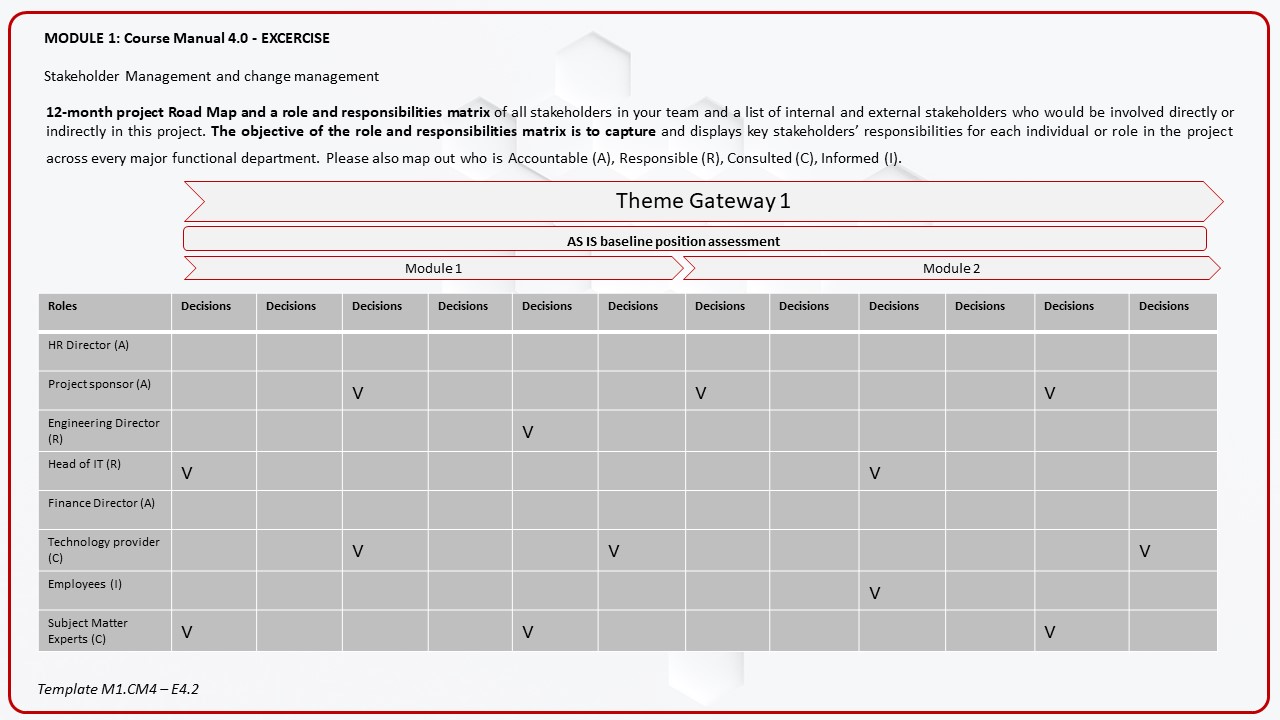
6. Please ensure that you select a change management approach by the end of this session and write a 500 words minimum statement “why” it is most suitable for your organisation.

Course Manual 5: Road Map from OM to TOM
This course Manual covers one of the most important aspects for turning ideas and concepts into reality. Planning of your project Road Map will enable you to capture high level activities for the whole programme journey from the outset. We will be using this method of planning extensively, to not only show how the digital transformation implementation is likely to develop over time, but also to predict and forecast different options and scenarios to inform preparation for the activities ahead of us. This could be, for example issuing change management communication plans two months in advance to enable stakeholders to engage and feedback their position that can then be negotiated towards desired outcomes. The benefits of managing high complexity digital transformation project with a Road Map are that it provides an overview and consolidation layer for any plans that sit underneath. It is an excellent tool to communicate key milestones with stakeholders as they are easy to understand, and simple to adjust when needed.
There are three strategic reasons why you need to have a roadmap for any digital transformation project. First, a project roadmap serves as an ongoing reminder of the project’s strategic objectives. This is important because as a team makes progress, the day-to-day realities will often change, in particular, when working with stakeholders’ expectations and market changes that can shift priorities and activities. These changes require project teams to rearrange the task-level plan, having an “at-a-glance” reminder of the high-level goals will help to make more informed decisions and keep the project on track.
Second, having a roadmap that is accessible to all stakeholders is to set their expectations and your negotiating baseline position earning buy-in and commitment to change.
Third, is that having a roadmap gives you the ability to quickly capture changes and therefore be able to update stakeholders such as executives and investors straight away, when being asked for a status update on a project. Senior stakeholders will not have the time to sit through workstreams or a task-by-task walkthrough. They will be interested in the strategic-level status and likelihood of completion of certain aspects of the project, which milestones have been delivered, or if the project is within the budget, etc.
Saying that, your roadmap should not change throughout the project otherwise you are getting into the “this is now a different project” territory meaning that your digital transformation efforts will not meet strategic objectives and benefits realisation will be severely compromised.
Roadmap principles
Your roadmap takes you towards your goal in milestones
You should have a long-term vision and objectives based on stakeholders’ expectations that outline what it is ultimately trying to achieve for them and the customers. For this project the roadmap should be broken down into the five RTS gateways, that will get you there. Please refer to Definitions M1.CM5 – CM1 for more detail.
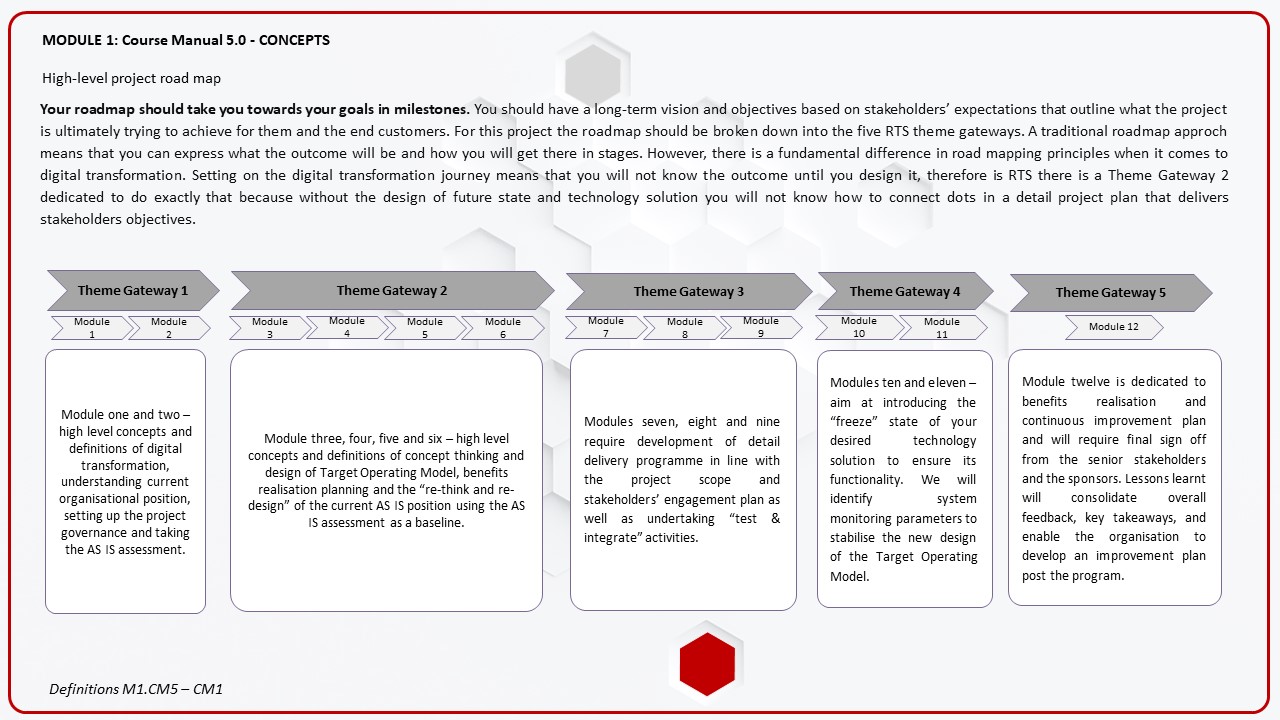
These are:
Theme gateway 1: Module one and two – high level concepts and definitions of digital transformation, understanding current organisational position, setting up the project governance and taking the AS IS assessment.
Theme gateway 2: Module three, four, five and six – high level concepts and definitions of concept thinking and design of Target Operating Model, benefits realisation planning and the “re-think and re-design” of the current AS IS position using the AS IS assessment as a baseline.
Theme gateway 3: Modules seven, eight and nine require development of detail delivery programme in line with the project scope and stakeholders’ engagement plan as well as undertaking “test & integrate” activities.
Theme gateway 4: Modules ten and eleven – aim at introducing the “freeze” state of your desired technology solution to ensure its functionality. We will identify system monitoring parameters to stabilise the new design of the Target Operating Model.
Theme gateway 5: Module twelve is dedicated to benefits realisation and continuous improvement plan and will require final sign off from the senior stakeholders and the sponsors. Lessons learnt will consolidate overall feedback, key takeaways, and enable the organisation to develop an improvement plan post the program.
A roadmap shows what you’re trying to achieve, does it though?
A traditional roadmap approach means that you can express what the outcome will be and how you will get there in stages. However, there is a fundamental difference in road mapping principles when it comes to digital transformation. Setting out on the digital transformation journey means that you will not know the outcome until you design it. Without the design of future state and technology solution you will not know how to connect dots in your detail project plan between AS IS and TO BE (Definitions M1.CM5 – CM2).
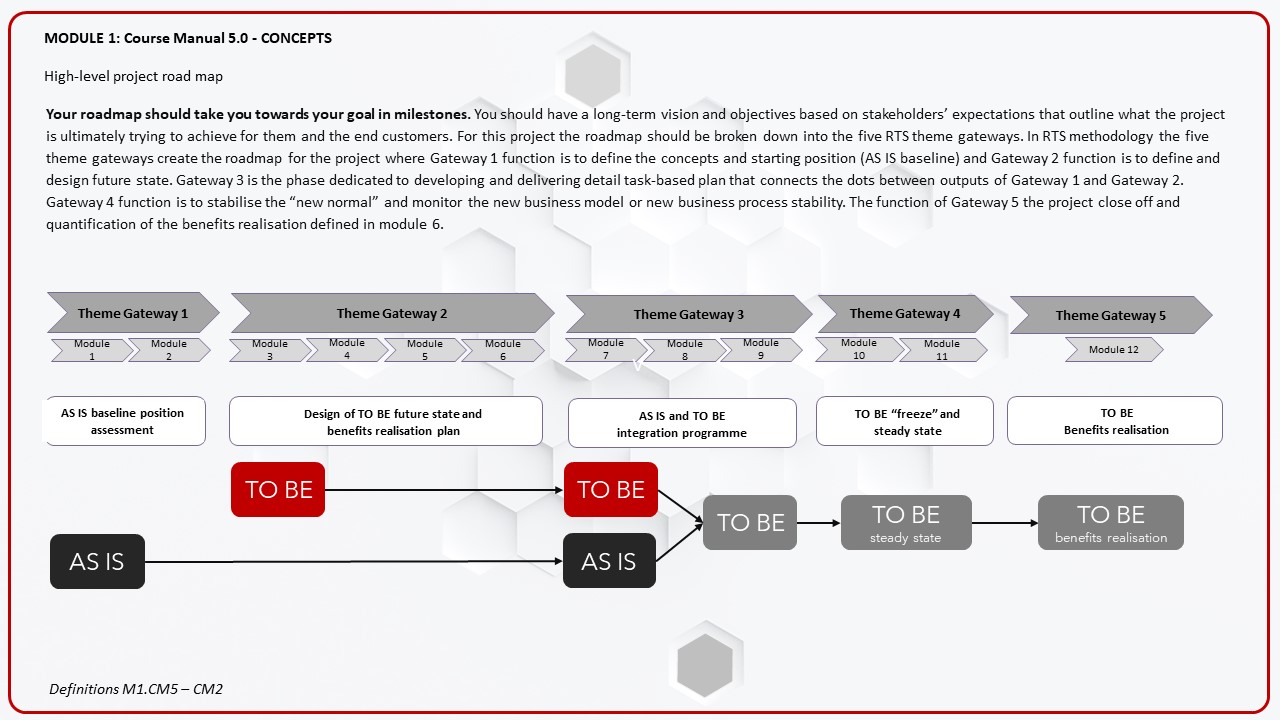
You will also not know what technology and in what quantities to procure and what would be the impact on the organisation, or you will not have a negotiating power to influence change management activities with the stakeholders. This is the key difference between traditional road map and programme approach and Rapid Transformation System. In RTS the five theme gateways create the roadmap for the project where Gateway 1 function is to define the concepts and starting position (AS IS baseline) and Gateway 2 function is to define and design future state. Gateway 3 is the phase dedicated to developing and delivering detail task-based plan that connects the dots between outputs of Gateway 1 and Gateway 2.
Each RTS theme gateway should have a sub-level roadmap.
Each RTS theme gateway has its sub-modules that will require a sub-level roadmap to portray the key milestones. Because we will be working on the concept level, until Gateway 3 the detail plan will not be required. Working on the concept level means that we will be defining the outcomes and the “what” but not planning their delivery. This level of roadmap should include phases and be timeboxed against our 12 months journey.
Sub-level road map iterations need to have clear objectives.
Each Gateway should have clear objectives that get you closer to achieving your long-term vision. There should be a clear goal each time (often a problem to be solved).
Sub-level roadmaps are developed iteratively and regularly.
Creating and iterating a theme gateway sub-level roadmap is something that would need to do collaboratively and led by the Project Lead. The iteration should take place after each module so you can inform next steps repeatedly. This is very much about creating and staying in the future state rather then looking back on what else needs to be done.
A roadmap should be open and accessible.
It is advised that you have a dedicated project team space if you can, or a digital hub to be able to exchange information with stakeholders or where they can access freely updates on what you are working on. Please always make sure you have a master version updated and ready to share with the wider business. It should be available to the business to view. You do not want someone to pull up an outdated version and incorrectly conclude or inform their decisions and falling short of promised deliverables or worst spending time on managing new set of expectations.
It needs to be easy to understand.
A roadmap should use simple visuals to make it easy and quick to understand with plain English key words that describe “what” you will do and not “how” you will do it. The “how” aspect is more of the plan territory of Gateway 3.
Develop roadmap before devising your project plan.
You need a well-thought-out set of strategic objectives for your project that arise from the outputs of the Theme Gateway 1 and 2. Initially you only need an overview of why you have decided on the initiative in the first place before you can break the project up into detailed meaningful workstreams and deliverables.
Use the roadmap for your project’s kick off.
When you pull together your project team for the first time, as well as starting to engage with stakeholders whose sign off you will need, presenting a project roadmap (instead of a more detailed plan) is a great way to make sure everyone understands the goals and value of execution and project timelines.

Course Manual 5 Exercise: Road Map from OM to TOM
Getting Started with Roadmaps
Strategic planning is an essential part of managing digital transformation projects and detailed project plans and activities to integrate the technology solution and successfully managed change and stakeholders’ expectations. A simple visual like a roadmap provides a clear overview of the strategic tasks and milestones and enables definition of the integration plan that can be then executed. Here are some resources to consider in planning the roadmap and to make it easier to start creating and managing your project roadmap.
• Building alignment through influence and communication
Project teams often are tasked with the impossible: they must influence their organization without much explicit authority to do so. In these circumstances achieving objectives requires building alignment through objectives, tasks, and consistent communication with stakeholders. These relationships are key as they inform the project team planning, communication, inform their strategies, and overall, provide better understanding of stakeholder’s expectations to inform decisions how to meet them.
• Alignment supports autonomy
Considering that digital transformation sits across several departments, therefore giving the project team autonomy to drive alignment of tasks and activities around the project roadmap is essential to the success of the project. The rest of the business also needs to be consulted and informed about the level of autonomy or delegated authority. Aligning business functions programme dependencies supports overall autonomy. When all parties understand the goals and challenges of their fellow colleagues, they can use that information to guide their own decisions and move effectively toward common goals.
• The value of project team autonomy
It is important that in developing the roadmap and project plan further down the line, the team has autonomy and can make project decisions. Autonomy empowers people to make their own decisions and move quickly toward desired outcomes. Autonomy also motivates the team to achieve and set their own and collaborative goals therefore increasing productivity and quality of outputs. The difference between outputs of teams that have autonomy or are micromanaged is significant. Therefore, as an organisation you would need to consider how to enable the project team to effectively action their plans so they can move swiftly through the year regardless of the size of the organisation. Often delegated authority can be used as a process that enables a person to assign a task to others keeping the programme moving or to perform several tasks and meet multiple deadlines.
• Implementing digital transformation solutions
A successful digital transformation launch involves more than just the project team. Implementing digital transformation solutions is a complex process that involves a myriad of different departments, tactics, and resources. A good measure for how much influence a project team has over integration of their future state design is when they determine that the solution is ready to launch. This is in part because a launch does represent the project team’s commitment and readiness for end user adaptation. That date also represents a commitment from the other parts of the business to have everything ready for deployment. It could be a commitment from the operations team to have all records gathered to transition to different system or for the finance team to have Purchase orders ready to pay for the software licences or the project sponsor to give the Go Ahead. Considering support from other business functions is essential for the planning of activities related to change management. They often require Human Resources engagement and marketing, or communications or events teams support to ensure human factors are addressed along the way and that resistance to change has been given appropriate level of attention. Depending on the change management approach selected for the project there is several side activities that can be helpful to run alongside the main roadmap and detailed delivery plan. These could be for example, providing training on emotional regulation and how to deal with change and stress, lunchtime yoga classes to provide relaxation opportunities, sponsor and/or key stakeholders “roadshow” to get the wider business engagement and to consult and inform about the project. It could also be providing a confidential helpline for employees to call if they are experiencing distress or need someone to talk things through. Appraisals, celebrating wins and any form of complement and genuine “thank you” to the whole team rather than to individuals goes a long way during transformation programmes.
This course manual exercise is dedicated to getting you started with planning of your 12-month activities. As an output you would need to develop high level road map constructed from the five RTS theme gateways and then further develop sub-level road maps for each Gateway (Definitions M1.CM5 – E5.1).
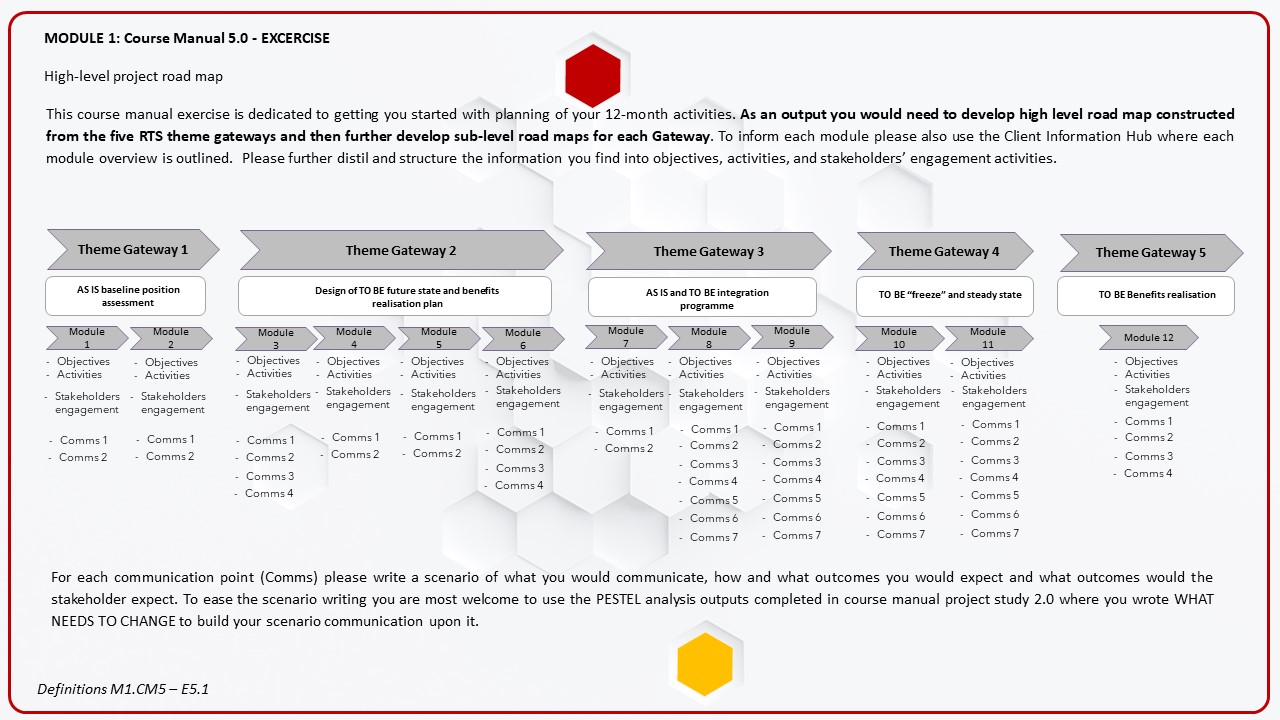
To inform each module please also use the Client Information Hub where each module overview is outlined. Please further distil and structure the information you find into objectives, activities, and stakeholders’ engagement.
Please use Microsoft Project or any other software available that you are familiar with for planning of these activities. The software needs to be capable of mapping, modelling, and editing dependencies among objectives, activities, and stakeholders’ engagement and workstreams.
In the process of road mapping for your project please ensure that key milestone include additional information points about critical communication with stakeholders and what needs to be communicated. Please also map out where in the programme the key stakeholders will have a say and will need to make a strategic, tactical, or operational decision.
For each communication point please write a scenario of what you would communicate, how and what outcomes you would expect and what outcomes would the stakeholder expect. To ease the scenario writing you are most welcome to use the PESTEL analysis outputs completed in course manual project study 2.0 where you wrote WHAT NEEDS TO CHANGE to build your scenario communication upon it.

Course Manual 6: Next Steps: Taking the AS IS Baseline Assessment
The objective of this course manual is to introduce you to the scope and preparations when taking an operating model assessment in the next module. Information and exercises in this manual will enable you to prepare for it not only in terms of consideration for what to look for but also to start gathering data and facts finding. The process of assessment is key to building foundations for your digital transformation journey. It is the natural starting point for the organisation to embark on the journey, the point that everyone knows and is more or less comfortable with. The assessment itself and the assessment components covered below are the same as the components that form the design of the future state providing strategic alignment. The AS IS model represents current status quo where the TO BE model represents the target state constructed of the following components Template M1.CM6-CM1/.
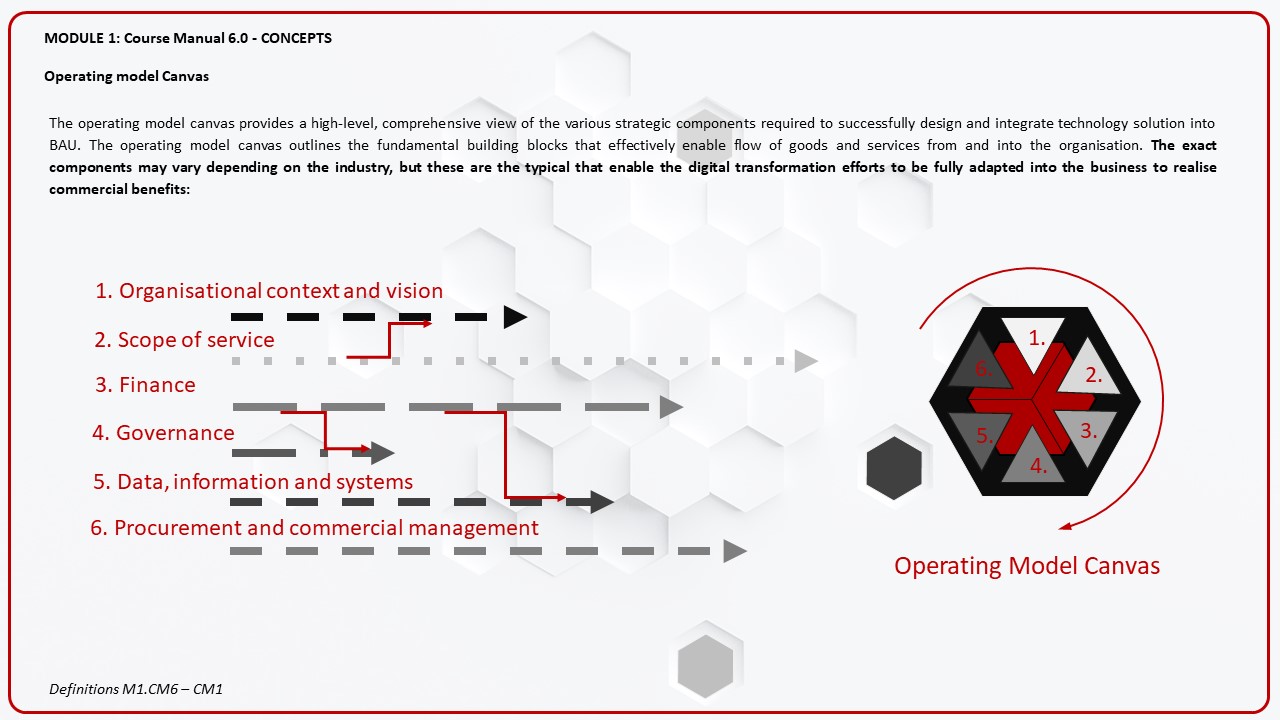
The strategic component approch enables therefore to align both AS IS and TO BE activities on the road map level and then develop detailed transition plan from A to B which we will focus on during the activities of theme gateway 3. Please remember that assessing and designing a business process or operating model is not a one-time activity, it is a continuous and evolving pursuit. Every component content will highly likely change during this 12-month programme, therefore having an excellent understanding of starting position will enable you to make decision how to approch the change management activities down the line and how to adapt them accordingly. Often over longer programmes people get promoted, change roles, leave the business and overall teams dynamics change so keeping eye on how the stakeholder’s landscape is evolving is a key to the meaningful and proactive communications.
Identify your scope for the project is equally important. You might only have an idea now of what you would like to change and what technology you would like to test and implement. It could be something from your current role or an idea that you are hoping to start from scratch. This module aims to give you background information to start formulating the context for your scope and to think about your desired technology solution. It is important to consider what would make the technology solution desirable for the organisation and how it would enhance its delivery and support customers as the result. These answers are best addressed after the assessment during the activities of Gateway 2 simply because the design of the process or business model would need to be built from a baseline position that informs successful implementation. The ideas and changes you might like to introduce can be as disruptive as much as the organisations wish to take on, however the transition and integration of technology must be designed carefully for the organisation to adapt it, hence focusing your efforts on understanding thoroughly baseline position. At this stage you don’t have to have a firm idea or a concept. We will develop it during activities of Gateway 2, it would be helpful however if there is a group consensus as to what technology you would like to try out, what would it do for the overall business and which business function(s) would need to implement it.
Assessing the baseline is a straightforward but not a small task. There are several requirements you would need to meet to ensure that the information gathered informs the overall project and the transition from AS IS to the TO BE. The verification and evaluation would require evidence and records to be collected by the team. Where questionnaires are used as part of an assessment they will at a minimum, include standard question set and indicative scoring criteria. The scoring element enables to identify areas of concern or where more or less effort would be required to support the stakeholders with delivering programme activities and objectives. This information will come handy in Theme Gateway 3 when the detail resource plan would be developed.
Assessment organizations may supplement question sets with their own material and assess additional areas of the business that they find need to be included in the overall baseline picture. For example, it is acceptable for assessment to include assessing in detail engineering processes specific to the industry that will be impacted by the changes technology will bring to that business unit. The exercise may also have objectives which are wider than an assessment baseline and it’s for the organisations to identify what that would be.
The assessment takes place against the core six components of operating model canvas that drive transformational change.
Therefore, examining them carefully not only gives you a starting position but also enables you to start considering them in terms of the future state design and the alignment between them. In particular the concept of ‘alignment’ or ‘line of sight’ will become mission critical once moving from AS IS to the TO BE. Template of Rapid Transformation System key components. Template M1.CM6-CM2

The alignment therefore is an important indicator of how well structured your project will be. The importance of “line of sigh” becomes a stabilising force itself when a relatively new model and its management system will take time to stabilise during Gateway 4 activities. How stable the new model becomes will indicate if a full set of benefits can be realised in Gateway 5. The alignment of AS IS and future state components should be therefore considered from the outset to confirm the organisation is developing, implementing, monitoring, and controlling these processes effectively.
The depth and coverage of the assessment should be sufficient to ensure that the findings are verified by factual evidence or, when relying on questionnaire responses, from a statistically robust sample or are provided by a qualified person or verified by a subject matter expert. The assessment for the baseline assessment should include a sufficiently wide selection of employees and sources to demonstrate a bigger picture of how the organisation operates and what are the rules it follows. The assessment aims to identify this both ‘horizontally’ across the organisation’s business functions and ‘vertically’ across the business organisational structure on the strategic, tactical, and operational levels. Considering a limited timescales and the scope of the undertaking the assessment can be tailored. In principle, the size and format of the assessment sample should be influenced by the project team and a business function involvement in the process.
Appropriate sampling should be used to provide confidence in findings that lead to scoring and inform future state design and all decisions required to design appropriate solution, purchase the desired technology, implement it, and continue extracting benefits from the new organisational solution. The sample size will also depend on the size and complexity of the organization. Typically, an initial assessment on a small project as this one should include 1-2 interviews with your key stakeholders that you have identified in Module 4.0. On a full-scale deployment of digital transformation programmes outside of training and classroom, the baseline assessment might require 20-40 interviews plus additional group sessions or surveys to verify more widely the findings of the interviews and data and information collected in that process. Assessment should use multiple sources of information to verify findings. This will include documentary evidence, data sources (such as performance measures), records, processes maps, service providers contract documentation, standard operating procedures, operating manuals, copies of standards deployed in the organisation from external sources as well internal standards developed by subject matter experts and should be supplemented with information recorded from interviews.

Course Manual 6 Exercise: Next Steps: Taking the assessment
To undertake meaningful and informed assessment we will use an operating model canvas that not only forms foundations for establishing the baseline but also the design of the future state. The operating model canvas provides a high-level, comprehensive view of the various strategic components required to successfully design and integrate technology solution into BAU. The operating model canvas outlines the fundamental building blocks presented in diagram Definitions M1.CM6 – CM1 that effectively enable flow of goods and services from and into the organisation. The exact components may vary depending on the industry, but these are the typical that enable the digital transformation efforts to be fully adapted into the business to realise commercial benefits:
1. Organisational context and vision
2. Scope of service
3. Finance
4. Governance
5. Data, information, and systems
6. Procurement and commercial contract management: Service and product performance
The function of the operating model canvas is to enable conversion of the strategic digital transformation objectives into operational design solution. These canvas components can also be used to convert the business corporate strategy into the re-design of the whole business operating model using digital transformation programmes at scale over long period of time. There are several canvas type templates on the market currently, however they do omit the fundamental building blocks of procurement, commercial and financial management that hold the solution together in particular where multiple supply chain stakeholders are involved. Furthermore, they do not introduce a structured approach to the design of the future state and technology solution leaving organisations in a position where it cannot identify the impact of the technology on the business, cost of change and is unable to develop effective communication plans that facilitate successful change management and integration.
In this 12-month project we will be using the operating model canvas extensively as the key components formulate the overall framework of alignment for various transition stages. We will use the canvas for collaborative sessions to design your technology driven new business process or model. To conceptualise the design and to communicate with key stakeholders to determine delivery and integration plans that are in line with the scope of this project.
The business operating model canvas in the context of this training serves three primary functions:
1. Structures thinking during the assessment and creation of the technology solution.
2. Is used as a business case document for the project.
3. Framing the outputs when communicating with stakeholders.
This is because behind the operating model canvas there will be a comprehensive summary of what the solution will do, who will use it, why they will use it, how it will happen, and how it works. The operating model canvas therefore is a blueprint translating project idea or the business vision with operating requirements. It also provides at a glance overview of core components interdependencies and answers the key questions of WHAT, WHO, WHERE and HOW.
Using the operating model canvas is very helpful to fully understand and develop the mechanics of the new solution, outside of day to day running of the operations and until the actual implementation. It enables to identify what design is needed as well as the impact of technology on the business functions and processes before deployment into BAU as shown in Definitions M1.CM6 – CM2.
The business model canvas can serve as a continually referenceable touchstone to keep stakeholders engaged along the roadmap and to update them on progress. It can also serve as a mission statement for the solution you will develop. As a communication tool, the business model canvas is an ideal document for senior stakeholder who do not need to know the detail. It can be used alongside the Road Map milestones as it contains from the beginning the most relevant information without the audience being drown in detail or distracted by supporting evidence. The canvas can also create a universal vocabulary for the project, and you can get everyone using the same language and concepts going forward to improve overall alignment. The canvas covers every aspect of the digital transformation solution that spans across the whole business therefore it relates to everyone in the organization. Using the operating model canvas the project team can communicate clearly what applies to different roles and how their work contributes to the overall effort of assessing, designing, developing, implementing, and integrating the digital transformation efforts.
To give you an opportunity to familiarise yourself with the key components of the operation model canvas for the exercise we will use the fish bone diagram to analyse the scenario below and to identify how these six components work together. You are most welcome to use hypothetical organisation or use your organisational chart to help to position the mapping of the operating model components within your organisational context. To add many asset or process focused organisations have a separate operations business function that in general seats under the Scope of service component of the operating model for both in-house and supply chain operations. Often the scope of operations is broad, and it depends on the organisation what is included. For example, engineering, transport, customer support or front of house could be all seen delivering the end-to-end process to the customer and therefore would fall under Scope of service component.
As an example of how the fish diagram can be utilised to break down complexity, imagine the following scenario: “Customer or the end user of your organisation receives insufficient customer support. The company receives repeated complaints that the end user doesn’t know how their issues will be addresses and that the customer service does not offer any help”.
Please do remember that the aim of the fishbone method is to create order, structure, and sequence to solve a problem. By classifying it into categories and subcategories, the problem becomes more tangible and can be solved more systematically. Despite the creativity needed, the method also requires a disciplined approach to reduce or distil the relevant issues to remain effective. Please see below guidance to get the best outcomes from using the fishbone method:
Step 1: Stating the problem
As a first step, the problem needs to be defined. In case of our scenario:
“Customer or the end user of your organisation receives insufficient customer support. The company receives repeated complaints that the end user doesn’t know how their issues will be addresses and that the customer service does not offer any help”.
The problem headline could be “Insufficient support”. However, the more detail is used to outline the problem, the more effective the fishbone diagram will be. Please use examples from your own experience to add to the scenario if needed to build up the story and narrative of the problem. This is a great opportunity to use creativity and imagination for problem definition and problem solving. Please use minimum of 300 words to outline the hypothetical problem in more detail or use example from your organisation.
Step 2: Defining the causes
Any organisation to some extent will have the challenge of dealing with customer support. In this case, please write categories of actual or hypothetical causes, which lead to this problem. Ask “Why does this happen?”. Again asks “Why does this happen?” about each cause. Write sub-causes branching off the cause branches up to 5 level down. This could be:
• Type of queries: simple queries, complex queries, co-related queries
• Processes: workflows and processes of the support team or the core business
• Resources: staffing of the support team
• Type of customer: new customer, loyal customer, returning customer
• Stakeholders: key figures of the support team and in other departments
• Finance: budget of the support team and in other departments
• Information: multiple systems with disjointed records
• Vision, mission, values: the team doesn’t receive positive feedback
Step 3: Match the causes with operating model canvas components
In this step, please create a fish bone diagram as per Template M1.CM6 – E6.1
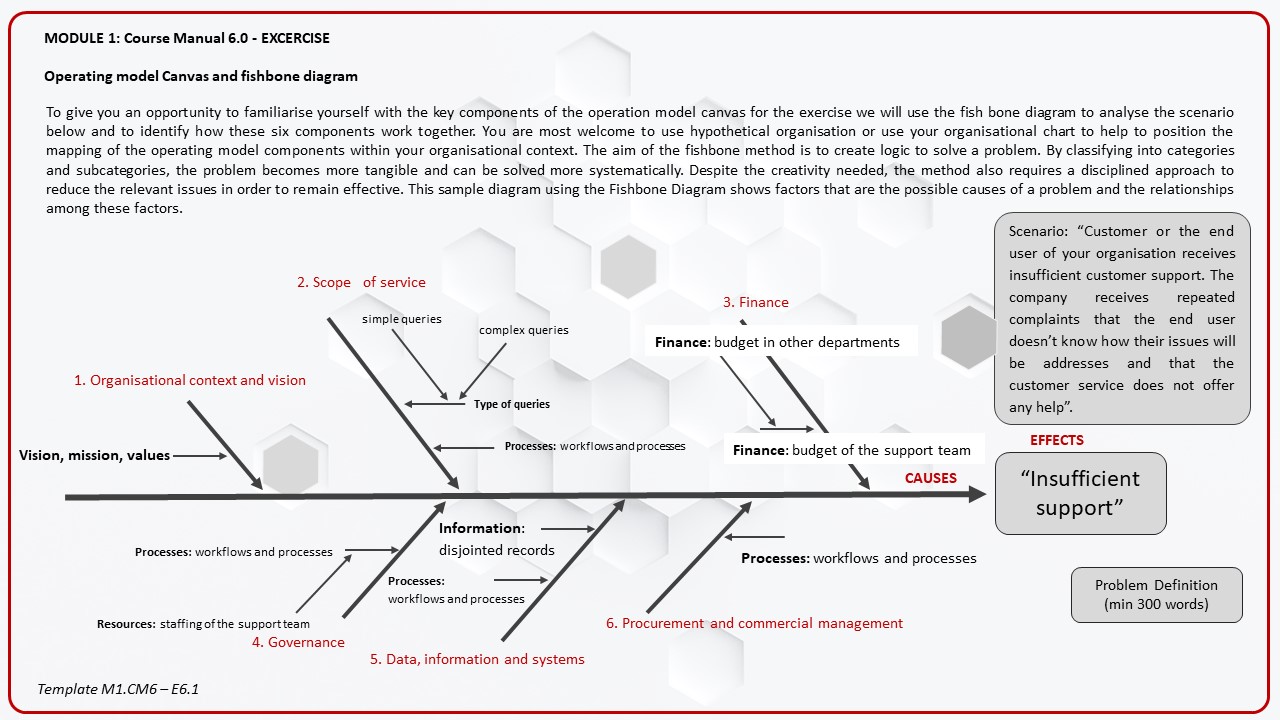
and assign the causes to the operating model canvas components. For example:
1. Organisational context and vision: Customer ethos, vision for the service
2. Finance: team budget
3. Governance: stakeholders, customers, support team
4. Data, information, and systems: information
5. Scope of service: service provided to the customer
6. Procurement and commercial contract management: Service and product performance: company contractual obligations to the end user, KPI`s
These operating model canvas components should form your basic structure of the fishbone diagram with the causes grouped and assigned to each component. Continues to ask “Why?” to generate deeper levels of causes and continue organizing them under related components and causes. This will help you to identify and then address root causes to prevent future problems.
Step 4: Stating the root causes
It is recommended to complete the fishbone diagram as a team. The team should be mixed with different expertise and backgrounds to get the best from this exercise and different points of view. For example, following cause could be identified “Lack of knowledge on the customer’s part” as well as “Rudeness of the customer”, “new customer unaware of the commercial obligations”, “disjointed data and information that take a long time to collect before update can be provided to the customer” etc.
When analysing the causes of the problem, further subcategories can be elaborated, and the level of detail determined as required until the problem or multiple problems have been identified. For example, the rudeness of the customers could be explained by excessively long waiting times on the hotline.
The value of using the fishbone diagram is to dig deeper, to go beyond the initial scenario, to better understand what in the organization’s systems and processes are causing the problem, so they can be addressed. In this example, the root causes of the customer complaints could be:
There is no process in place to ensure data is collected from various business units and provided to the customer services team so they can update customer on progress of their enquiry. Furthermore, new customers are unaware of the commercial obligations and expect answers straight away whereas KPIs is 10 days.
The root causes of the event illustrated in Template M1.CM6 – E6.2
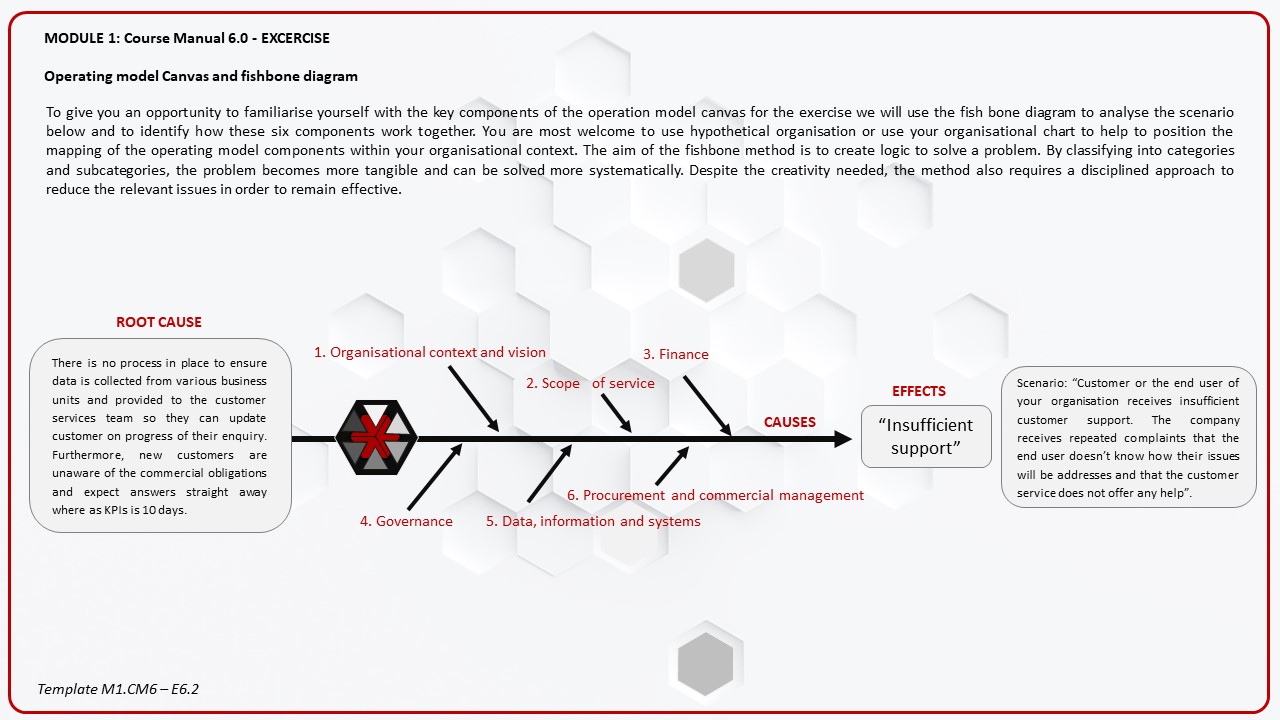
are the underlying process and system problems that allowed the contributing factors like communication to culminate leading to the customer dissatisfaction. As this example illustrates, there can be more than one root cause. Once you have identified causes and root causes you will then need to address each root cause.
Step 5: Setting priorities
In the best-case scenario, you will be able to see the causes of a specific problem emerging after creating a fishbone diagram. It is important not to concentrate on only one root cause of the problem, highly likely there will be multiple problems that cause customer dissatisfaction.
Step 6: Solve the root of the problem with technology
Once the root causes have been identified there is a clear picture where things are going wrong. To fix the problem a new or revised solution needs to be proposed. You can then map the root cause against the initial problem statement on the fish bone diagram as in Definitions M1.CM6 – E6.3
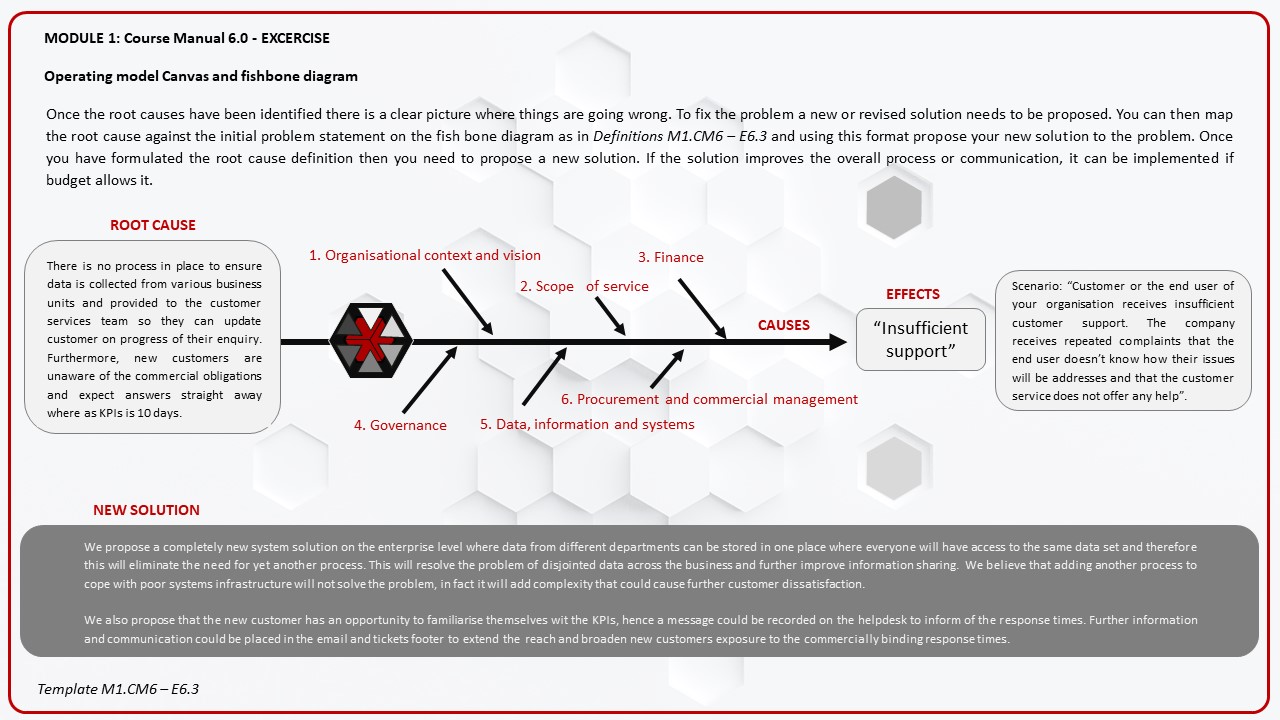
and using this format propose your new solution to the problem. Once you have formulated the root cause definition then you need to propose a new solution. If the solution improves the overall process or communication, it can be implemented if budget allows it.
Fixing the root cause should eliminate the issues. If the symptoms occur again, it’s time to return to the drawing board and conduct the exercise again.
Using the fishbone diagram and template M1.CM6 – E6.3 please propose how you would fix the problems using technology of your choice. You can create one chart or multiple charts that address each root cause and problem individually.
As an output from this exercise please provide as a team a summary report that follows the above format and include all the detail data and information you have produced based on your organisation experiences or the hypothetical scenario for each heading:
Step 1: Stating the problem
Step 2: Defining the causes
Step 3: Match the causes with operating model canvas components
Step 4: Stating the causes
Step 5: Setting priorities
Step 6: Fixing the problem with technology
Project Studies
Project Study 1.0: What is the AS IS and TO BE business operating model?
The objective of the Project Study is to formalise and consolidate your knowledge as a team and individuals. Therefore, you would require developing individual reports from this session as well as a consolidated team report. This learning technique of working as an individual and the team will become very important during the design and development of the future state solution. All reports have the same format and structure for the ease of alignment of human input into the Target Data Model structure. Please ensure you follow the templates’ structure to ensure all information is structured up front to enable us in the next modules to design and develop further detail against each category of the Target Data Model. This data management technique will also enable you to keep records, gather information and knowledge in a structured way. It will become very helpful when we will go back on it in the following modules to review the design and planning principles if we need to. It is highly likely that you might have to go back to review some of the information to develop further components of the Target Data Model and the delivery programme. It is therefore essential for the team representative to gather individual reports as well as the team consolidated report and save them on the company’s server in a dedicated folder. You would need to develop a folder and information gathering data structure that mirrors the Rapid Transformation System learning programme where you will need to store your outputs for each course manual against that delivery structure. The outputs check list is provided at the end of each Course Manual Project Study and the consolidated Project Study outputs are provided in the Workshop introduction.
The Project lead is responsible for provision of the detailed consolidated report based on the individual team members input reports. The team representative will be responsible for issuing the templates to team members and setting up a follow up meeting to review everyone’s findings and to evaluate as a group what the team would like to take forward to the next module and what would be saved in the shared location to build your project database. To complete the programme, you would need to think with that structure in mind as well as the digital transformation timescales, components, and their characteristics.
In this project study you would need to start applying the digital transformation concepts and their structure to your own organisation in readiness for the assessment in the Module 2.0. This evaluation and analysis process are therefore threefold and should be evaluated in the following order:
1. Digital transformation timeframes:
For each timeframe describe timescales you are considering including for your organisation and why they are important for you?
• AS WAS (PAST)
– Describe timescales you are considering for your organisation and why they are important for you?
• AS IS (PRESENT)
– Describe timescales you are considering for your organisation and why they are important for you?
• TO BE (FUTURE)
– Describe timescales you are considering for your organisation and why they are important for you?
2. Digital transformation timeframes, their components:
For each timeframe and component list 5-6 aspects that you would like to consider for your organisation in the assessment that will take place in Module 2.0. This could be organisational structure, IT capability, operational process you believe needs review and re-design in finance or any other business unit that affects your operations.
• AS WAS (PAST)
– Business operating model – list 5-6 aspects per each state.
– Market regime at the time – list 5-6 aspects per each state.
– Technology available at the time – list 5-6 aspects per each state.
• AS IS (PRESENT)
– Business operating model – list 5-6 aspects per each state.
– Market regime at the time – list 5-6 aspects per each state.
– Technology available at the time – list 5-6 aspects per each state.
• TO BE (FUTURE)
– Business operating model – list 5-6 aspects per each state.
– Emerging market regime – list 5-6 aspects per each state.
– Technology developments predictions – list 5-6 aspects per each state.
3. Digital transformation timeframes, their components, and their characteristics:
Like the analysis of the executive summary and the case study and using the structure of the templates provided earlier Template M1.CM1-E1
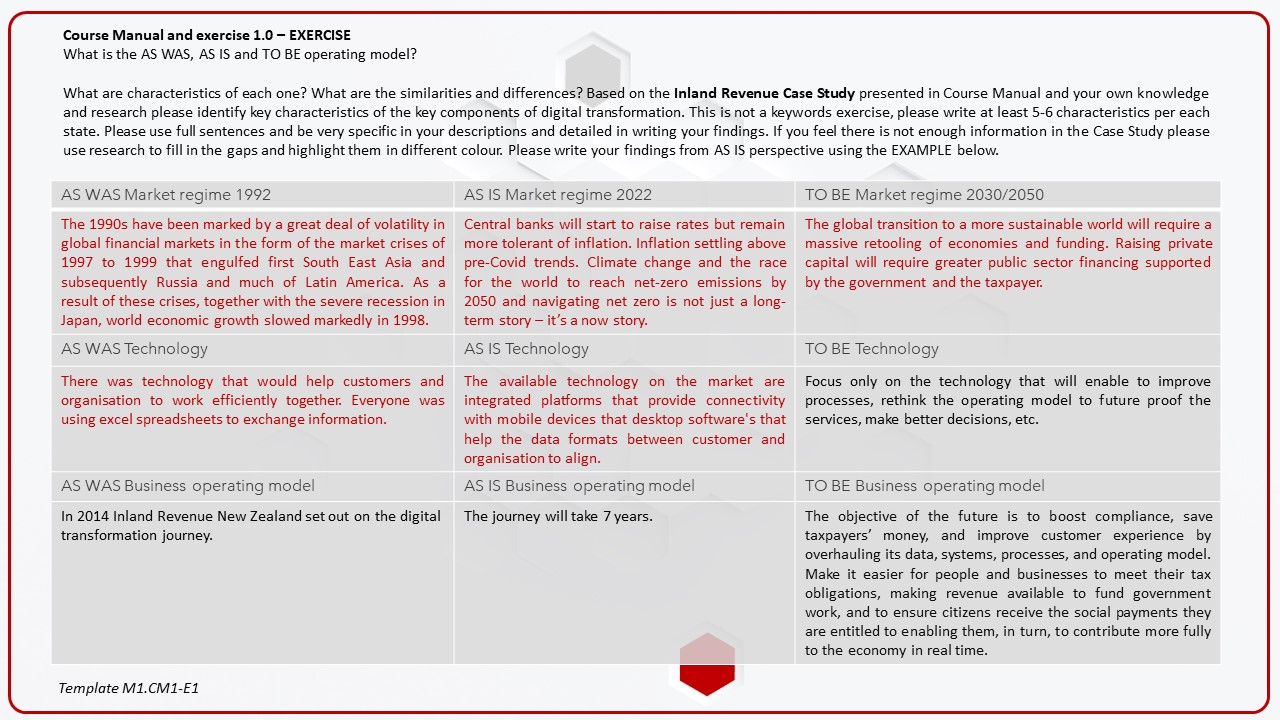
please describe in your own words your observations and characteristics about your organisation using a minimum 200 words each.
• AS WAS (PAST)
– Business operating model – 200 words minimum
– Market regime at the time – 200 words minimum
– Technology available at the time – 200 words minimum
• AS IS (PRESENT)
– Business operating model – 200 words minimum
– Market regime at the time – 200 words minimum
– Technology available at the time – 200 words minimum
• TO BE (FUTURE)
– Business operating model – 200 words minimum
– Emerging market regime – 200 words minimum
– Technology developments predictions – 200 words minimum
For the team report you would need to agree how are you going to consolidate everyone’s findings. Please ensure in the report there is a paragraph that captures what you have agreed. Please consider following aspects that will enable you to breakdown the complexity into manageable bite size chunks. For example, outline what are your key objectives for this project and how you would like to change your organisational processes. Consider how you are going to group the answers against each heading, what key questions are you going to ask to see what answers get you closer to meeting the objective? Please ensure that you develop as a minimum 10 questions for each heading below. Please find some examples of questions that might come useful to evaluate the individual responses:
• Digital transformation timescales.
– Q1: What timescales are realistic for your project? 1-2 years, 3-5 or longer?
– Q2: How would changes in the market affect your choices for the length of the project?
– Q3: If the project needs to be long, how would you deal with it?
• Digital transformation timeframes, their components.
– Q1: What parts of the business will be affected by the change?
– Q2: Who would need to be involved from different business units?
– Q3: What are the problem areas?
• Digital transformation timeframes, their components, and their characteristics.
– Q1: What are the objectives of your organisation?
– Q2: What are the customer needs?
– Q3: Want technology can the organisation afford?
TO DO check list:
1. Project Leader to set up RTS programme structure on the company shared drive.
2. Project Leader to set up analysis and review templates for the Project Study.
3. Project Leader to distribute the templates to the individuals.
4. Project Leader to set up an evaluation and review project team meeting with the goal to consolidate findings.
5. Project Leader to consolidate team consensus into one report. You are most welcome to use some of the examples provided and the visual outlook Template M1.CM1-PS1.
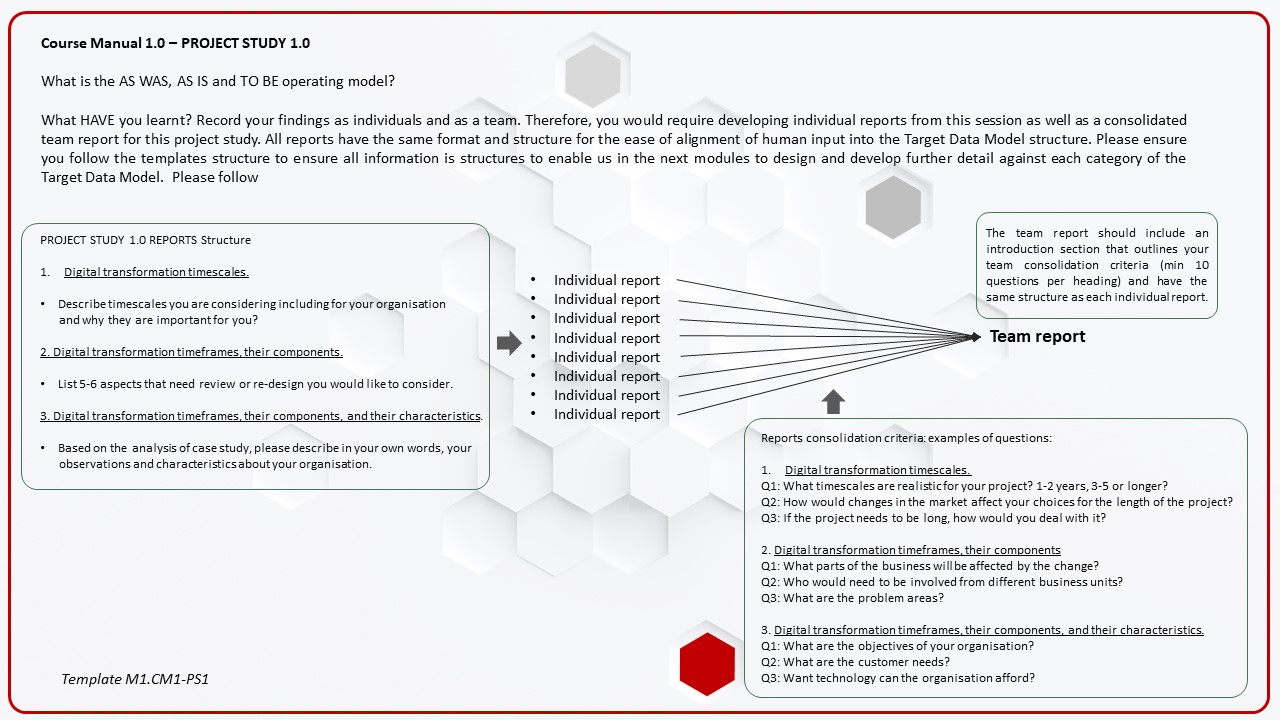
6. Project Leader to send individual reports and consolidated one to Appleton Greene for approval.

Project study 2.0: Identifying the context for your organisation and the project. What is the difference between OM and TOM?
The Project Study task of the course Manual 2.0 is covering the third aspect of shaping the context for the baseline assessment and the design of the “TO BE” future state that we will address in Module 3.0. In principle the objective of this exercise is to capture through mapping and analysis the actions that need to take place to transition from one business model into another using Template M1.CM2-PS2.1.
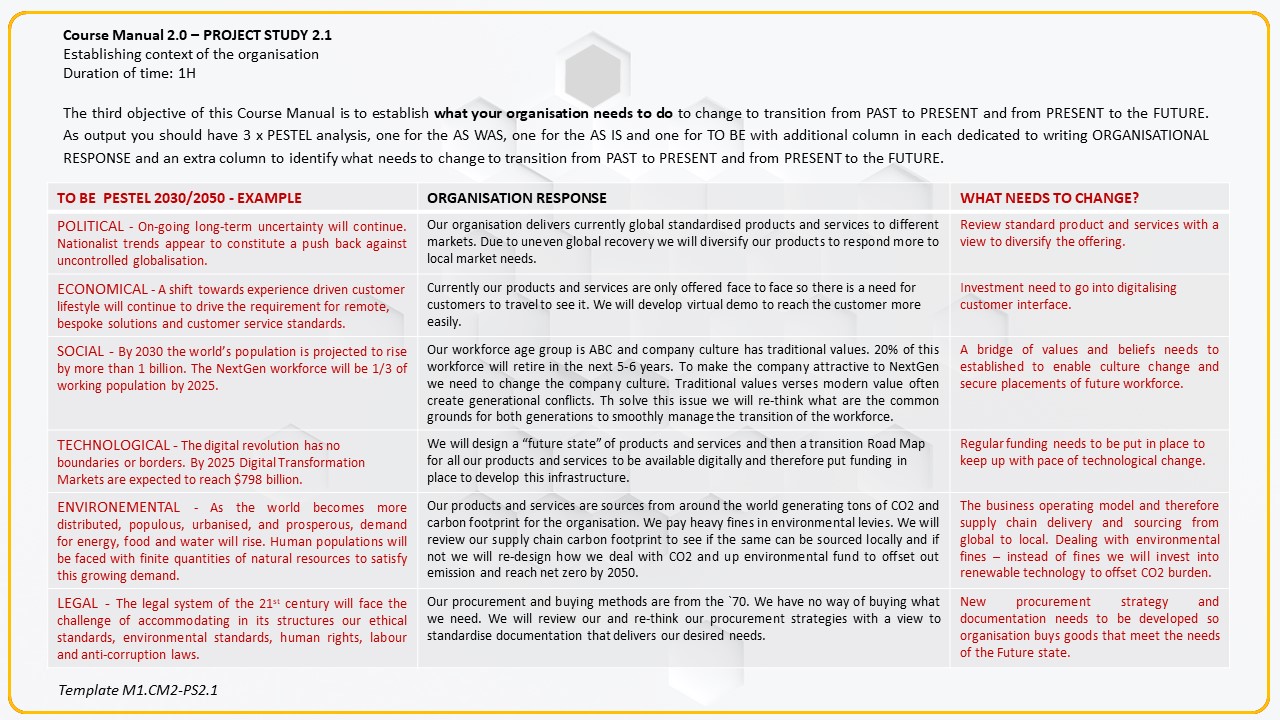
The objective here is to identify the change aspects itself. Being able to develop an appropriate level of granularity and detail relevant to your project will be essential during the planning phase (Module 7 to 10) of your delivery programme as it will define further the cost of change and the impact on the organisation. In this Project Study you can test the principles on how to define the change and scope the requirements of what actions need to be taken and what needs to be done to transition between business models.
The fact is that change management and transformation principles do not work in isolation but connect intentionally and systematically across various disciplines and components to enable effective adaptation of technology. Exploring this aspect of change management upfront of planning the digital transformation programme will enable you to gain a wider understanding on how human factors and efforts contribute, overlap, and align with the task, outcome and activity based digital transformation delivery programme. This could be for example:
• Defining change and placing it in the context of the organisation is one of the key objectives that enables engagement with people to the extent necessary for the change initiatives to succeed.
• Transformation efforts also support development and execution of comprehensive communication plans that enable integration of technology into day-to-day practises.
• Defining clearly change and developing an approach to how working with operational teams ensures that they have the best possible chance of delivering the expected benefits.
• Turning from benefits to specifying direct costs of change is equally important as it will need to be balanced against the benefits realisation in the ROI of the project plan.
• The level of change and the investment required to transform should be defined and costed upfront based on the activities that need to take place to move from one business model to another. Sponsors need to have a full understanding of the costs categories like training, technology, integration, licences etc to ensure critical costs to successful transformation and implementation of new business processes have not been missed.
The key to successful implementation is to ensure that a realistic and detail level of change has been identified from very early stages Even if it only starts at a high level, it means that you would have completed the 30% work needed upfront by learning about the concepts and developing high level understanding of the definitions. Furthermore, aspects of working with human factors and emotional change that enable individual and personal transformation are equally important. As with any discipline these days there is several options to choose from, several different change management models and theories offering a slightly different approach. It really depends on the type of change and the type of project you will be undertaking to decide the best change management solution. It doesn`t necessarily need to be one or the other, a mix and match approach that is tailored to your project can be equally successful. More information about your options is presented in Course Manual 4.0 related to stakeholders’ management.
Digital transformation brings to the table rapid and overwhelming level of change in the human mind terms. Selecting what works best for your project will require further investigation into what aspects of change your project would need to address, hence the Project Study warm up exercise. This Project Study module will help you to navigate difficult transitions milestones and guide you and the team towards more than acceptance but a desired full integration of your technology solution into business operations.
This Project Study objective is to establish what your organisation needs to do to transition from PAST to PRESENT and from PRESENT to the FUTURE. As output of this Project Study 2.0 you should have 3 x PESTEL analyses, one for the AS WAS, one for the AS IS and one for TO BE with additional column for each timeframe dedicated to writing ORGANISATIONAL RESPONSE. You should then allow for an extra column to identify what needs to change to transition from PAST to PRESENT and from PRESENT to the FUTURE. Please use Template M1.CM2-PS2.1 format and layout to create your own spreadsheets that you should save in the appropriate folder on your share drive. You could set up a spreadsheet for each timeframe of the PESTEL analysis or include them all in one document on separate tabs. Please ensure your document is formatted for printing and easily accessible for Appleton Greene to review.
TO DO check list:
1. Project Lead is to prepare drop down folder for this Project Study on the company shared drive.
2. Project Lead is to set up three Excel templates or one template with three tabs based on EXAMPLE Template M1.CM2-E2.2.
3. As a group you should develop based on the Template M1.CM2-E2.2; 3 x PESTEL analysis:
• one for AS WAS
• one for the AS IS
• one for TO BE
Each PESTEL timeframe should include a column dedicated to writing ORGANISATIONAL RESPONSE to the context of the times, minimum 200 words, per cell.
Further column then will be required to identify what needs to change to transition from PAST to PRESENT and from PRESENT to the FUTURE. Please write WHAT NEEDS TO CHANGE, minimum 300 words, for each aspect of PESTEL as shown in Template M1.CM2-PS2.1.
– Project Lead is to set up a outside of the class meeting to identify aspects of WHAT NEEDS TO CHANGE.
– Project Lead is to administer consolidation of the team consensus and save it on the share drive.
– Project Lead is to send the team findings template to Appleton Greene for review and approval.

Project study 3.0: OM and TOM components: 2H
Template M1.CM1-PS3
What HAVE you learnt? Record your findings as individuals and as a team. You would require developing individual reports from this session as well as a consolidated team report for this project study. All reports should have the same format and structure for the ease of alignment across the team. Please ensure you follow the Template M1.CM1-PS3
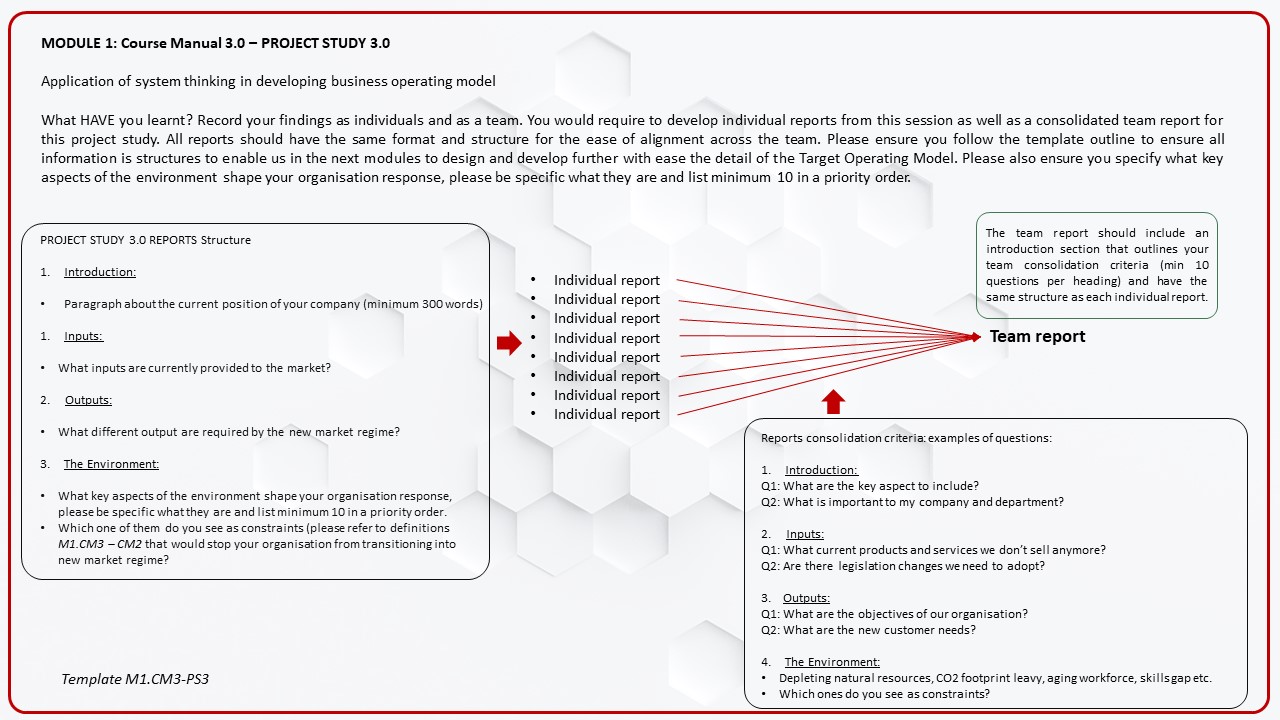
outline to ensure all information is structured to enable us in the next modules (Module 3,4,5 and 6) to design and develop with ease further detail of the Target Operating Model.
Outside of the classroom please be ready to discuss your individual position with a group. As an individual you would be required, as in the Project Study 1.0, to write your own report. We are keen to understand your individual perspective based on the role you have in the organisation, your expertise and business unit you are based at. To ensure we can collect, and digest information consistently please use the following format:
PROJECT STUDY 3.0 REPORT Structure:
1. Introduction:
• Paragraph about the current position of your company (minimum 300 words)
2. Inputs:
• What inputs are currently provided to the market?
3. Outputs:
• What different output are required by the new market regime?
4. The Environment:
• What key aspects of the environment shape your organisation response, please be specific what they are and list minimum 10 in a priority order. Key aspects of the environment that shape your organisation response to the market:
1. Depleting natural resources,
2. CO2 footprint levy,
3. Aging workforce,
4. Skills and knowledge gap etc.
• Which one of them do you see as constraints (please refer to definitions M1.CM3 – CM2) that would stop your organisation from transitioning into new market regime?
5. Depleting natural resources (Example only) – constraint: if non-renewable resources run out, we will not be able to trade as there will be nothing to sell.
6. CO2 footprint levy (Example only) – constraint: if we don`t do anything about reducing organisational carbon footprint and move towards more sustainable ways of working, there will be a levy to pay, and we will not be able to grow as a business.
Similar to the exercise in Project Study 1.0 shown in template M1.CM1-PS1, as a group, consolidate your findings by defining as a group evaluation criteria that show your selection and prioritisation process.
For the team report you would need to agree how are you going to consolidate everyone’s findings. Please ensure in the report there is a paragraph that captures what you have agreed and what decisions have been made. Please consider following aspects that will enable you to breakdown the complexity into manageable bite size chunks.
Reports consolidation criteria and examples of questions:
1. Introduction:
• Q1: What are the key aspects of the company position to include? Is it finance, is it sales, is it reviews and awards, operational excellence etc?
• Q2: What is important to the company and the department?
2. Inputs:
• Q1: What current products and services we do not sell anymore but used to sell in the past?
• Q2: Are there legislation changes we need to adopt?
• Q3: Do we know the performance of our supply chain?
3. Outputs:
• Q1: What are the objectives of our organisation? Are they the same as before Covid?
• Q2: What are the new customer needs?
• Q3: Do we know what our company “new normal” is?
4. The Environment:
• 10 key aspects of the environment selected by the team that shape your organisation response to the market:
– Depleting natural resources,
– CO2 footprint leavy,
– Aging workforce,
– Skills and knowledge gap etc.
• Which one of them does the group see as constraints (please refer to definitions M1.CM3 – CM2) that would stop your organisation from transitioning into new market regime?
1. Depleting natural resources (Example only) – constraint: if non-renewable resources that our business depends on run out, we will not be able to trade as there will be nothing to process and therefore nothing to sell.
2. CO2 footprint levy (Example only) – constraint: if we don`t do anything about reducing organisational carbon footprint and move towards more sustainable ways of working, there will be a levy to pay and we will not be able to grow as a business.
The team report should include an introduction section that outlines your team consolidation criteria (min 10 questions per heading) and have the same structure as each individual report.
This should be as follows:
1. Introduction:
• Team consolidation criteria including 10 key questions.
• Reason behind your selection. What did you as a team try to achieve?
2. Inputs:
• Based on your AS WAS and AS IS PESTEL analysis what are the 10 key inputs that affect your organisation?
3. Outputs:
• Based on your TO BE PESTEL analysis what are the 10 key outputs that affect your organisation?
4. The Environment:
• List 10 key aspects of the environment selected as a team that shape your organisation response to the market:
– Depleting natural resources,
– CO2 footprint leavy,
– Aging workforce,
– Skills and knowledge gap etc.
• Which one of them do you see, as group, as constraints (please refer to definitions M1.CM3 – CM2) that would stop your organisation from transitioning into new market regime?
– Depleting natural resources (Example only) – constraint: if non-renewable resources run out, we will not be able to trade as there will be nothing to sell.
– CO2 footprint leavy (Example only) – constraint: if we don`t do anything about reducing organisational carbon footprint and move towards more sustainable ways of working, there will be a levy to pay and we will not be able to grow as a business.
TO DO check list:
– Project Lead is to prepare drop down folder for this Project Study on the company shared drive.
– Project Lead is to set up master template for individuals and for the group.
– Project Lead is to distribute the templates to the individuals.
– Project Lead is to set up an evaluation and review project team meeting with goal to consolidate findings.
– Project Lead is to administer consolidation of the team consensus into one report as per structure provided above.
– Project Lead is to send individual reports and consolidated team report to Appleton Greene for review and approval.

Project study 4.0: Stakeholder Engagement
What HAVE you learnt? Record your findings as a team. Please further develop the role and responsibilities matrix and identify who of your stakeholders are accountable or responsible and develop each stakeholder or a group of stakeholder’s profile using the below guidance:
Accountability and Responsibility
The organisational role and activities are likely to be shared by many different people across the business, with different individual priorities. The person who makes decisions is likely to be different than the person who carries out the tasks and activities. Often this organisational matrix is complex in terms of engagement and obtaining consensus from the organisation. It is therefore a priority to establish who is Accountable and who is Responsible and who for what activity.
By Accountable (A) we mean individuals and groups who are personally answerable for the outcome of any decision. Individuals who have the authority to make important decisions or are budget holders with potentially significant outcomes for the business. They are likely to hold management positions at Director or VP level and above and can be held accountable for their decisions and their staff’s decisions.
By Responsible (R) we mean individuals and groups who complete required activities that will be defined as ‘Responsible’. They are likely to have authority to make day to day decisions in the normal course of their roles and can be held accountable for the outcomes of their decisions. They are likely to hold non-management positions or working-level management positions below Director.
There would be also another level of governance required to be established for people or teams who need to be Consulted or Informed about any changes that digital transformation programme brings.
By Consulted (C) we mean individuals and groups who may need to be consulted for their expertise and inputs.
By Informed (I) we mean people who need to know about activities where their support is required or will be affected by changes in the next stage of the programme.
For example, subject matter experts and departments who will need to support some of the change and transition activities would need to be Consulted. The task of Consulting or Informing stakeholders can be assigned as a specific Responsibility of the team member. People within an organisation who must be Consulted, must be assigned a formal Responsibility in the programme to contribute and ensure their commitment.
Both Consulted and Informed parties should be listed on the roles and responsibilities matrix as they often come from various business functions that need a separate communication plan. They could include top management, planning, finance, risk management, human resources, marketing, external communications, engineering, environmental management, information technology & facilities management, operations & maintenance, or procurement.
Furthermore, you would be required to develop as a group each stakeholder or a group of stakeholder’s profiles and analysis with minimum headings requirements stated below (Template M1.CM4-PS4).
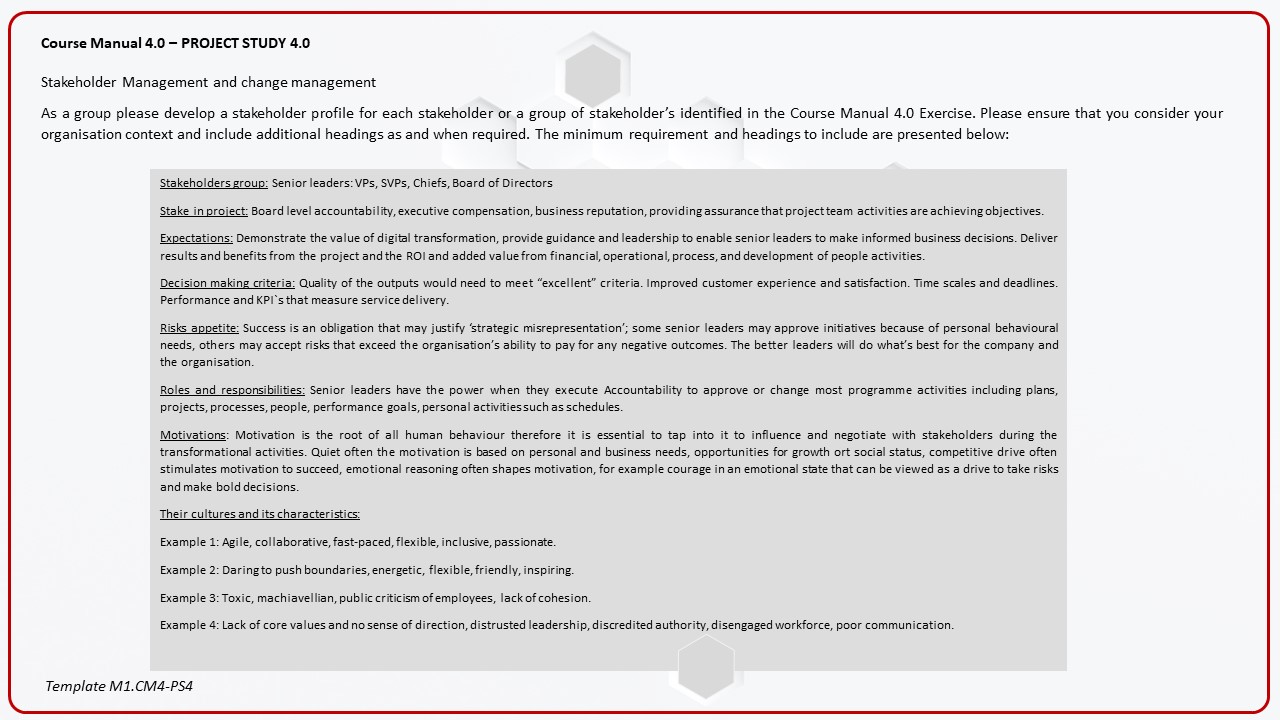
Please ensure that you consider your organisation context and include additional headings as and when required. You are most welcome to follow the example below:
Stakeholders group: Senior leaders: VPs, SVPs, Chiefs, Board of Directors
Stake in project: Board level accountability, executive compensation, business reputation, providing assurance that project team activities are achieving objectives.
Expectations: Demonstrate the value of digital transformation, provide guidance and leadership to enable senior leaders to make informed business decisions. Deliver results and benefits from the project and the ROI and added value from financial, operational, process, and development of people activities.
Decision making criteria: Quality of the outputs would need to meet “excellent” criteria. Improved customer experience and satisfaction. Time scales and deadlines. Performance and KPI`s that measure service delivery.
Risks appetite: Success is an obligation that may justify ‘strategic misrepresentation’; some senior leaders may approve initiatives because of personal behavioural needs, others may accept risks that exceed the organisation’s ability to pay for any negative outcomes. • The better leaders will do what’s best for the company and the organisation.
Roles and responsibilities: Senior leaders have the power when they execute Accountability to approve or change most programme activities including plans, projects, processes, people, performance goals, personal activities such as schedules.
Motivations: Motivation is the root of all human behaviour therefore it is essential to tap into it to influence and negotiate with stakeholders during the transformational activities. Quite often the motivation is based on personal and business needs, opportunities for growth or social status, competitive drive often stimulates motivation to succeed, emotional reasoning often shapes motivation, for example courage in an emotional state that can be viewed as a drive to take risks and make bold decisions.
Their cultures and its characteristics:
Example 1: Agile, collaborative, fast-paced, flexible, inclusive, passionate.
Example 2: Daring to push boundaries, energetic, flexible, friendly, inspiring.
Example 3: Toxic, Machiavellian, public criticism of employees, lack of cohesion.
Example 4: Lack of core values and no sense of direction, distrusted leadership, discredited authority, disengaged workforce, poor communication.
TO DO check list:
– Please ensure that you document all the outputs from this Course Manual as they will be required to inform further modules.
– Project Lead to prepare drop down folder for this Project Study on the company shared drive.
– Project Lead to set up master templates and version control protocols for the group.
– Project Lead to distribute the templates and set up a follow up project team meeting with goal to develop further below listed outputs.
– Project Lead to administer consolidation of the team consensus into one document for point 6 and 8.
– Project Lead to send team outputs to Appleton Greene for review and approval.
To summarise, your output for this course manual and exercise are to develop:
1. Identify external and internal stakeholders relevant to your project.
2. Set up roles and responsibilities matrix including RTS project team.
3. Identify stakeholder engagement questions to establish which aspects of their activities. would be mostly affected by the digital transformation.
4. One page 12-month Road Map for the project with five theme gateways.
5. One page Road Map for each of the five theme gateways.
6. Please ensure that you select a change management approach by the end of this session and write a 500 words minimum statement “why” it is most suitable for your organisation.
7. Further develop the role and responsibilities matrix and identify who of your stakeholders are accountable or responsible.
8. Develop each stakeholder or a group of stakeholder’s profile using guidance in the Project Study 4.0.

Project study 5.0: Road Map from OM to TOM
Project Study 5.0 aims to help you individually and as a team to build skills to break down complex stakeholders’ expectation and objectives, imagine and design the future state position and to enable connecting the dots on the AS IS baseline. This reverse engineering approach will help you to build an understanding of each digital transformation implementation timeframe at the roadmap level that you would need to define and deliver for your own project during the four modules of theme Gateway 3.
Referring to the case study below and the knowledge you have gathered about road mapping and the five theme Gateways of Rapid Transformation System please work back to develop a hypothetical roadmap that the international airport in the case study might have used to achieve their objectives.
Please remember that reverse engineering is a method in which one begins with a known finished outcome – as defined in the airport digital transformation case study and works backward to reveal the roadmap activities, objectives, and stakeholder engagement involved in the development of the digital transformation solution (Template M1.CM5-PS5).
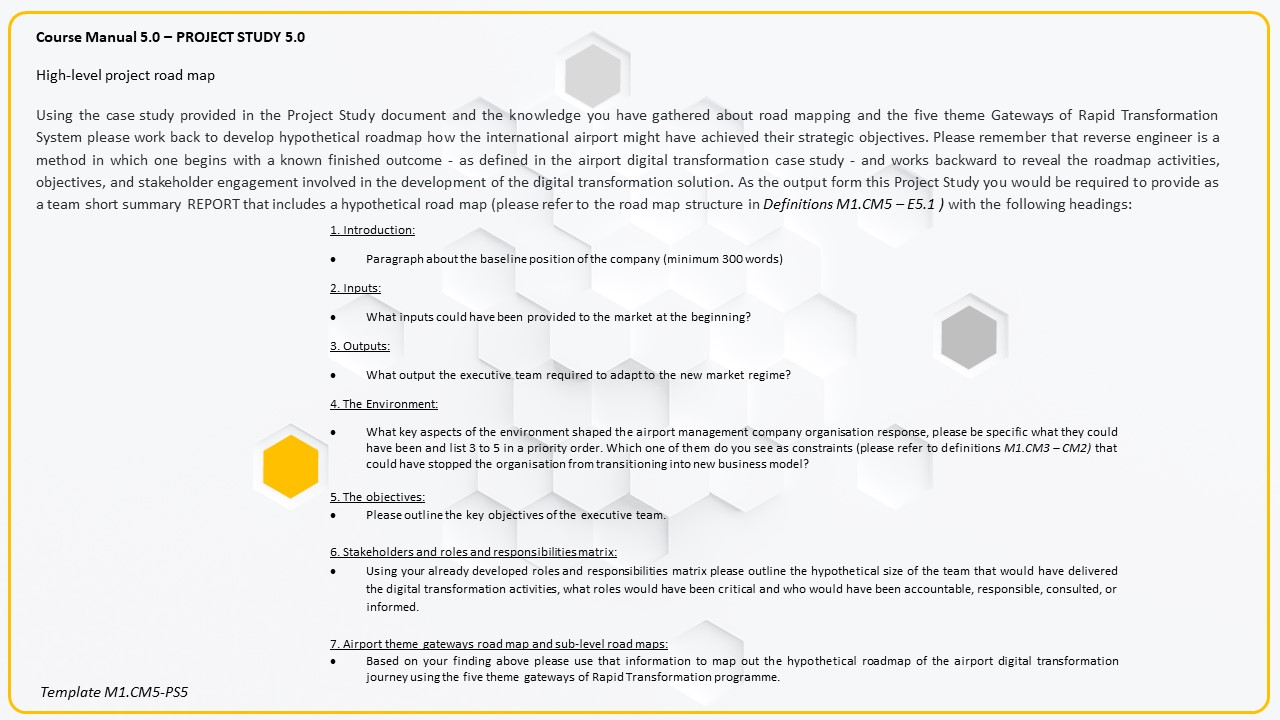
As the output from this Project Study, you would be required to provide as a team short summary REPORT with the following headings:
1. Introduction:
• Paragraph about the baseline position of the company (minimum 300 words)
2. Inputs:
• What inputs could have been provided to the market at the beginning?
3. Outputs:
• What output the executive team required to adapt to the new market regime?
4. The Environment:
• What key aspects of the environment shaped the airport management company organisation response, please be specific what they could have been and list 3 to 5 in a priority order. Which one of them do you see as constraints (please refer to definitions M1.CM3 – CM2) that could have stopped the organisation from transitioning into new business model?
5. The objectives:
• Please outline the key objectives of the executive team.
6. Stakeholders and roles and responsibilities matrix:
• Using your roles and responsibilities matrix developed earlier please outline the hypothetical size of the team that would have delivered the digital transformation activities, what roles would have been critical and who would have been accountable, responsible, consulted, or informed.
7. Airport theme gateways road map and sub-level road maps:
• Based on your finding above please use that information to map out the hypothetical roadmap of the airport digital transformation journey using the five theme gateways of Rapid Transformation programme.
Case Study: DIGITAL TRANSFORMATION IN AN INTERNATIONAL AIRPORT
The company manages operations for several of a country’s major airports. Following market evolution, the government demanded that the organisation reduces its dependency on a public subsidy that funded more than half of the firm’s operations. The challenge of converting a former government agency to a profitable company was made worse as economic challenges created by Covid-19 reduced air travel volumes and made airlines more aggressive in negotiating the fees they paid to the airport management company. To gain new revenues, the airport operator decided to transform its business model. The digital transformation journey therefore has been seen as a critical path to helping the firm reach financial autonomy.
The firm’s vision was twofold: first to gain efficiencies by unifying processes across airports, and second to focus on serving end customers instead of only the airlines. Implementing the transformation also required employees and stakeholders’ engagement to help them to adopt a more business and end customer-oriented mindset.
The transformation benefits have been identified from two strategic assets: the firm’s ownership of the airports and therefore control of how products and services are sold, and the employees’ collaborative culture that has been introduced during the unifying change management activities to create a more flat and overarching structure across all assets in scope.
After undertaking change management activities, the company focused on rationalising and integrating processes and IT infrastructure. It launched a digital transformation program owned by the board of directors that would coordinate and support the project team responsible for defining the customer experience, technology solution in line with stakeholders’ expectations. The objective of the program was to allow the airport management company to develop service where each customer would be provided with services wherever possible as they move through an airport.
The firm’s image of the desired future state was to increase revenues from fliers to overcome diminishing revenues from airlines achieved by improved customer experience. The airport management company planned to take advantage of a major change in customers’ behaviours: travellers are increasingly their own travel agents. In the world of self-service, the company believed it can help customers to reduce the stress of going to the airport, navigating traffic, checking in, and getting to the right gate through via website or mobile apps. The firm supplements its digital services with information agents present at the airport with tablets to support and guide travellers.
The firm invested further in apps with core business services like car rental, parking, and train tickets. The firm is also developing airline partnerships to provide airline tickets on the website.
This desired end-to-end process that supports the customer from door-to-door required a fundamental change of the business operational processes and the business model: The firm’s biggest operational challenge was to have one digital strategy and delivery plans for all its airports to provide every customer in every airport with the same services by consolidation and purchasing new platforms that could deliver the desired future state. It also made services such as drop-off or check-in available to the airlines, taking advantage of the interconnectivity of the firm’s digital platforms.
Digitisation of operational activities and processes has also improved and aligned the communication between employees and enabled knowledge exchange among airports teams. 75 percent of employees have been issued with mobile devices so they can support customers and log issues as they move through the airport. With the use of mobile devices staff can share their experience and to deliver a better service to the end customer. The firm has also launched a collaborative community platform to understand travellers’ experiences better and to be able to adapt its services. The company does not have a social media policy but has created guidelines. It encourages employees to be active on Facebook and Twitter to make the service team visible instead of the teams being anonymous and operating in the background.
Executives started with a clear vision based on gaining depleting revenues from the airlines and shifted focus to the customer experience. They have leveraged key strategic assets and then created governance and change management mechanisms to improve the chances of success. These leaders also started early to build digital transformation engagement with employees to change the firm’s culture that will enable them to integrate and implement the remaining elements of the digital transformation.
TO DO check list:
1. Project Lead to prepare drop down folder for this Project Study on the company shared drive.
2. Project Lead to extract from the Client Information Hub each module overview in readiness for the road mapping meeting.
3. Project Lead to set up a project team meeting with goal to develop:
– Your project high-level road map constructed from the five RTS theme gateways .
– Further develop sub-level roadmaps for each of the five theme Gateways. Each of the sub-level road map should have as minimum a workstream for objectives, activities, and stakeholders’ engagement.
– Once the high-level and each theme gateway road has been mapped out, please identify key milestones across the whole programme where critical communication with stakeholders needs to take place.
– For each communication milestone identified in the road maps please list at each milestone what decisions they will need to make on strategic, tactical, or operational level.
– Then for each milestone write a scenario of what you would communicate to the stakeholders, how and what outcomes you would expect and what outcomes the stakeholder might expect. To ease the scenario writing you are most welcome to use the PESTEL analysis outputs completed in course manual project study 2.0 where you wrote WHAT NEEDS TO CHANGE to build your scenario communications upon it.
4. The outputs from this exercise are:
• One high-level roadmap for your project with five theme gateways.
• 5 x sub-level road maps, one for each theme gateway.
• Key stakeholder communication milestones annotated onto all 6 road maps and a document with a list of all milestones and their description including decisions required at each point in time.
• Depending on how many milestones have been identified please develop several scenarios that are no longer than one-page A4 (font size 11 or 12) that cover:
– Milestone and its description including decisions required at the time.
– What you would communicate to the stakeholders.
– How would you communicate (e-mail, meeting, presentation, campaign etc).
– What outcomes you would expect.
– What outcomes do you think would the stakeholder expect?
5. Project Lead to administer consolidation of the team outputs from the Course Manual exercise 5.0 into one folder and as many documents as required using the structure provided above.
6. Project Lead to administer consolidation of the team outputs from the Project Study 5.0 into one folder with a short summary report based on the airport case study utilising the structure provided below. The team can add other headings they find valuable and important, however the format provided is to cover the minimum requirement to move to the next module:
Introduction:
• Paragraph about the baseline position of the company (minimum 300 words)
Inputs:
• What inputs could have been provided to the market at the beginning?
Outputs:
• What output the executive team required to adapt to the new market regime?
The Environment:
• What key aspects of the environment shaped the airport management company organisation response, please be specific what they could have been and list 3 to 5 in a priority order. Which one of them do you see as constraints (please refer to definitions M1.CM3 – CM2) that could have stopped the organisation from transitioning into new business model?
The objectives:
• Please outline the key objectives of the executive team.
Stakeholders and roles and responsibilities matrix:
• Using your roles and responsibilities matrix, please outline the hypothetical size of the team that would have delivered the digital transformation activities, what roles would have been critical and who would have been accountable, responsible, consulted, or informed.
Airport theme gateways road map and sub-level road maps:
• Based on your findings above please use that information to map out the hypothetical roadmap of the airport digital transformation journey using the five theme gateways of Rapid Transformation programme.
7. Project Lead to send the documentation to Appleton Greene for review and approval.

Project study 6.0: Next Steps: Taking the assessment: preparation
The fishbone diagram is an excellent method for breaking down complex problems. It provides consistent structure to identify causes and root causes against the operating model components. Outside of the classroom please be ready to analyse using the 6 steps process from the course manual exercise to identify causes for one or all three scenarios below. The requirement is to complete a minimum of one scenario. You are most welcome to propose a scenario from your organisation to address the problem you are trying to solve with technology. This exercise should be done as a group with individual team member’s input. To ensure the information is collected, and digested consistently please use the same format as before:
Step 1: Stating the problem
Step 2: Defining the causes
Step 3: Match the causes with operating model canvas components
Step 4: Stating the causes
Step 5: Setting priorities
Step 6: Fixing the problem with technology
Scenario 1:
The Mars Climate Orbiter was a 638-kilogram robotic probe launched by NASA on December 11, 1998. The probe was deployed to study the climate and the atmosphere of the planet and report on the changes of the surface conditions and relay them to the mission control. On September 23, 1999, communication with the spacecraft was permanently lost as it went into orbital insertion. The spacecraft encountered Mars on a trajectory that brought it too close to the planet, and it was either destroyed in the atmosphere or escaped the planet’s vicinity and entered an orbit around the Sun. An investigation attributed the failure to a measurement mismatch between two software systems: metric units by NASA and imperial or “English” units by spacecraft builder Lockheed Martin.
Scenario 2:
The Deepwater Horizon was an offshore drilling rig that encountered an explosion on April 20, 2010, and subsequently went on fire in the Macondo Prospect oil field 40 miles (64 km) southeast off the Louisiana coast. Deepwater Horizon was a floating semi-submersible drilling unit – a fifth-generation, ultra-deep-water, dynamically positioned, column-stabilized drilling rig. The platform was 396 feet (121 m) long and 256 feet (78 m) wide and could operate in waters up to 8,000 feet (2,400 m) deep, to a maximum drill depth of 30,000 feet (9,100 m). The US Coast Guard had issued pollution citations for Deepwater Horizon 18 times between 2000 and 2010 and had investigated 16 fires and other incidents. The Deepwater Horizon had other serious incidents, including one in 2008 in which 77 people were evacuated from the platform when it tilted and began to sink after a section of pipe was incorrectly removed from the platform’s ballast system. The explosion and subsequent fire on April 20, 2010 resulted in the sinking of the Deepwater Horizon and the deaths of 11 workers; 17 others were injured.
Scenario 3:
On 14 August 2018, the city of Genoa in northwest Italy woke to a strong summer storm. By 11.30am, the rain was so heavy that visibility had fallen dramatically. The Morandi bridge, crossing the Polcevera river in the centre of the city, was busy as ever, forming a vital section of the highway system connecting France and Italy. At 11:36 in the morning, a steel-enforced concrete cable stay broke and collapsed, taking a supporting tower and a 210m (690ft) section of the bridge with it. Vehicles cascaded to the ground. Apartment blocks beneath were crushed. The tragedy killed 43 people and left 600 homeless.
Cracks in the concrete meant that the steel inside the bridge began corroding soon after construction in when the bridge opened in 1967. By the late 1990s, the damage was so bad that Autostrade per l’Italia, the company managing most of Italy’s motorways, began to refurbish it. However, the Autostrade, which had been privatised and sold to the Italian fashion giant Benetton, failed to repair the pylon that subsequently collapsed. Another company, Spea, was in charge of inspecting Italy’s infrastructure. It too was owned by Benetton.
Before we start the assessment itself, you will need to gather data for analysis against the key six component of the operating model canvas. For each component of the operating model canvas please gather as a minimum following information to have ready to hand for the next MODULE 2.0. Below are the minimum requirements for the data you will need to bring to the next workshop:
• Organisational context and vision
Data requirements: documentation that covers company Vision, Mission statement and values statements or purpose statements if available. Strategy documents for asset management, data, information and system or commercial strategy would be an excellent place to start.
• Finance
Data requirements: this data is concerned with finding out how your company deploys into operations programmes, and management activities that require financial sign off. What process is followed to get business case approval and what does it need to include to get green light. What are the approval requirements and financial thresholds and how does the business deploy multi-stakeholder multi- business unit programmes.
Typically, the interest is in finding out how vision, mission and values are progressing from high level statements through more specific high level strategic policy objectives in line with the budgetary approvals to the programmes containing projects and related activities, that, taken together, are necessary to bring about the changes required to deliver the objectives.
• Governance
Data requirements: organisational structure diagram and individual business units’ diagrams are usually the best place to start. Please ensure that a diagram and a team chart per department are available to support developing the stakeholder engagement plans and roles and responsibilities matrix.
• Data, information, and systems
Data requirements: data and information management strategy and plans, IT platforms in place including key systems of the supply chain, information about data structures in place, master data model for the organisation (if available), data continues improvement plans, data governance policy and data lifecycle management procedures and operating manuals (remove, replace, acquire, maintain), records of the master data set behind the reporting structure including location of data sources and data dictionaries used for data management with the supply chain.
• Scope of service
Data requirements: list of service and product contracts in place, considering your idea for technology solution please select the contracts that currently define the area of concern. This could be a service provider contract and the IT provider contract that have written a specification that defines their scope of service and scope of works. This component is concerned with written documentation that provides instruction to the in-house team or the supply chain that is contractually binding or is a record of instructions issued to the relevant parties.
• Service and operations – commercial management and service performance
Data requirements: policy and operating procedures required for effective commercial management of contractual KPIs for the supply chain and in-house teams (1:1s frequency, what is the format how actions are recorded and followed up etc). In this component we are interested to know how performance of various parties is managed on day-to-day basis after commercial contracts have been awarded, what are the meeting frequencies, what is being discussed, how are the decisions recorded, who has access to this record, how are the actions followed up and what are the procedures to instigate should any issues arise.
TO DO check list:
1. Project lead to prepare drop down folder for this Project Study on the company shared drive.
2. Project lead to set up a follow up meeting with the following agenda:
– Agree a group consensus as to what technology the project team would like to try out, what would it do for the overall business and which business function would need to implement it. Please write a A4 one pager with font size 11-12 to summarise the team output.
– Complete the Course Manual exercise if it has not been finished in the classroom. Please develop a report or a power point presentation against the headings provided:
Step 1: Stating the problem
Step 2: Defining the causes
Step 3: Match the causes with operating model canvas components
Step 4: Stating the causes
Step 5: Setting priorities
Step 6: Fixing the problem with technology
3. As part of the Project Study 6.0 using the process presented in Course Manual exercise, please complete same level of analysis for one of the three scenarios provided.
4. Project lead to administer consolidation of the team consensus into one report as per structure provided above.
5. Project lead to support the team with data gathering as per Project Study 6.0 data requirements. The data should be stored in the Module folder against each component of the operating model canvas.
6. Project lead to send consolidated team documentation to Appleton Greene for review and approval.
Program Benefits
Finance
- Cost transparency
- Capital realization
- Accurate forecasting
- Strategic valuation
- Analytical capability
- Operational alignment
- Expenditure control
- Cashflow improvement
- Lifecycle budgeting
- Benefits realization
Operations
- Decision toolkits
- Decoded complexity
- Digital delivery
- Real-time accuracy
- Leveraged advantage
- Tasks automation
- Adaptation capability
- Quantifiable risks
- Streamlined operations
- Intended outcomes
Human Resources
- Digital attitude
- Quality decisions
- Scenario thinking
- Shared objectives
- Line of sight
- Mutual benefits
- Embracing change
- Problem-solving culture
- Together anywhere
- Empowered leadership
Client Telephone Conference (CTC)
If you have any questions or if you would like to arrange a Client Telephone Conference (CTC) to discuss this particular Unique Consulting Service Proposition (UCSP) in more detail, please CLICK HERE.


















